- CBSE Class 10th
- CBSE Class 12th
- UP Board 10th
- UP Board 12th
- Bihar Board 10th
- Bihar Board 12th
- Top Schools in India
- Top Schools in Delhi
- Top Schools in Mumbai
- Top Schools in Chennai
- Top Schools in Hyderabad
- Top Schools in Kolkata
- Top Schools in Pune
- Top Schools in Bangalore

Products & Resources
- JEE Main Knockout April
- Free Sample Papers
- Free Ebooks
- NCERT Notes
- NCERT Syllabus
- NCERT Books
- RD Sharma Solutions
- Navodaya Vidyalaya Admission 2024-25
- NCERT Solutions
- NCERT Solutions for Class 12
- NCERT Solutions for Class 11
- NCERT solutions for Class 10
- NCERT solutions for Class 9
- NCERT solutions for Class 8
- NCERT Solutions for Class 7
- JEE Main 2024
- MHT CET 2024
- JEE Advanced 2024
- BITSAT 2024
- View All Engineering Exams
- Colleges Accepting B.Tech Applications
- Top Engineering Colleges in India
- Engineering Colleges in India
- Engineering Colleges in Tamil Nadu
- Engineering Colleges Accepting JEE Main
- Top IITs in India
- Top NITs in India
- Top IIITs in India
- JEE Main College Predictor
- JEE Main Rank Predictor
- MHT CET College Predictor
- AP EAMCET College Predictor
- GATE College Predictor
- KCET College Predictor
- JEE Advanced College Predictor
- View All College Predictors
- JEE Main Question Paper
- JEE Main Cutoff
- JEE Main Answer Key
- SRMJEEE Result
- Download E-Books and Sample Papers
- Compare Colleges
- B.Tech College Applications
- JEE Advanced Registration
- MAH MBA CET Exam
- View All Management Exams
Colleges & Courses
- MBA College Admissions
- MBA Colleges in India
- Top IIMs Colleges in India
- Top Online MBA Colleges in India
- MBA Colleges Accepting XAT Score
- BBA Colleges in India
- XAT College Predictor 2024
- SNAP College Predictor
- NMAT College Predictor
- MAT College Predictor 2024
- CMAT College Predictor 2024
- CAT Percentile Predictor 2023
- CAT 2023 College Predictor
- CMAT 2024 Registration
- TS ICET 2024 Registration
- CMAT Exam Date 2024
- MAH MBA CET Cutoff 2024
- Download Helpful Ebooks
- List of Popular Branches
- QnA - Get answers to your doubts
- IIM Fees Structure
- AIIMS Nursing
- Top Medical Colleges in India
- Top Medical Colleges in India accepting NEET Score
- Medical Colleges accepting NEET
- List of Medical Colleges in India
- List of AIIMS Colleges In India
- Medical Colleges in Maharashtra
- Medical Colleges in India Accepting NEET PG
- NEET College Predictor
- NEET PG College Predictor
- NEET MDS College Predictor
- DNB CET College Predictor
- DNB PDCET College Predictor
- NEET Admit Card 2024
- NEET PG Application Form 2024
- NEET Cut off
- NEET Online Preparation
- Download Helpful E-books
- LSAT India 2024
- Colleges Accepting Admissions
- Top Law Colleges in India
- Law College Accepting CLAT Score
- List of Law Colleges in India
- Top Law Colleges in Delhi
- Top Law Collages in Indore
- Top Law Colleges in Chandigarh
- Top Law Collages in Lucknow
Predictors & E-Books
- CLAT College Predictor
- MHCET Law ( 5 Year L.L.B) College Predictor
- AILET College Predictor
- Sample Papers
- Compare Law Collages
- Careers360 Youtube Channel
- CLAT Syllabus 2025
- CLAT Previous Year Question Paper
- AIBE 18 Result 2023
- NID DAT Exam
- Pearl Academy Exam
Predictors & Articles
- NIFT College Predictor
- UCEED College Predictor
- NID DAT College Predictor
- NID DAT Syllabus 2025
- NID DAT 2025
- Design Colleges in India
- Fashion Design Colleges in India
- Top Interior Design Colleges in India
- Top Graphic Designing Colleges in India
- Fashion Design Colleges in Delhi
- Fashion Design Colleges in Mumbai
- Fashion Design Colleges in Bangalore
- Top Interior Design Colleges in Bangalore
- NIFT Result 2024
- NIFT Fees Structure
- NIFT Syllabus 2025
- Free Design E-books
- List of Branches
- Careers360 Youtube channel
- IPU CET BJMC
- JMI Mass Communication Entrance Exam
- IIMC Entrance Exam
- Media & Journalism colleges in Delhi
- Media & Journalism colleges in Bangalore
- Media & Journalism colleges in Mumbai
- List of Media & Journalism Colleges in India
- CA Intermediate
- CA Foundation
- CS Executive
- CS Professional
- Difference between CA and CS
- Difference between CA and CMA
- CA Full form
- CMA Full form
- CS Full form
- CA Salary In India
Top Courses & Careers
- Bachelor of Commerce (B.Com)
- Master of Commerce (M.Com)
- Company Secretary
- Cost Accountant
- Charted Accountant
- Credit Manager
- Financial Advisor
- Top Commerce Colleges in India
- Top Government Commerce Colleges in India
- Top Private Commerce Colleges in India
- Top M.Com Colleges in Mumbai
- Top B.Com Colleges in India
- IT Colleges in Tamil Nadu
- IT Colleges in Uttar Pradesh
- MCA Colleges in India
- BCA Colleges in India
Quick Links
- Information Technology Courses
- Programming Courses
- Web Development Courses
- Data Analytics Courses
- Big Data Analytics Courses
- RUHS Pharmacy Admission Test
- Top Pharmacy Colleges in India
- Pharmacy Colleges in Pune
- Pharmacy Colleges in Mumbai
- Colleges Accepting GPAT Score
- Pharmacy Colleges in Lucknow
- List of Pharmacy Colleges in Nagpur
- GPAT Result
- GPAT 2024 Admit Card
- GPAT Question Papers
- NCHMCT JEE 2024
- Mah BHMCT CET
- Top Hotel Management Colleges in Delhi
- Top Hotel Management Colleges in Hyderabad
- Top Hotel Management Colleges in Mumbai
- Top Hotel Management Colleges in Tamil Nadu
- Top Hotel Management Colleges in Maharashtra
- B.Sc Hotel Management
- Hotel Management
- Diploma in Hotel Management and Catering Technology
Diploma Colleges
- Top Diploma Colleges in Maharashtra
- UPSC IAS 2024
- SSC CGL 2024
- IBPS RRB 2024
- Previous Year Sample Papers
- Free Competition E-books
- Sarkari Result
- QnA- Get your doubts answered
- UPSC Previous Year Sample Papers
- CTET Previous Year Sample Papers
- SBI Clerk Previous Year Sample Papers
- NDA Previous Year Sample Papers
Upcoming Events
- NDA Application Form 2024
- UPSC IAS Application Form 2024
- CDS Application Form 2024
- CTET Admit card 2024
- HP TET Result 2023
- SSC GD Constable Admit Card 2024
- UPTET Notification 2024
- SBI Clerk Result 2024
Other Exams
- SSC CHSL 2024
- UP PCS 2024
- UGC NET 2024
- RRB NTPC 2024
- IBPS PO 2024
- IBPS Clerk 2024
- IBPS SO 2024
- Top University in USA
- Top University in Canada
- Top University in Ireland
- Top Universities in UK
- Top Universities in Australia
- Best MBA Colleges in Abroad
- Business Management Studies Colleges
Top Countries
- Study in USA
- Study in UK
- Study in Canada
- Study in Australia
- Study in Ireland
- Study in Germany
- Study in China
- Study in Europe
Student Visas
- Student Visa Canada
- Student Visa UK
- Student Visa USA
- Student Visa Australia
- Student Visa Germany
- Student Visa New Zealand
- Student Visa Ireland
- CUET PG 2024
- IGNOU B.Ed Admission 2024
- DU Admission 2024
- UP B.Ed JEE 2024
- LPU NEST 2024
- IIT JAM 2024
- IGNOU Online Admission 2024
- Universities in India
- Top Universities in India 2024
- Top Colleges in India
- Top Universities in Uttar Pradesh 2024
- Top Universities in Bihar
- Top Universities in Madhya Pradesh 2024
- Top Universities in Tamil Nadu 2024
- Central Universities in India
- CUET Exam City Intimation Slip 2024
- IGNOU Date Sheet
- CUET Mock Test 2024
- CUET Admit card 2024
- CUET PG Syllabus 2024
- CUET Participating Universities 2024
- CUET Previous Year Question Paper
- CUET Syllabus 2024 for Science Students
- E-Books and Sample Papers
- CUET Exam Pattern 2024
- CUET Exam Date 2024
- CUET Syllabus 2024
- IGNOU Exam Form 2024
- IGNOU Result
- CUET Courses List 2024
Engineering Preparation
- Knockout JEE Main 2024
- Test Series JEE Main 2024
- JEE Main 2024 Rank Booster
Medical Preparation
- Knockout NEET 2024
- Test Series NEET 2024
- Rank Booster NEET 2024
Online Courses
- JEE Main One Month Course
- NEET One Month Course
- IBSAT Free Mock Tests
- IIT JEE Foundation Course
- Knockout BITSAT 2024
- Career Guidance Tool
Top Streams
- IT & Software Certification Courses
- Engineering and Architecture Certification Courses
- Programming And Development Certification Courses
- Business and Management Certification Courses
- Marketing Certification Courses
- Health and Fitness Certification Courses
- Design Certification Courses
Specializations
- Digital Marketing Certification Courses
- Cyber Security Certification Courses
- Artificial Intelligence Certification Courses
- Business Analytics Certification Courses
- Data Science Certification Courses
- Cloud Computing Certification Courses
- Machine Learning Certification Courses
- View All Certification Courses
- UG Degree Courses
- PG Degree Courses
- Short Term Courses
- Free Courses
- Online Degrees and Diplomas
- Compare Courses
Top Providers
- Coursera Courses
- Udemy Courses
- Edx Courses
- Swayam Courses
- upGrad Courses
- Simplilearn Courses
- Great Learning Courses
Diversity In India Essay
Diversity in India is a remarkable phenomenon, one that has been celebrated since ancient times. It is a country where different cultures, religions, languages, and traditions coexist in harmony, reflecting its traditional adage of ‘unity in diversity’. India is home to a plethora of different ethnicities, languages, religions and cultures, each with its own unique set of customs and beliefs. Here are a few sample essays on the topic ‘Diversity In India’.
100 Words Essay On Diversity In India
200 words essay on diversity in india, 500 words essay on diversity in india.
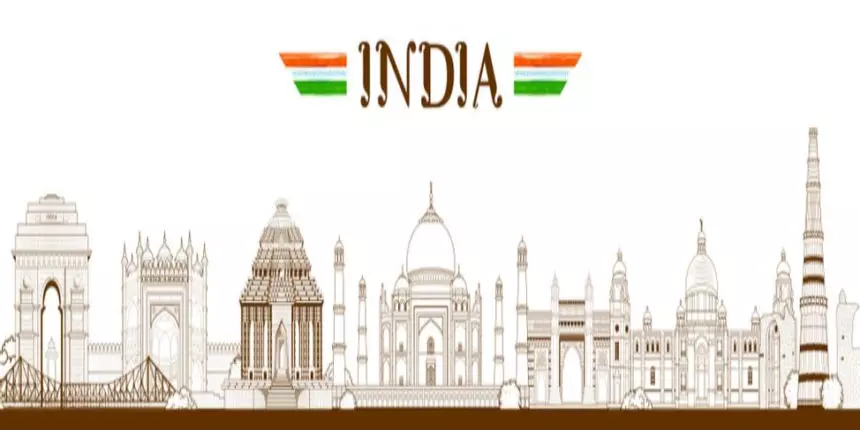
India is a country with a rich and diverse cultural heritage, and it is no surprise that it is also home to a variety of people from different religions, ethnicities and backgrounds. Diversity in India is a reflection of the many different groups and cultures that coexist in the country. India’s diversity is not only celebrated but embraced and admired.
When it comes to diversity in India, there are several types. The most common are religious, linguistic, regional, and ethnic diversity. India is one of the most religiously diverse countries in the world, with Hindus, Muslims, Christians, Sikhs, Buddhists, Jains and many other belief systems calling the country home. Additionally, India is home to several languages including Hindi, Sanskrit, Tamil, Telugu, Urdu, Punjabi, Gujarati, and Bengali.
India’s ethnic diversity is also quite remarkable. The population is divided into numerous ethnic groups including the Scheduled Tribes, Scheduled Castes, Other Backward Classes, and many more. Each of these ethnic groups has their own distinct culture, language, and customs, making them unique and inspiring. There are also many dialects of each language and they are spoken throughout the country's states and regions.
Benefits | The many different types of diversity in India are beneficial in several ways. Firstly, it leads to a more harmonious and peaceful environment, as people from different backgrounds are able to share their unique perspectives and experiences, leading to mutual understanding and respect. Secondly, diversity allows for a variety of talents and skills to be cultivated, leading to a more vibrant and successful economy. Lastly, diversity leads to an increased appreciation and understanding of different cultures and beliefs, which is beneficial for the country’s progress and development.
Unity In Diversity | The concept of ‘unity in diversity’ is an integral part of India’s culture and identity. This concept is evident in everything from the country’s festivals and celebrations, to its freedom of expression and equal rights for all. It is this idea of diverse people coming together to form one unified nation that makes India stand out among other countries in the world.
India is a land of unique and diverse cultures, religions, languages, and customs. The concept of ‘unity in diversity’ is a cornerstone of India’s culture and identity, and is something that should be celebrated and embraced. The different patterns of culture, religion, language, and customs make India one of the most interesting countries in the world.
Geographical Diversity | India's diversity is also visible in its geographical landscape. India is a land of mountains, valleys, plains, deserts, and seas. It has the highest mountain range, the Himalayas. It also has the largest desert, the Thar Desert, and the longest river, the Ganges.
Social, Economical And Cultural Advantages Of Diversity
India’s diversity is beneficial both economically and socially, allowing the country to prosper and grow.
The diversities in India have been beneficial for its people. One of the most significant benefits is that it has enabled India to be a culturally, socially, politically and economically united nation. The diversity in India has also helped to promote a sense of understanding and tolerance among its people. It is this sense of understanding and tolerance that has enabled India to become a strong and unified nation.
India's unique diversity has enabled the country to be a leader in the field of science, technology, and innovation. India is home to a number of leading technology companies and has been a major player in the global economy.
India's diversity has also been beneficial in terms of promoting cultural exchange and understanding. India has given the world a number of great cultural traditions such as yoga, Ayurveda, and music. This has enabled people from different cultures and religions to come together and exchange ideas and experiences.
Impact of Diversity In India
The diversity in India has had a major positive impact on the country, both in terms of its economy and its culture. The diverse population has enabled India to become a multicultural hub, with people from all walks of life interacting with each other, exchanging ideas, and bringing different perspectives to the table. This has enabled the country to become a melting pot of different cultures, thereby increasing its economic power. The presence of different religions has also resulted in the development of a more tolerant and inclusive society.
The diversity of India has also enabled it to preserve its traditions and practices. By embracing different cultures, India has been able to protect its own culture and customs. This has enabled the country to benefit from its traditional values and practices, while also benefiting from the knowledge and innovation brought in by its diverse population.
India’s diversity is a source of strength and a major source of pride for the country. It has enabled the country to become a major player in the global economy, while preserving its traditional values and customs. The presence of different religions, languages, and cultures has enabled the country to become a more tolerant and inclusive society. It is this unique diversity that has enabled India to become the vibrant, dynamic and economically powerful nation that it is today.
Applications for Admissions are open.

JEE Main Important Physics formulas
As per latest 2024 syllabus. Physics formulas, equations, & laws of class 11 & 12th chapters

UPES School of Liberal Studies
Ranked #52 Among Universities in India by NIRF | Up to 30% Merit-based Scholarships | Lifetime placement assistance

Aakash iACST Scholarship Test 2024
Get up to 90% scholarship on NEET, JEE & Foundation courses

JEE Main Important Chemistry formulas
As per latest 2024 syllabus. Chemistry formulas, equations, & laws of class 11 & 12th chapters

PACE IIT & Medical, Financial District, Hyd
Enrol in PACE IIT & Medical, Financial District, Hyd for JEE/NEET preparation

ALLEN JEE Exam Prep
Start your JEE preparation with ALLEN
Download Careers360 App's
Regular exam updates, QnA, Predictors, College Applications & E-books now on your Mobile
Certifications
We Appeared in

25,000+ students realised their study abroad dream with us. Take the first step today
Meet top uk universities from the comfort of your home, here’s your new year gift, one app for all your, study abroad needs, start your journey, track your progress, grow with the community and so much more.

Verification Code
An OTP has been sent to your registered mobile no. Please verify

Thanks for your comment !
Our team will review it before it's shown to our readers.

- School Education /
Essay on Diversity in India: A Tapestry of Cultural and Traditions

- Updated on
- Apr 23, 2024

Essay on Diversity in India: “Unity in diversity is India’s strength. There is simplicity in every Indian. There is unity in every corner of India.” As India celebrates 77 years of independence, it’s crucial to explore the vast diversity that defines this nation. Despite the colonial past, which attempted to diminish the rich tapestry of Indian culture, the country today is a vibrant mosaic of languages, religions, and traditions.
Table of Contents
- 0.1 Cultural Diversity
- 0.2 Social Diversity
- 0.3 Religious Diversity
- 0.4 Linguistic Diversity
- 0.5 Geographical Diversity
- 0.6 Conclusion
Cultural Diversity
India’s cultural landscape is as varied as its geography. Each region boasts its unique festivals, arts, and culinary traditions. For instance, classical dance forms like Kathak in the north and Bharatanatyam in the south highlight regional narratives and myths. The popularity of Western dance forms has not overshadowed these traditional dances, reflecting a resurgence in interest in and pride in indigenous arts. Similarly, festivals like Diwali and Eid are celebrated with fervor across the country, showcasing unity in diversity.
India is the home of numerous different religious traditions. Hindus (82.41%), Muslims (11.6%), Christians (2.32%), Sikhs (1.99%), Buddhists (0.77%), Jains (0.41%), and tribal cultures (many of whom still engage in animism and magic) comprise the population of India.
Quick Read: Essay on the Role of Youth in Nation-Building
Social Diversity
India’s social fabric is woven with threads from numerous ethnic groups and castes. This diversity is a double-edged sword, presenting challenges in terms of social equality while also enriching the societal structure with a variety of perspectives and practices. Urban areas, in particular, display a melting pot of cultures, with people from various backgrounds living and working together, which promotes a broader understanding and acceptance of diverse social norms.
Religious Diversity
Home to major religions such as Hinduism, Islam, Christianity, Sikhism, Buddhism, and Jainism, India’s religious diversity is a testament to its pluralistic society. This multiplicity of belief systems coexisting is one of India’s greatest strengths, fostering a culture of mutual respect and tolerance. The peaceful cohabitation of diverse religious communities, however, is occasionally challenged by conflicts, underscoring the need for continuous dialogue and reconciliation.
Linguistic Diversity
With over 1,600 languages and dialects spoken, the linguistic diversity in India is staggering. Hindi and English are widely used, but state-specific languages such as Tamil, Telugu, Marathi, and Bengali hold equal importance. The Indian constitution’s recognition of 22 official languages is a clear indicator of the country’s commitment to embracing its linguistic heritage. This diversity is also evident in literature, with works ranging from the ancient epics of Ramayana and Mahabharata to modern writings in various vernaculars.
Every language embodies the history and customs of its people and reflects a unique legacy. The Indian Constitution, which affirms India’s commitment to inclusivity and cultural preservation, recognises and defends this diversity by defending the rights of linguistic minorities and fighting for the preservation of endangered languages.
Geographical Diversity
From the snowy peaks of the Himalayas in the north to the tropical beaches of the south, India’s geographical diversity influences its climate, agriculture, and lifestyle. This diversity not only dictates the economic activities of different regions but also shapes the cultural identities of the people, from the attire they wear to the food they eat.
India has breathtaking geographical diversity, with the sun-kissed beaches of the south and the towering Himalayas of the north, as well as the lush forests of Kerala and Rajasthan. In addition to influencing regional traditions and means of subsistence, this geographic diversity has given India an unmatched biodiversity. India is a large country with a diverse range of natural environments, including deserts, evergreen forests, steep mountains, perennial and non-perennial river systems, long coastlines, and fertile plains. Its total land area is 3.28 million square kilometres.
Quick Read: Importance of Mental Health Essay
While significant achievements have marked India’s journey since independence, the shadow of colonial influence still lingers, impacting perceptions and values. Yet, the resurgence of pride in one’s heritage and the continuous celebration of its diversity are signs of a maturing nation that values its past while forging a new identity. India’s diversity is not just a fact of life but the very fabric that makes it unique on the global stage. As India moves forward, it is the recognition and preservation of this diversity that will empower it to overcome its colonial hangovers and redefine what it means to be modern and Indian on its terms. The path ahead lies in embracing the richness of its diverse heritage, thus truly fulfilling the dreams that fueled its struggle for freedom 77 years ago.
Ans: India is a multicultural nation home to all of the world’s main religions. The number of languages spoken in India is over 1600. India’s terrain is diverse, with mountains, plains, plateaus, deserts, and islands among its features. Aside from this, migration from all over the world has given rise to a variety of ethnic groups in India.
Ans: The acceptance of a range of individual characteristics within a society or group is referred to as diversity. Aspects including color, ethnicity, gender, age, financial situation, sexual orientation, religious views, abilities, and more can all be considered in these differences.
Ans: India is referred to as the “land of diversity” for a variety of reasons, including its diverse culinary options, language usage, holiday celebrations, and religious and cultural practices.
Check out our Popular Essay Topics for Students
For more information on such interesting topics, visit our essay writing page and follow Leverage Edu.
Aayushi Vardhan
Leave a Reply Cancel reply
Save my name, email, and website in this browser for the next time I comment.
Contact no. *

Connect With Us

25,000+ students realised their study abroad dream with us. Take the first step today.

Resend OTP in

Need help with?
Study abroad.
UK, Canada, US & More
IELTS, GRE, GMAT & More
Scholarship, Loans & Forex
Country Preference
New Zealand
Which English test are you planning to take?
Which academic test are you planning to take.
Not Sure yet
When are you planning to take the exam?
Already booked my exam slot
Within 2 Months
Want to learn about the test
Which Degree do you wish to pursue?
When do you want to start studying abroad.
January 2024
September 2024
What is your budget to study abroad?

How would you describe this article ?
Please rate this article
We would like to hear more.
Have something on your mind?

Make your study abroad dream a reality in January 2022 with
India's Biggest Virtual University Fair

Essex Direct Admission Day
Why attend .

Don't Miss Out

Essay on Diversity in India
Students are often asked to write an essay on Diversity in India in their schools and colleges. And if you’re also looking for the same, we have created 100-word, 250-word, and 500-word essays on the topic.
Let’s take a look…
100 Words Essay on Diversity in India
Introduction.
India is a vast country known for its diverse culture, religion, and languages. This diversity is what makes India unique and special.
Cultural Diversity
India is home to various cultures. Each culture has its own set of traditions, festivals, and rituals, contributing to the rich tapestry of Indian society.
Religious Diversity
India is a secular country where people of different religions live together. These religions include Hinduism, Islam, Christianity, Sikhism, Buddhism, and Jainism.
Linguistic Diversity
India is a linguistically diverse country with more than 1600 spoken languages. Each state has its own regional language, adding to the country’s multiculturalism.
In conclusion, diversity in India is a symbol of unity in diversity. It is a country where diverse cultures, religions, and languages coexist peacefully.
250 Words Essay on Diversity in India
India, often referred to as a ‘sub-continent’, is renowned for its rich diversity. The country’s vast landscape is a mosaic of various cultures, languages, religions, and traditions, making it a vibrant and colorful nation.
India’s cultural diversity is one of its most striking features. With over 2,000 distinct ethnic groups and more than 1,600 spoken languages, the country is a melting pot of cultures. Every state in India has its unique dance forms, music, cuisine, and art, contributing to a cultural kaleidoscope that is as diverse as it is vibrant.
Religion is another facet of India’s diversity. The country is the birthplace of several religions, including Hinduism, Buddhism, Jainism, and Sikhism. Additionally, it embraces Islam, Christianity, and other faiths, fostering a spirit of religious coexistence and tolerance.
The linguistic diversity in India is unparalleled. Each state has its language, and there are several dialects within each language. The constitution of India recognizes 22 official languages, reflecting the linguistic pluralism of the country.
The diversity in India is a testament to the country’s inherent capacity to absorb, integrate, and embrace differences. It is a living example of unity in diversity, where diverse cultural, religious, and linguistic elements coexist and enrich the social fabric. This diversity is not just the country’s identity but also its strength, fostering mutual respect, understanding, and harmony among its people.
500 Words Essay on Diversity in India
Introduction: the melting pot of cultures.
India, often referred to as the “land of diversity”, is a unique amalgamation of various cultures, religions, languages, and traditions. This diversity, deeply embedded in the country’s historical roots and societal fabric, is what makes India a vibrant and dynamic nation.
Cultural diversity is one of the most striking features of India. The country is home to numerous ethnic groups, each with its distinct customs, traditions, and languages. The coexistence of these diverse cultures under one political and geographical entity is a testament to India’s pluralistic society. From the folk dances of Punjab to the martial arts of Kerala, from the sand art of Odisha to the bamboo dance of Mizoram, each region contributes to the cultural mosaic of the country.
India is the birthplace of four major world religions: Hinduism, Buddhism, Jainism, and Sikhism. It also embraces other religions such as Islam, Christianity, Zoroastrianism, Judaism, and Baha’i, demonstrating the nation’s religious tolerance and acceptance. This religious diversity is reflected in the myriad of festivals celebrated throughout the year, such as Diwali, Eid, Christmas, and Paryushan, each marking a unique blend of customs, traditions, and rituals.
Linguistic diversity is another defining characteristic of India. With over 2,000 distinct languages spoken across the country, India stands as one of the most linguistically diverse nations globally. Each language, with its unique script and literature, adds to the rich tapestry of Indian culture.
Geographical Diversity
From the snow-capped peaks of the Himalayas to the serene backwaters of Kerala, from the deserts of Rajasthan to the dense forests of the Northeast, India’s geographical diversity is unparalleled. This geographical variance has given rise to diverse ecosystems and biodiversity, making India one of the 17 mega-diverse countries in the world.
Diversity in Indian Cuisine
Indian cuisine is a gastronomic reflection of the country’s diversity. Each region has its unique culinary tradition, influenced by local produce, culture, and history. The rich and spicy curries of Rajasthan, the seafood-centric cuisine of Bengal, the coconut-infused dishes of Kerala, and the simple yet flavorful food of Gujarat are just a few examples of India’s diverse culinary landscape.
Conclusion: Unity in Diversity
Despite the immense diversity, there exists a unique sense of unity among Indians, often encapsulated in the phrase “Unity in Diversity”. This unity is evident in the mutual respect and harmony with which people of different cultures, religions, and languages coexist in India. The diversity of India is not merely a demographic fact but a living, influential force that shapes the nation’s worldview and its approach to global relations. It is a testament to India’s resilience, adaptability, and inclusivity. The diversity of India thus stands as a beacon of pluralism and multiculturalism in an increasingly globalized world.
That’s it! I hope the essay helped you.
If you’re looking for more, here are essays on other interesting topics:
- Essay on Status of Women in India
- Essay on Indian Freedom Struggle
- Essay on India Is Incredible Travel And Explore
Apart from these, you can look at all the essays by clicking here .
Happy studying!
Leave a Reply Cancel reply
Your email address will not be published. Required fields are marked *
Save my name, email, and website in this browser for the next time I comment.

- Skip to primary navigation
- Skip to main content
- Skip to primary sidebar
UPSC Coaching, Study Materials, and Mock Exams
Enroll in ClearIAS UPSC Coaching Join Now Log In
Call us: +91-9605741000
Diversity of India
Last updated on April 30, 2024 by ClearIAS Team

Despite numerous foreign invasions, a vast synthesis of the cultures, faiths, and languages of the people from all castes and communities has maintained its cohesion and unity.
Even if stark economic and social disparities have prevented the formation of egalitarian social relations, national unity and integrity have been preserved.
This fusion has transformed India into a singular mosque of cultures. India thus presents a situation that appears to be multicultural within the context of a single, cohesive cultural whole.
Also read: Minorities in India
Table of Contents
What does diversity mean?
The word “diversity” places more emphasis on differences than on unfairness. It refers to group disparities, or distinctions separating one group of individuals from another.
- These differences could be biological, religious, linguistic, or anything else. Diversity refers to the variety of races, religions, languages, castes, and cultures.
- Integrity refers to unity. It is a state of social psychology. It suggests a sense of unity and togetherness. It represents the ties that keep a society’s members together.
- Essentially, “unity in diversity” means “diversity without fragmentation” and “unity without uniformity.” It is predicated on the idea that diversity enhances interpersonal communication.
- When we refer to India as a country with rich cultural diversity, we are referring to the wide variety of social groupings and cultures that call India home. These groups identify primarily through cultural traits like language, religion, sect, race, or caste.
Also read: Environmental Racism
Add IAS, IPS, or IFS to Your Name!
Your Effort. Our Expertise.
Join ClearIAS
The different forms of India’s diversity include the following.
Religious diversity
- India is a country that is home to many different religions.
- The Indian population is made up of Hindus (82.41%), Muslims (11.6%), Christians (2.32%), Sikhs (1.99%), Buddhists (0.77%), and Jains (0.41%), in addition to the tribal societies, many of which continue to practice animism and magic.
- Hindus are divided into several sects, including Vaishnavas, Shaivites, Shaktas, and Smartas. Similarly, there are various Muslim sects, including Shi’ites, Sunnis, Ahmadis, etc.
Language diversity
- The major language families among the languages spoken in India are the Dravidian languages, which are spoken by 20% of Indians, and the Indo-Aryan languages, which are spoken by 75% of Indians.
- The Austroasiatic, Sino-Tibetan, Tai-Kadai, and a few other minor language families and isolates are home to other languages.
- After Papua New Guinea, India has the second-highest number of languages in the world. India’s ethnic variety was divided into the following groups according to the 1931 census: Negrito, Proto-Australoid, Mongoloid, Mediterranean, Western Brachycephals, and Nordic.
Also Read: Endangered Languages of India
The Caste Diversity
- The Caste Diversity includes members of all three major world races, namely Caucasoid, Mongoloid, and Negroid: India is a nation with Both varna and jati have been referred to as “caste” in the past.
- According to functional differentiation, society is divided into four groups called Varna. Brahmins, Kshatriyas, Vaishyas, Shudras, and an outcaste.
- While the term “Jati” designates a hereditary endogamous status group engaged in a certain traditional profession. There are more than 3000 jatis, and there isn’t a single system for classifying and ranking them across all of India.
- The jati system is dynamic and allows for movement, which has allowed jatis to vary their location throughout time. M. N. Srinivas referred to this method of upward mobility as “Sanskritization.”
Ethnic diversity
- Ethnic diversity Regional differences are reflected in cultural patterns.
- Due to demographic diversity , Indian culture is extremely diverse and is a fusion of many other cultures.
- Every region, caste, and religion has its unique traditions and culture. As a result, there are variations in music, dance, theatre, and architecture.
Geographic diversity
- With a total land area of 3.28 million square kilometres, India is a big nation with a wide variety of natural landscapes , including deserts, evergreen forests, steep mountains, perennial and non-perennial river systems, lengthy coasts, and fertile plains.
- In addition to the major forms of variety already mentioned, India also has diversity in many other areas, such as tribal, rural, and urban patterns of habitation, patterns of marriage and kinship along religious and regional lines, and more.
Also read: Salient features of Indian Society
Factors Promoting Unity in Diversity of India
- Constitutional identity : A single person is elected to lead the entire nation. Even Nevertheless, the majority of states adhere to a standard 3-tier structure of government, bringing
- Furthermore, regardless of their age, gender, class, caste, or religion, all citizens are guaranteed certain fundamental rights under the Constitution.
- Religion tolerance is the distinctive characteristic of faiths in India, and as a result, many different religions coexist there. The Constitution itself guarantees the freedom of religion and practice. Additionally, the state accords equal preference to all religions and has no official state religion.
- Interstate movement : Article 19 (1) (d) of the Constitution ensures freedom of movement throughout India’s territory, fostering a sense of brotherhood and solidarity among the people.
- Other elements that contribute to consistency in the criminal justice system and policy implementation include the uniformity of the law, penal code, and administrative tasks (such as All India Services).
- Economic integration : The Goods and Service Tax (GST) has paved the way for “one country, one tax, one national market,” thereby facilitating unity among different regions. The Indian Constitution also guarantees the freedom of trade, commerce, and intercourse within the territory of India under Article.
- Institution of pilgrimage and religious practices: Spirituality and religion are very important in India. Religious sites and sacred rivers can be found all over the length and breadth of the country, from Badrinath and Kedarnath in the north to Rameshwaram in the south, Jagannath Puri in the east, and Dwaraka in the west. They are closely tied to the long-standing tradition of pilgrimage, which has always drawn people to different regions of the nation and given them a feeling of geo-cultural identity.
- Fairs and festivals : These serve as integrating factors as well because people from all across the nation participate in them. Hindus around the nation celebrate Diwali, just as Muslims and Christians celebrate Id and Christmas, respectively. In India, interreligious celebrations are also observed.
- Weather integration via the monsoon : The monsoon season affects the entire Indian subcontinent’s flora and fauna, agricultural activities, and way of life, including holidays. Sports and cinema are widely popular throughout the nation, serving as unifying forces. Factors that undermine India’s unity include:
- Regionalism : Regionalism favours the interests of a certain region or region over those of the nation. It may also hurt national integration. Regional demands and the resulting law and order situation
- Polarising politics : Politicians would occasionally invoke ascriptive identities like caste, religion, etc. to gain support. Violence, feelings of mistrust, and suspicion among minorities can emerge from this kind of polarising politics.
- Unbalanced development Backwardness of a region can be brought on by uneven socioeconomic growth, poor economic policies, and the resulting economic inequities. As a result, this may spark acts of violence, ignite migrant waves, or even fuel separatist demands. For instance, numerous examples of secessionist demands and tendencies have emerged as a result of the North East’s economic underdevelopment.
- Ethnic diversity and nativism: Ethnic diversity has frequently resulted in conflicts between various ethnic groups, particularly as a result of reasons like employment competition, a lack of resources, and threats to identity For instance, Bodos and Muslims who speak Bengali frequently fight in Assam. The son of the soil idea, which links people to their place of birth and bestows upon them certain advantages, privileges, duties, and obligations that may not apply to others, has served to emphasize this.
- Geographic isolation: Isolation can also result in separatist thinking and identity problems. Geographically, the North-East is separated from the rest of the nation by a small passageway called the Siliguri corridor, sometimes known as the “Chicken’s Neck.”The area is less developed economically than the rest of the nation and has poor infrastructure. As a result, it has seen several incidents of separatist and cross-border terrorism.
- Inter-religious disputes : Inter-religious disputes not only deteriorate relations between two communities by sowing distrust and fear, but they also damage the nation’s secular fabric.
- Conflicts between states : This may cause feelings of regionalism to grow. Additionally, it may have an impact on interstate commerce and communication. For instance, the Karnataka-Tamil Cauvery River dispute
- External influences : External influences, such as foreign organizations, terrorist organizations, and extremist groups, can occasionally inspire violence and foster feelings of secession. g. Inter-Services Intelligence (ISI) is alleged to have supported and trained mujahideen to fight in Jammu and Kashmir and incite separatist sentiment among local groupings.
Despite the difficulties diversity might provide, there is no denying the vital role sociocultural diversity has played in maintaining and advancing Indian culture.
The handling of diversity in Indian society, not diversity itself, is the issue. Because the benefits of growth haven’t been divided fairly or certain groups’ cultures haven’t received the acknowledgement they deserve, problems like regionalism, communalism, and ethnic conflicts have emerged.
Therefore, the Constitution and its ideas must serve as the foundation of our society. Any culture that has attempted to homogenize itself has experienced eventual stagnation and decline.
UPSC Prelims Test Series 2024
Take All-India Mock Exams: Analyse Your Progress!
The most notable instance in this situation is Pakistan’s attempt to force its culture on East Pakistan, ultimately leading to Bangladesh’s establishment.
Article Written By: Atheena Fathima Riyas

Aim IAS, IPS, or IFS?

Prelims cum Mains (PCM) GS Course: Target UPSC CSE 2025 (Online)
₹95000 ₹59000

Prelims cum Mains (PCM) GS Course: Target UPSC CSE 2026 (Online)
₹115000 ₹69000

Prelims cum Mains (PCM) GS Course: Target UPSC CSE 2027 (Online)
₹125000 ₹79000

About ClearIAS Team
ClearIAS is one of the most trusted learning platforms in India for UPSC preparation. Around 1 million aspirants learn from the ClearIAS every month.
Our courses and training methods are different from traditional coaching. We give special emphasis on smart work and personal mentorship. Many UPSC toppers thank ClearIAS for our role in their success.
Download the ClearIAS mobile apps now to supplement your self-study efforts with ClearIAS smart-study training.
Reader Interactions
April 16, 2024 at 8:41 pm
Leave a Reply Cancel reply
Your email address will not be published. Required fields are marked *
Don’t lose out without playing the right game!
Follow the ClearIAS Prelims cum Mains (PCM) Integrated Approach.
Join ClearIAS PCM Course Now
UPSC Online Preparation
- Union Public Service Commission (UPSC)
- Indian Administrative Service (IAS)
- Indian Police Service (IPS)
- IAS Exam Eligibility
- UPSC Free Study Materials
- UPSC Exam Guidance
- UPSC Prelims Test Series
- UPSC Syllabus
- UPSC Online
- UPSC Prelims
- UPSC Interview
- UPSC Toppers
- UPSC Previous Year Qns
- UPSC Age Calculator
- UPSC Calendar 2024
- About ClearIAS
- ClearIAS Programs
- ClearIAS Fee Structure
- IAS Coaching
- UPSC Coaching
- UPSC Online Coaching
- ClearIAS Blog
- Important Updates
- Announcements
- Book Review
- ClearIAS App
- Work with us
- Advertise with us
- Privacy Policy
- Terms and Conditions
- Talk to Your Mentor
Featured on

and many more...

Take ClearIAS Mock Exams: Analyse Your Progress

UPSC Prelims Test Series for GS and CSAT: With Performance Analysis and All-India Ranking (Online)
₹9999 ₹4999
Numbers, Facts and Trends Shaping Your World
Read our research on:
Full Topic List
Regions & Countries
- Publications
- Our Methods
- Short Reads
- Tools & Resources
Read Our Research On:
Religion in India: Tolerance and Segregation
Indians say it is important to respect all religions, but major religious groups see little in common and want to live separately, table of contents.
- The dimensions of Hindu nationalism in India
- India’s Muslims express pride in being Indian while identifying communal tensions, desiring segregation
- Muslims, Hindus diverge over legacy of Partition
- Religious conversion in India
- Religion very important across India’s religious groups
- Near-universal belief in God, but wide variation in how God is perceived
- Across India’s religious groups, widespread sharing of beliefs, practices, values
- Religious identity in India: Hindus divided on whether belief in God is required to be a Hindu, but most say eating beef is disqualifying
- Sikhs are proud to be Punjabi and Indian
- 1. Religious freedom, discrimination and communal relations
- 2. Diversity and pluralism
- 3. Religious segregation
- 4. Attitudes about caste
- 5. Religious identity
- 6. Nationalism and politics
- 7. Religious practices
- 8. Religion, family and children
- 9. Religious clothing and personal appearance
- 10. Religion and food
- 11. Religious beliefs
- 12. Beliefs about God
- Acknowledgments
- Appendix A: Methodology
- Appendix B: Index of religious segregation
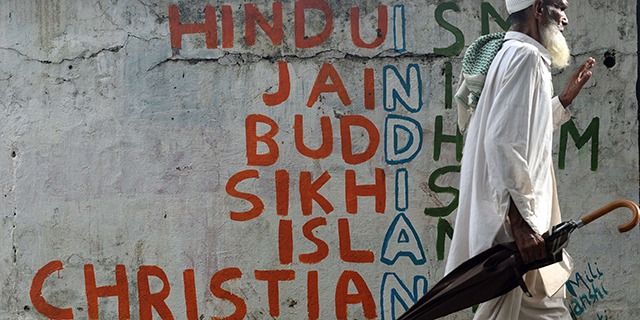
This study is Pew Research Center’s most comprehensive, in-depth exploration of India to date. For this report, we surveyed 29,999 Indian adults (including 22,975 who identify as Hindu, 3,336 who identify as Muslim, 1,782 who identify as Sikh, 1,011 who identify as Christian, 719 who identify as Buddhist, 109 who identify as Jain and 67 who identify as belonging to another religion or as religiously unaffiliated). Interviews for this nationally representative survey were conducted face-to-face under the direction of RTI International from Nov. 17, 2019, to March 23, 2020.
To improve respondent comprehension of survey questions and to ensure all questions were culturally appropriate, Pew Research Center followed a multi-phase questionnaire development process that included expert review, focus groups, cognitive interviews, a pretest and a regional pilot survey before the national survey. The questionnaire was developed in English and translated into 16 languages, independently verified by professional linguists with native proficiency in regional dialects.
Respondents were selected using a probability-based sample design that would allow for robust analysis of all major religious groups in India – Hindus, Muslims, Christians, Sikhs, Buddhists and Jains – as well as all major regional zones. Data was weighted to account for the different probabilities of selection among respondents and to align with demographic benchmarks for the Indian adult population from the 2011 census. The survey is calculated to have covered 98% of Indians ages 18 and older and had an 86% national response rate.
For more information, see the Methodology for this report. The questions used in this analysis can be found here .
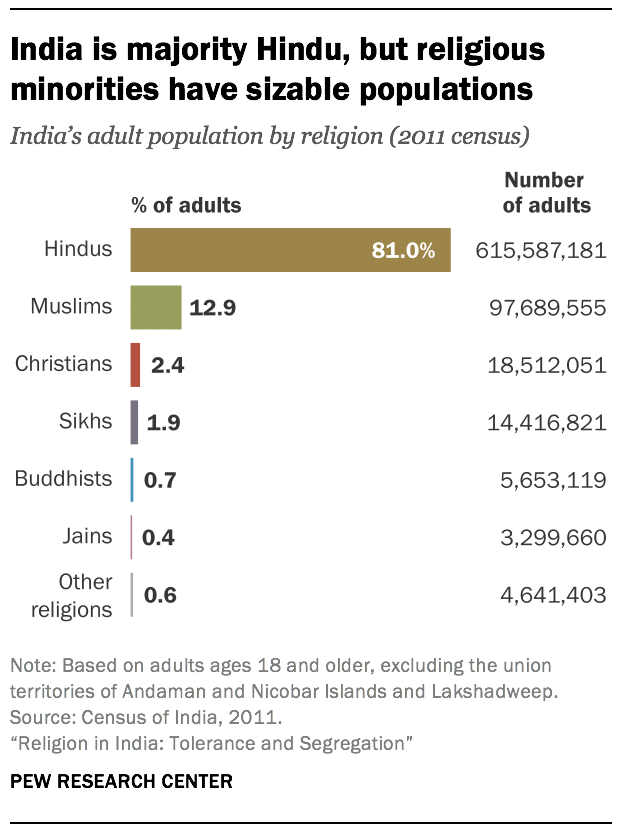
More than 70 years after India became free from colonial rule, Indians generally feel their country has lived up to one of its post-independence ideals: a society where followers of many religions can live and practice freely.
India’s massive population is diverse as well as devout. Not only do most of the world’s Hindus, Jains and Sikhs live in India, but it also is home to one of the world’s largest Muslim populations and to millions of Christians and Buddhists.
A major new Pew Research Center survey of religion across India, based on nearly 30,000 face-to-face interviews of adults conducted in 17 languages between late 2019 and early 2020 (before the COVID-19 pandemic ), finds that Indians of all these religious backgrounds overwhelmingly say they are very free to practice their faiths.
Related India research
This is one in a series of Pew Research Center reports on India based on a survey of 29,999 Indian adults conducted Nov. 17, 2019, to March 23, 2020, as well as demographic data from the Indian Census and other government sources. Other reports can be found here:
- How Indians View Gender Roles in Families and Society
- Religious Composition of India
- India’s Sex Ratio at Birth Begins To Normalize
Indians see religious tolerance as a central part of who they are as a nation. Across the major religious groups, most people say it is very important to respect all religions to be “truly Indian.” And tolerance is a religious as well as civic value: Indians are united in the view that respecting other religions is a very important part of what it means to be a member of their own religious community.
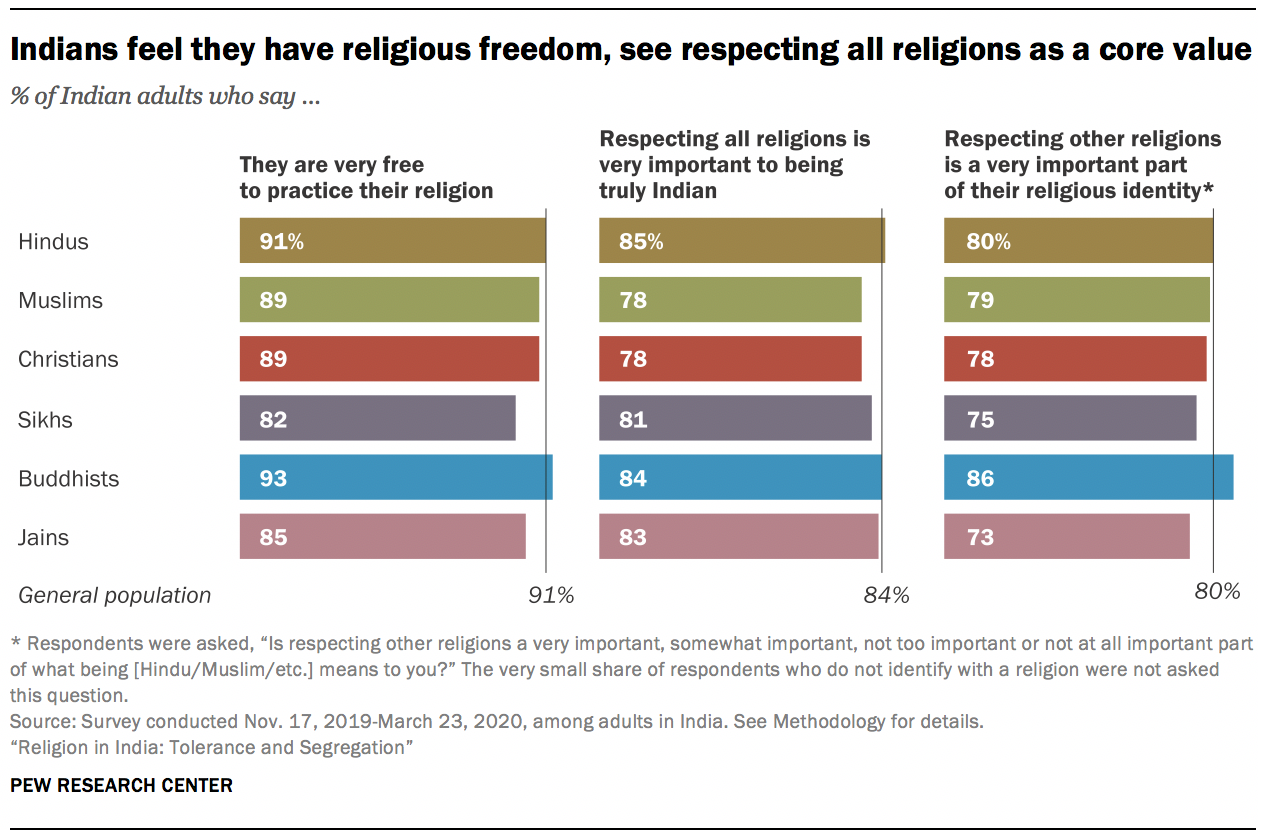
These shared values are accompanied by a number of beliefs that cross religious lines. Not only do a majority of Hindus in India (77%) believe in karma, but an identical percentage of Muslims do, too. A third of Christians in India (32%) – together with 81% of Hindus – say they believe in the purifying power of the Ganges River, a central belief in Hinduism. In Northern India, 12% of Hindus and 10% of Sikhs, along with 37% of Muslims, identity with Sufism, a mystical tradition most closely associated with Islam. And the vast majority of Indians of all major religious backgrounds say that respecting elders is very important to their faith.
Yet, despite sharing certain values and religious beliefs – as well as living in the same country, under the same constitution – members of India’s major religious communities often don’t feel they have much in common with one another. The majority of Hindus see themselves as very different from Muslims (66%), and most Muslims return the sentiment, saying they are very different from Hindus (64%). There are a few exceptions: Two-thirds of Jains and about half of Sikhs say they have a lot in common with Hindus. But generally, people in India’s major religious communities tend to see themselves as very different from others.
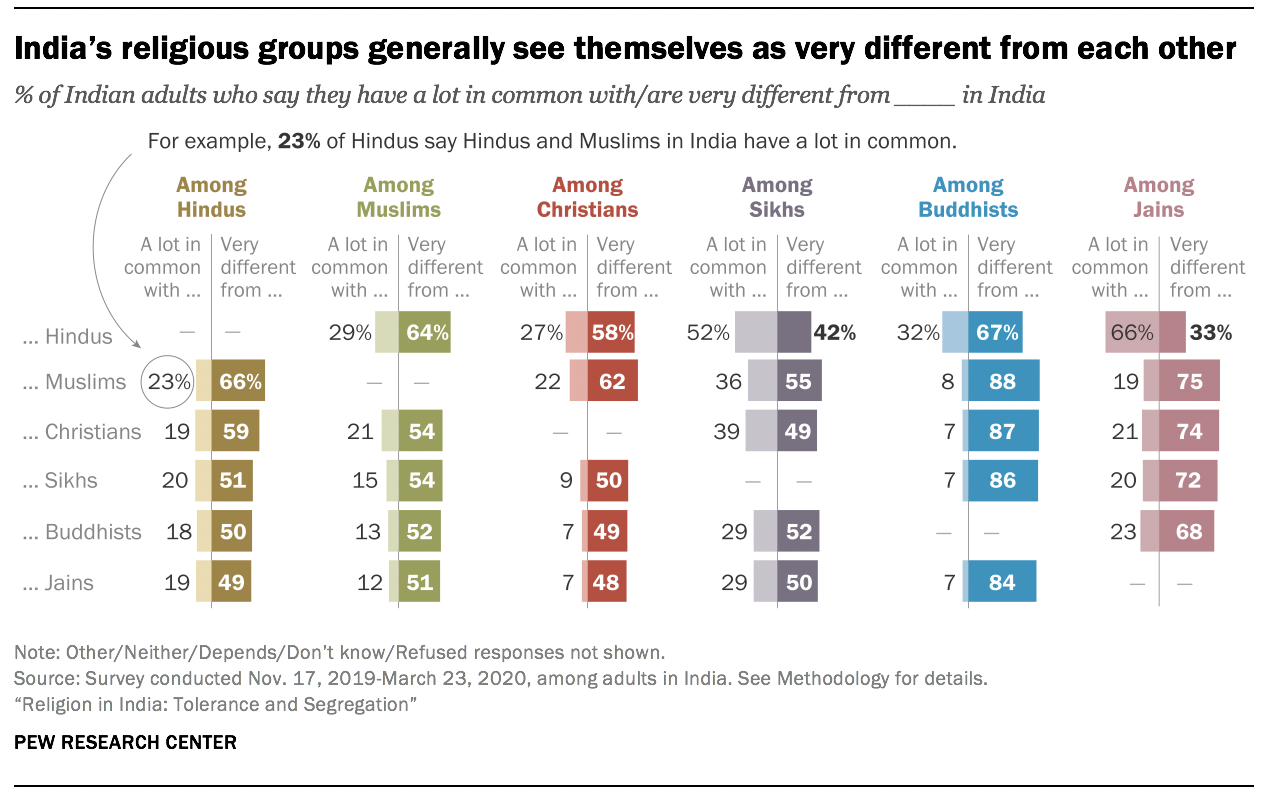
This perception of difference is reflected in traditions and habits that maintain the separation of India’s religious groups. For example, marriages across religious lines – and, relatedly, religious conversions – are exceedingly rare (see Chapter 3 ). Many Indians, across a range of religious groups, say it is very important to stop people in their community from marrying into other religious groups. Roughly two-thirds of Hindus in India want to prevent interreligious marriages of Hindu women (67%) or Hindu men (65%). Even larger shares of Muslims feel similarly: 80% say it is very important to stop Muslim women from marrying outside their religion, and 76% say it is very important to stop Muslim men from doing so.
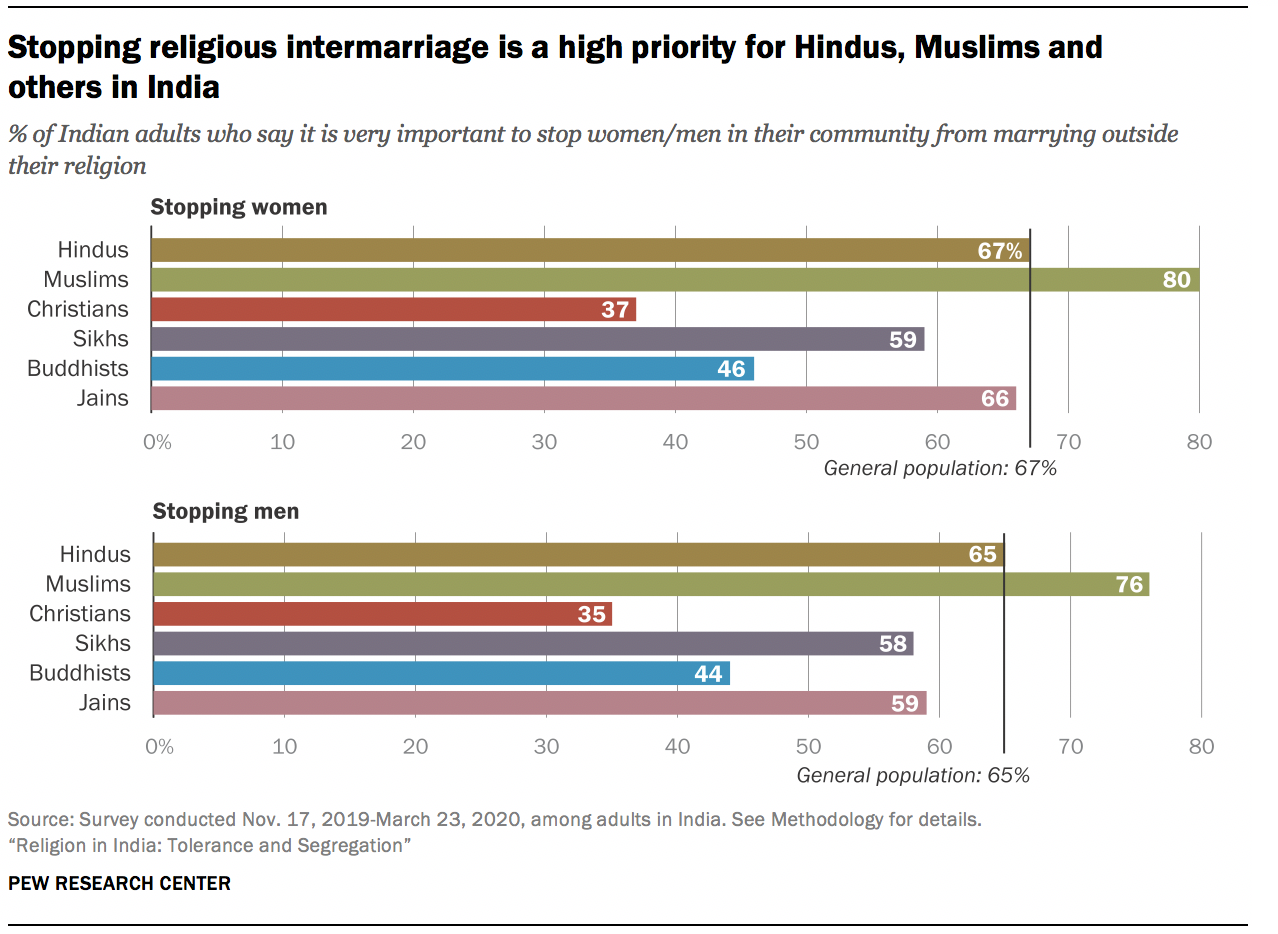
Moreover, Indians generally stick to their own religious group when it comes to their friends. Hindus overwhelmingly say that most or all of their close friends are also Hindu. Of course, Hindus make up the majority of the population, and as a result of sheer numbers, may be more likely to interact with fellow Hindus than with people of other religions. But even among Sikhs and Jains, who each form a sliver of the national population, a large majority say their friends come mainly or entirely from their small religious community.
Fewer Indians go so far as to say that their neighborhoods should consist only of people from their own religious group. Still, many would prefer to keep people of certain religions out of their residential areas or villages. For example, many Hindus (45%) say they are fine with having neighbors of all other religions – be they Muslim, Christian, Sikh, Buddhist or Jain – but an identical share (45%) say they would not be willing to accept followers of at least one of these groups, including more than one-in-three Hindus (36%) who do not want a Muslim as a neighbor. Among Jains, a majority (61%) say they are unwilling to have neighbors from at least one of these groups, including 54% who would not accept a Muslim neighbor, although nearly all Jains (92%) say they would be willing to accept a Hindu neighbor.
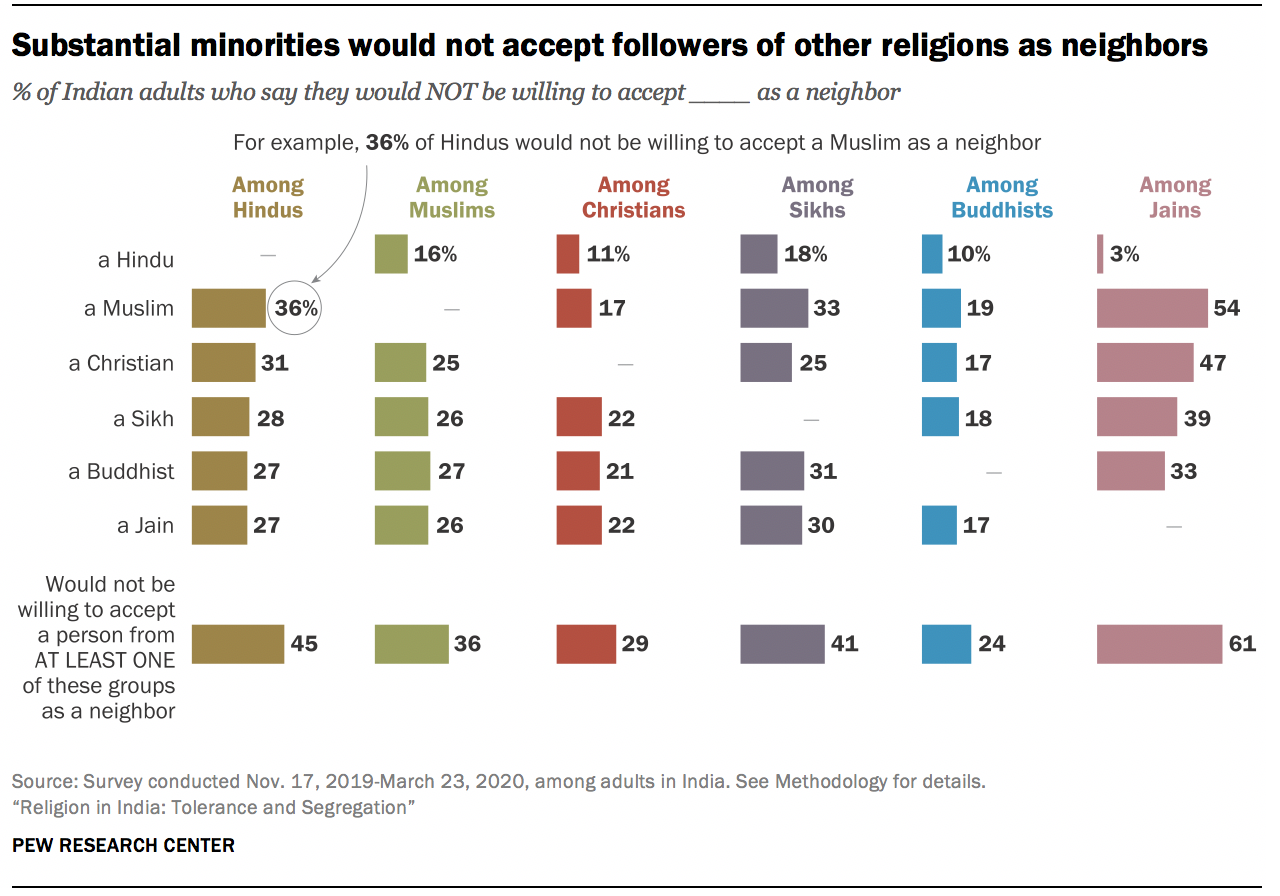
Indians, then, simultaneously express enthusiasm for religious tolerance and a consistent preference for keeping their religious communities in segregated spheres – they live together separately . These two sentiments may seem paradoxical, but for many Indians they are not.
Indeed, many take both positions, saying it is important to be tolerant of others and expressing a desire to limit personal connections across religious lines. Indians who favor a religiously segregated society also overwhelmingly emphasize religious tolerance as a core value. For example, among Hindus who say it is very important to stop the interreligious marriage of Hindu women, 82% also say that respecting other religions is very important to what it means to be Hindu. This figure is nearly identical to the 85% who strongly value religious tolerance among those who are not at all concerned with stopping interreligious marriage.
In other words, Indians’ concept of religious tolerance does not necessarily involve the mixing of religious communities. While people in some countries may aspire to create a “melting pot” of different religious identities, many Indians seem to prefer a country more like a patchwork fabric, with clear lines between groups.
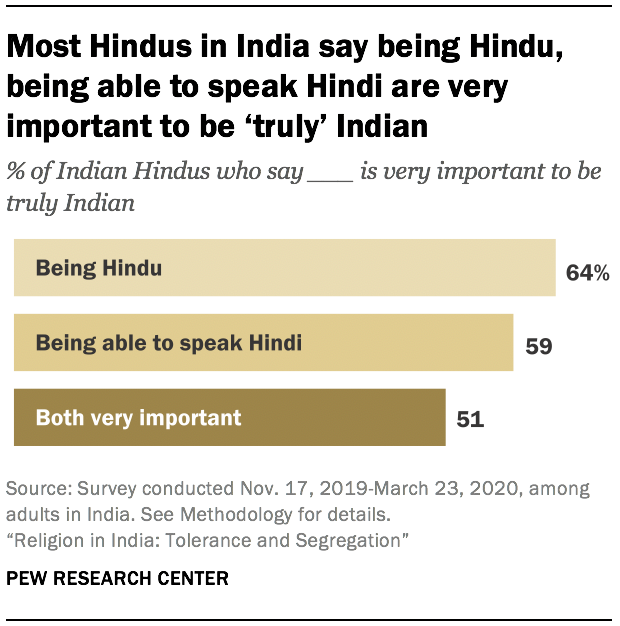
One of these religious fault lines – the relationship between India’s Hindu majority and the country’s smaller religious communities – has particular relevance in public life, especially in recent years under the ruling Bharatiya Janata Party (BJP). Led by Prime Minister Narendra Modi, the BJP is often described as promoting a Hindu nationalist ideology .
The survey finds that Hindus tend to see their religious identity and Indian national identity as closely intertwined: Nearly two-thirds of Hindus (64%) say it is very important to be Hindu to be “truly” Indian.
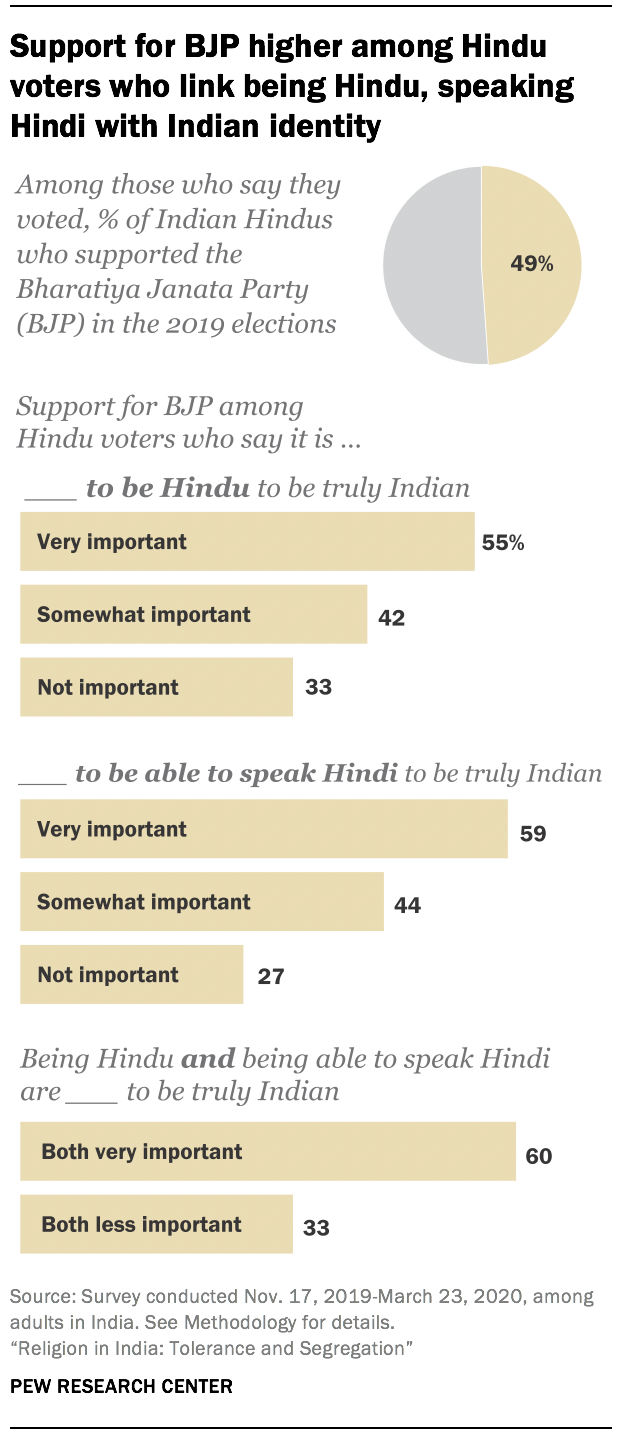
Most Hindus (59%) also link Indian identity with being able to speak Hindi – one of dozens of languages that are widely spoken in India. And these two dimensions of national identity – being able to speak Hindi and being a Hindu – are closely connected. Among Hindus who say it is very important to be Hindu to be truly Indian, fully 80% also say it is very important to speak Hindi to be truly Indian.
The BJP’s appeal is greater among Hindus who closely associate their religious identity and the Hindi language with being “truly Indian.” In the 2019 national elections, 60% of Hindu voters who think it is very important to be Hindu and to speak Hindi to be truly Indian cast their vote for the BJP, compared with only a third among Hindu voters who feel less strongly about both these aspects of national identity.
Overall, among those who voted in the 2019 elections, three-in-ten Hindus take all three positions: saying it is very important to be Hindu to be truly Indian; saying the same about speaking Hindi; and casting their ballot for the BJP.
These views are considerably more common among Hindus in the largely Hindi-speaking Northern and Central regions of the country, where roughly half of all Hindu voters fall into this category, compared with just 5% in the South.
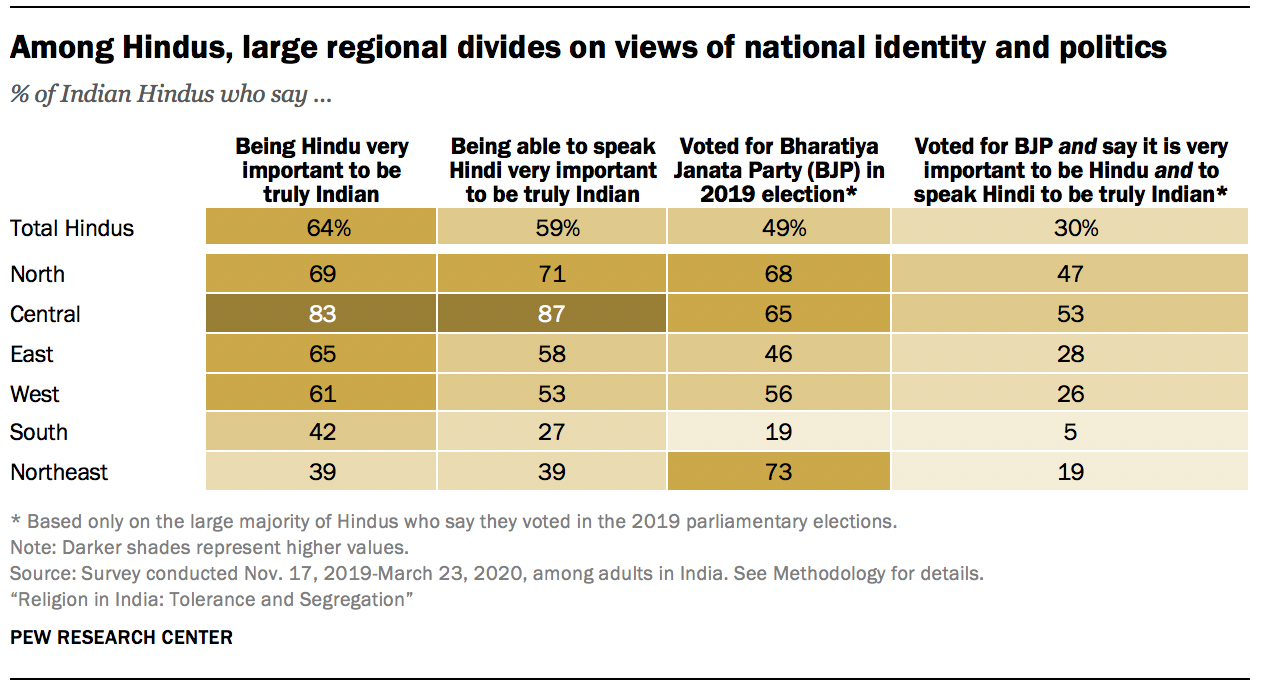
Whether Hindus who meet all three of these criteria qualify as “Hindu nationalists” may be debated, but they do express a heightened desire for maintaining clear lines between Hindus and other religious groups when it comes to whom they marry, who their friends are and whom they live among. For example, among Hindu BJP voters who link national identity with both religion and language, 83% say it is very important to stop Hindu women from marrying into another religion, compared with 61% among other Hindu voters.
This group also tends to be more religiously observant: 95% say religion is very important in their lives, and roughly three-quarters say they pray daily (73%). By comparison, among other Hindu voters, a smaller majority (80%) say religion is very important in their lives, and about half (53%) pray daily.
Even though Hindu BJP voters who link national identity with religion and language are more inclined to support a religiously segregated India, they also are more likely than other Hindu voters to express positive opinions about India’s religious diversity. Nearly two-thirds (65%) of this group – Hindus who say that being a Hindu and being able to speak Hindi are very important to be truly Indian and who voted for the BJP in 2019 – say religious diversity benefits India, compared with about half (47%) of other Hindu voters.
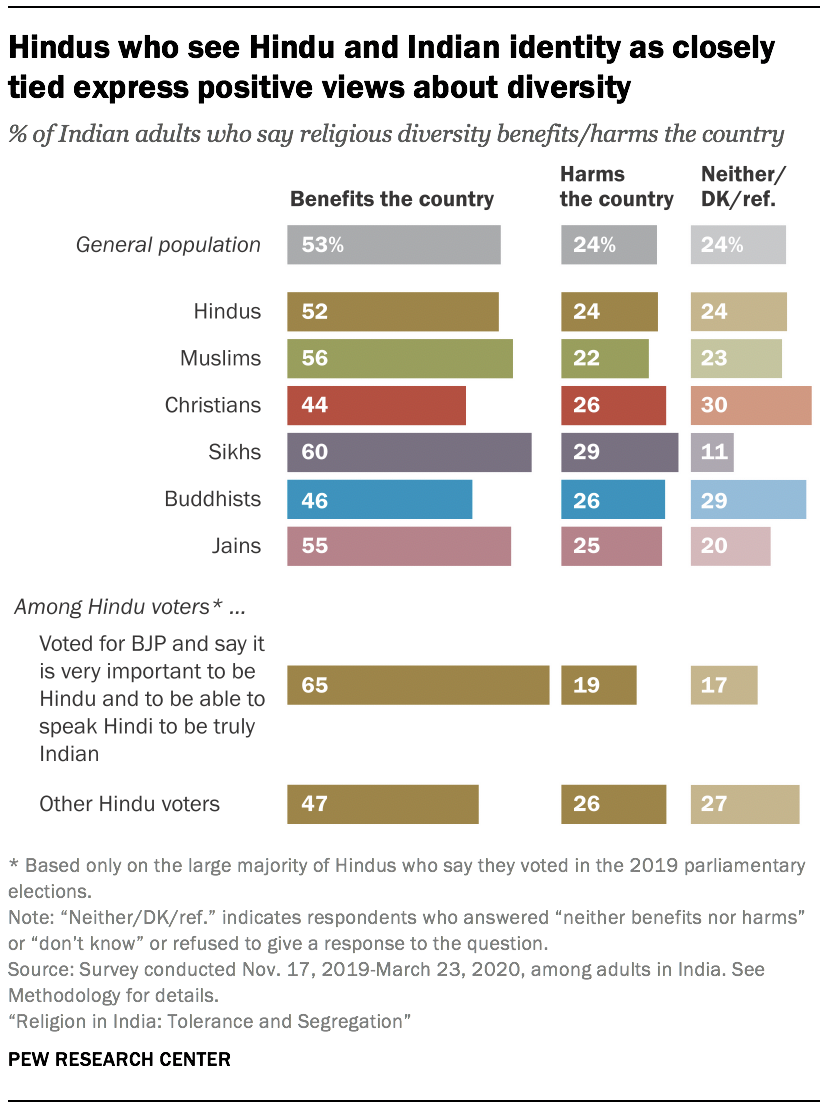
This finding suggests that for many Hindus, there is no contradiction between valuing religious diversity (at least in principle) and feeling that Hindus are somehow more authentically Indian than fellow citizens who follow other religions.
Among Indians overall, there is no overwhelming consensus on the benefits of religious diversity. On balance, more Indians see diversity as a benefit than view it as a liability for their country: Roughly half (53%) of Indian adults say India’s religious diversity benefits the country, while about a quarter (24%) see diversity as harmful, with similar figures among both Hindus and Muslims. But 24% of Indians do not take a clear position either way – they say diversity neither benefits nor harms the country, or they decline to answer the question. (See Chapter 2 for a discussion of attitudes toward diversity.)
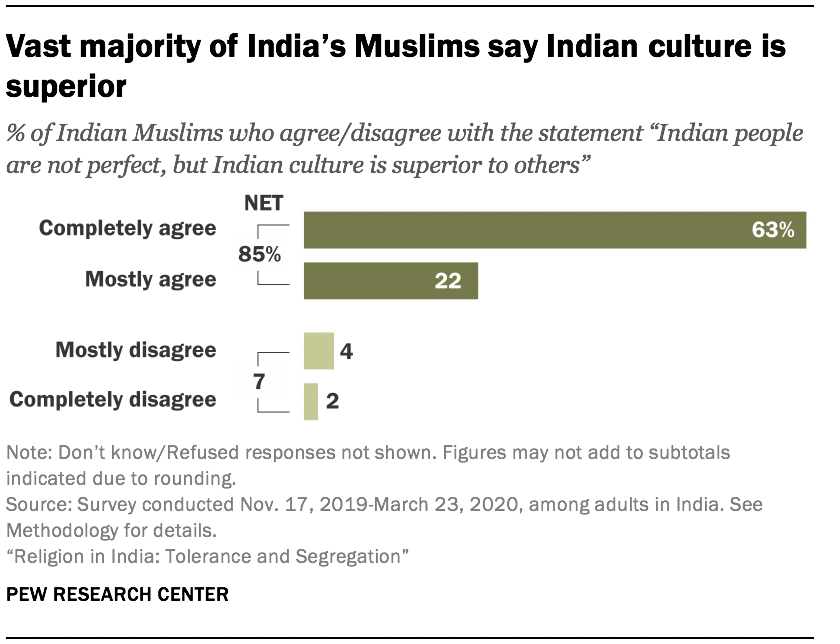
India’s Muslim community, the second-largest religious group in the country, historically has had a complicated relationship with the Hindu majority. The two communities generally have lived peacefully side by side for centuries, but their shared history also is checkered by civil unrest and violence. Most recently, while the survey was being conducted, demonstrations broke out in parts of New Delhi and elsewhere over the government’s new citizenship law , which creates an expedited path to citizenship for immigrants from some neighboring countries – but not Muslims.
Today, India’s Muslims almost unanimously say they are very proud to be Indian (95%), and they express great enthusiasm for Indian culture: 85% agree with the statement that “Indian people are not perfect, but Indian culture is superior to others.”
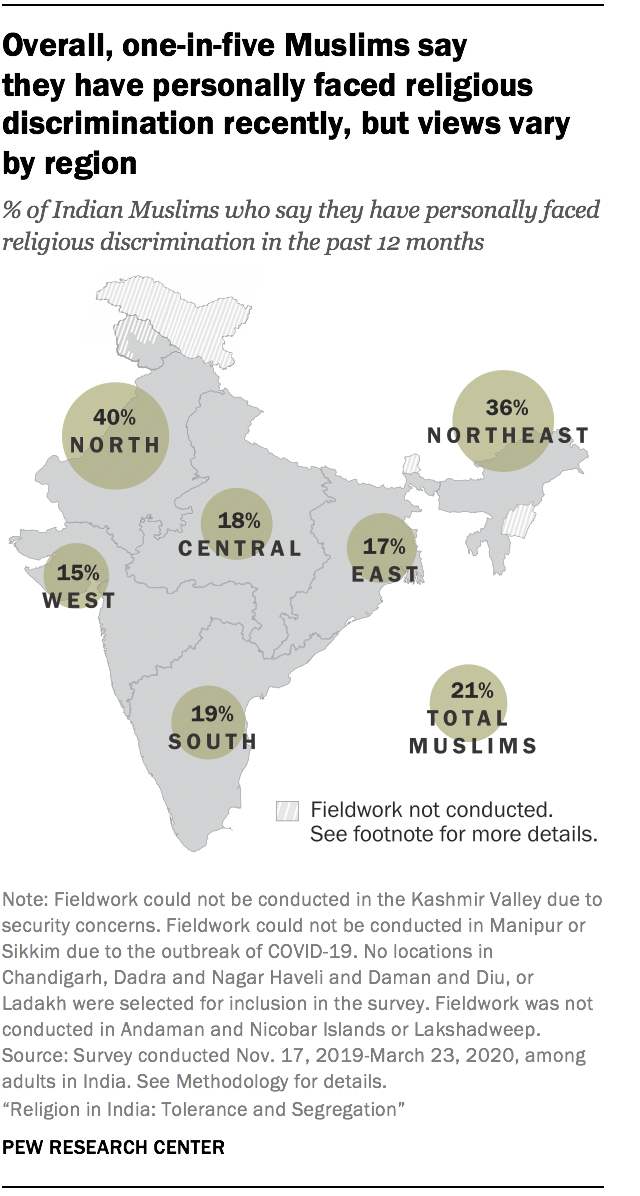
Relatively few Muslims say their community faces “a lot” of discrimination in India (24%). In fact, the share of Muslims who see widespread discrimination against their community is similar to the share of Hindus who say Hindus face widespread religious discrimination in India (21%). (See Chapter 1 for a discussion of attitudes on religious discrimination.)
But personal experiences with discrimination among Muslims vary quite a bit regionally. Among Muslims in the North, 40% say they personally have faced religious discrimination in the last 12 months – much higher levels than reported in most other regions.
In addition, most Muslims across the country (65%), along with an identical share of Hindus (65%), see communal violence as a very big national problem. (See Chapter 1 for a discussion of Indians’ attitudes toward national problems.)
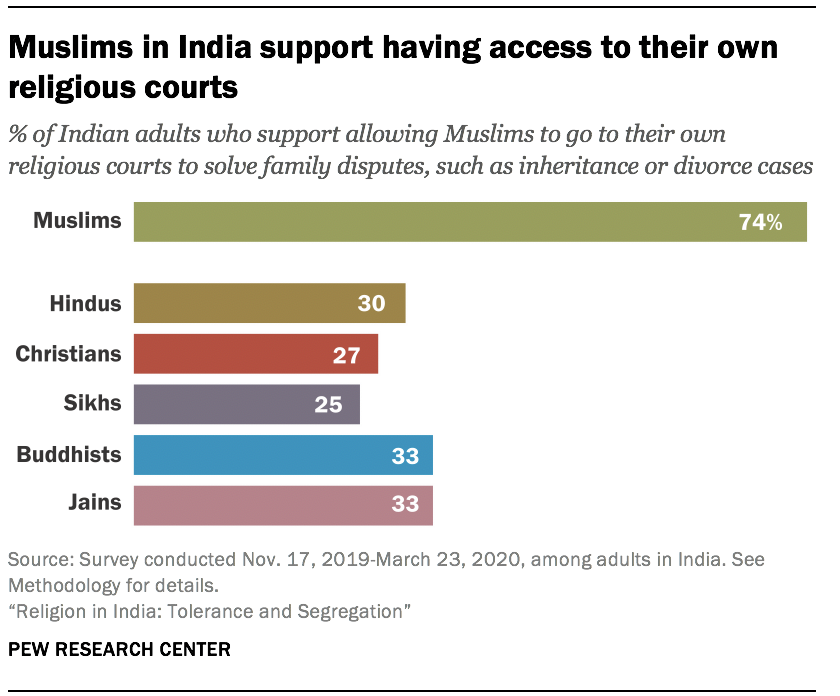
Like Hindus, Muslims prefer to live religiously segregated lives – not just when it comes to marriage and friendships, but also in some elements of public life. In particular, three-quarters of Muslims in India (74%) support having access to the existing system of Islamic courts, which handle family disputes (such as inheritance or divorce cases), in addition to the secular court system.
Muslims’ desire for religious segregation does not preclude tolerance of other groups – again similar to the pattern seen among Hindus. Indeed, a majority of Muslims who favor separate religious courts for their community say religious diversity benefits India (59%), compared with somewhat fewer of those who oppose religious courts for Muslims (50%).
Sidebar: Islamic courts in India
Since 1937, India’s Muslims have had the option of resolving family and inheritance-related cases in officially recognized Islamic courts, known as dar-ul-qaza. These courts are overseen by religious magistrates known as qazi and operate under Shariah principles . For example, while the rules of inheritance for most Indians are governed by the Indian Succession Act of 1925 and the Hindu Succession Act of 1956 (amended in 2005), Islamic inheritance practices differ in some ways, including who can be considered an heir and how much of the deceased person’s property they can inherit. India’s inheritance laws also take into account the differing traditions of other religious communities, such as Hindus and Christians, but their cases are handled in secular courts. Only the Muslim community has the option of having cases tried by a separate system of family courts. The decisions of the religious courts, however, are not legally binding , and the parties involved have the option of taking their case to secular courts if they are not satisfied with the decision of the religious court.
As of 2021, there are roughly 70 dar-ul-qaza in India. Most are in the states of Maharashtra and Uttar Pradesh. Goa is the only state that does not recognize rulings by these courts, enforcing its own uniform civil code instead. Dar-ul-qaza are overseen by the All India Muslim Personal Law Board .
While these courts can grant divorces among Muslims, they are prohibited from approving divorces initiated through the practice known as triple talaq, in which a Muslim man instantly divorces his wife by saying the Arabic/Urdu word “talaq” (meaning “divorce”) three times. This practice was deemed unconstitutional by the Indian Supreme Court in 2017 and formally outlawed by the Lok Sabha, the lower house of India’s Parliament, in 2019. 1
Recent debates have emerged around Islamic courts. Some Indians have expressed concern that the rise of dar-ul-qaza could undermine the Indian judiciary, because a subset of the population is not bound to the same laws as everyone else. Others have argued that the rulings of Islamic courts are particularly unfair to women, although the prohibition of triple talaq may temper some of these criticisms. In its 2019 political manifesto , the BJP proclaimed a desire to create a national Uniform Civil Code, saying it would increase gender equality.
Some Indian commentators have voiced opposition to Islamic courts along with more broadly negative sentiments against Muslims, describing the rising numbers of dar-ul-qaza as the “Talibanization” of India , for example.
On the other hand, Muslim scholars have defended the dar-ul-qaza, saying they expedite justice because family disputes that would otherwise clog India’s courts can be handled separately, allowing the secular courts to focus their attention on other concerns.
Since 2018, the Hindu nationalist party Hindu Mahasabha (which does not hold any seats in Parliament) has tried to set up Hindu religious courts , known as Hindutva courts, aiming to play a role similar to dar-ul-qaza, only for the majority Hindu community. None of these courts have been recognized by the Indian government, and their rulings are not considered legally binding.
The seminal event in the modern history of Hindu-Muslim relations in the region was the partition of the subcontinent into Hindu-majority India and Muslim-majority Pakistan at the end of the British colonial period in 1947. Partition remains one of the largest movements of people across borders in recorded history, and in both countries the carving of new borders was accompanied by violence, rioting and looting .
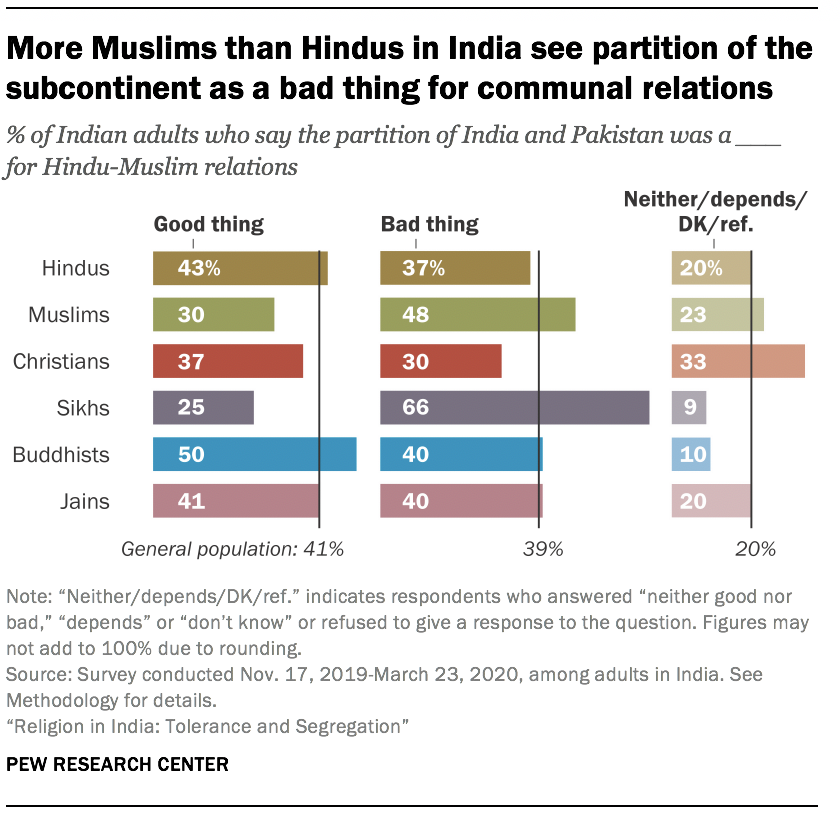
More than seven decades later, the predominant view among Indian Muslims is that the partition of the subcontinent was “a bad thing” for Hindu-Muslim relations. Nearly half of Muslims say Partition hurt communal relations with Hindus (48%), while fewer say it was a good thing for Hindu-Muslim relations (30%). Among Muslims who prefer more religious segregation – that is, who say they would not accept a person of a different faith as a neighbor – an even higher share (60%) say Partition was a bad thing for Hindu-Muslim relations.
Sikhs, whose homeland of Punjab was split by Partition, are even more likely than Muslims to say Partition was a bad thing for Hindu-Muslim relations: Two-thirds of Sikhs (66%) take this position. And Sikhs ages 60 and older, whose parents most likely lived through Partition, are more inclined than younger Sikhs to say the partition of the country was bad for communal relations (74% vs. 64%).
While Sikhs and Muslims are more likely to say Partition was a bad thing than a good thing, Hindus lean in the opposite direction: 43% of Hindus say Partition was beneficial for Hindu-Muslim relations, while 37% see it as a bad thing.
Context for the survey
Interviews were conducted after the conclusion of the 2019 national parliamentary elections and after the revocation of Jammu and Kashmir’s special status under the Indian Constitution. In December 2019, protests against the country’s new citizenship law broke out in several regions.
Fieldwork could not be conducted in the Kashmir Valley and a few districts elsewhere due to security concerns. These locations include some heavily Muslim areas, which is part of the reason why Muslims make up 11% of the survey’s total sample, while India’s adult population is roughly 13% Muslim, according to the most recent census data that is publicly available, from 2011. In addition, it is possible that in some other parts of the country, interreligious tensions over the new citizenship law may have slightly depressed participation in the survey by potential Muslim respondents.
Nevertheless, the survey’s estimates of religious beliefs, behaviors and attitudes can be reported with a high degree of confidence for India’s total population, because the number of people living in the excluded areas (Manipur, Sikkim, the Kashmir Valley and a few other districts) is not large enough to affect the overall results at the national level. About 98% of India’s total population had a chance of being selected for this survey.
Greater caution is warranted when looking at India’s Muslims separately, as a distinct population. The survey cannot speak to the experiences and views of Kashmiri Muslims. Still, the survey does represent the beliefs, behaviors and attitudes of around 95% of India’s overall Muslim population.
These are among the key findings of a Pew Research Center survey conducted face-to-face nationally among 29,999 Indian adults. Local interviewers administered the survey between Nov. 17, 2019, and March 23, 2020, in 17 languages. The survey covered all states and union territories of India, with the exceptions of Manipur and Sikkim, where the rapidly developing COVID-19 situation prevented fieldwork from starting in the spring of 2020, and the remote territories of the Andaman and Nicobar Islands and Lakshadweep; these areas are home to about a quarter of 1% of the Indian population. The union territory of Jammu and Kashmir was covered by the survey, though no fieldwork was conducted in the Kashmir region itself due to security concerns.
This study, funded by The Pew Charitable Trusts and the John Templeton Foundation, is part of a larger effort by Pew Research Center to understand religious change and its impact on societies around the world. The Center previously has conducted religion-focused surveys across sub-Saharan Africa ; the Middle East-North Africa region and many other countries with large Muslim populations ; Latin America ; Israel ; Central and Eastern Europe ; Western Europe ; and the United States .
The rest of this Overview covers attitudes on five broad topics: caste and discrimination; religious conversion; religious observances and beliefs; how people define their religious identity, including what kind of behavior is considered acceptable to be a Hindu or a Muslim; and the connection between economic development and religious observance.
Caste is another dividing line in Indian society, and not just among Hindus
Religion is not the only fault line in Indian society. In some regions of the country, significant shares of people perceive widespread, caste-based discrimination.
The caste system is an ancient social hierarchy based on occupation and economic status. People are born into a particular caste and tend to keep many aspects of their social life within its boundaries, including whom they marry. Even though the system’s origins are in historical Hindu writings , today Indians nearly universally identify with a caste, regardless of whether they are Hindu, Muslim, Christian, Sikh, Buddhist or Jain.
Overall, the majority of Indian adults say they are a member of a Scheduled Caste (SC) – often referred to as Dalits (25%) – Scheduled Tribe (ST) (9%) or Other Backward Class (OBC) (35%). 2
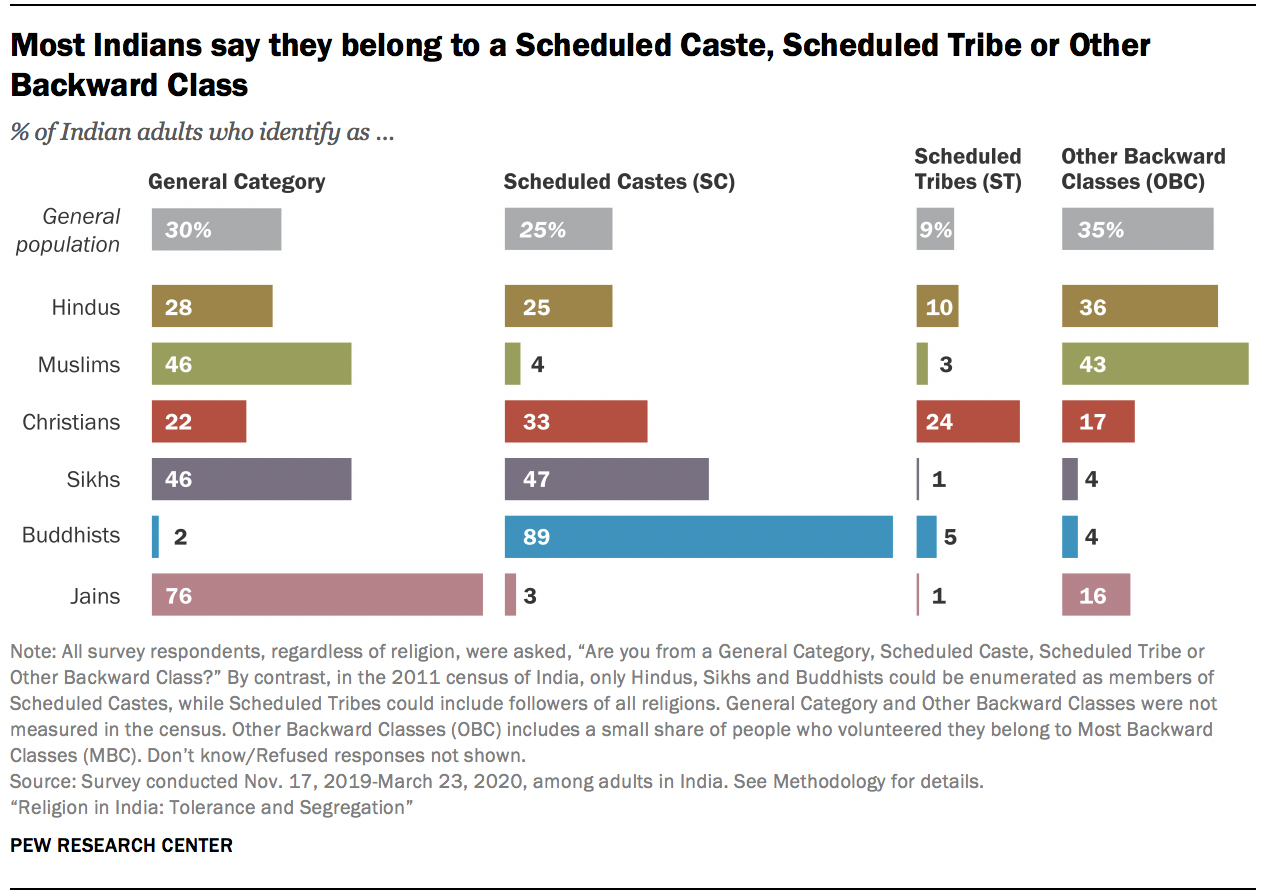
Buddhists in India nearly universally identify themselves in these categories, including 89% who are Dalits (sometimes referred to by the pejorative term “untouchables”).
Members of SC/ST/OBC groups traditionally formed the lower social and economic rungs of Indian society, and historically they have faced discrimination and unequal economic opportunities . The practice of untouchability in India ostracizes members of many of these communities, especially Dalits, although the Indian Constitution prohibits caste-based discrimination, including untouchability, and in recent decades the government has enacted economic advancement policies like reserved seats in universities and government jobs for Dalits, Scheduled Tribes and OBC communities.
Roughly 30% of Indians do not belong to these protected groups and are classified as “General Category.” This includes higher castes such as Brahmins (4%), traditionally the priestly caste. Indeed, each broad category includes several sub-castes – sometimes hundreds – with their own social and economic hierarchies.
Three-quarters of Jains (76%) identify with General Category castes, as do 46% of both Muslims and Sikhs.
Caste-based discrimination, as well as the government’s efforts to compensate for past discrimination, are politically charged topics in India . But the survey finds that most Indians do not perceive widespread caste-based discrimination. Just one-in-five Indians say there is a lot of discrimination against members of SCs, while 19% say there is a lot of discrimination against STs and somewhat fewer (16%) see high levels of discrimination against OBCs. Members of Scheduled Castes and Scheduled Tribes are slightly more likely than others to perceive widespread discrimination against their two groups. Still, large majorities of people in these categories do not think they face a lot of discrimination.
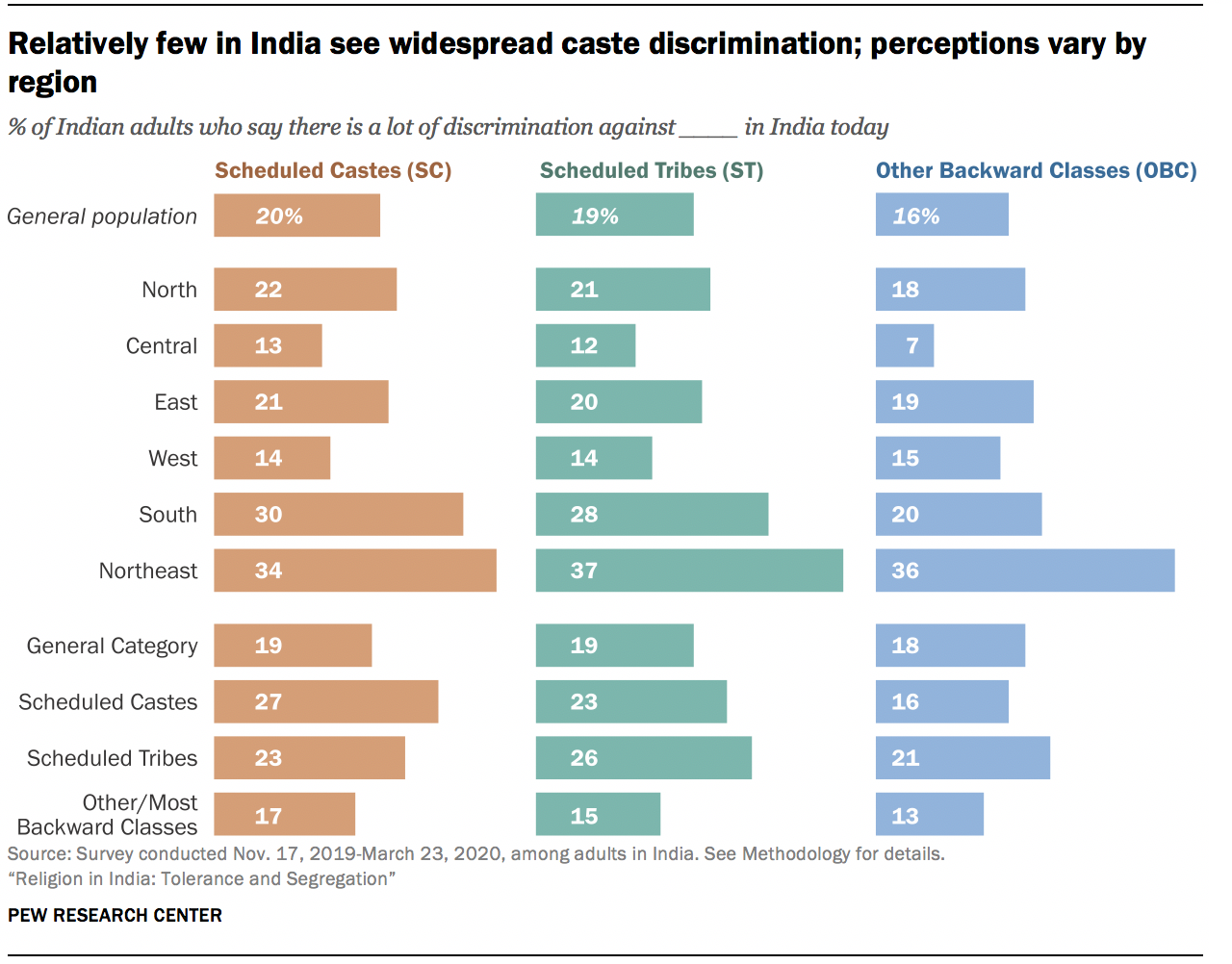
These attitudes vary by region, however. Among Southern Indians, for example, 30% see widespread discrimination against Dalits, compared with 13% in the Central part of the country. And among the Dalit community in the South, even more (43%) say their community faces a lot of discrimination, compared with 27% among Southern Indians in the General Category who say the Dalit community faces widespread discrimination in India.
A higher share of Dalits in the South and Northeast than elsewhere in the country say they, personally, have faced discrimination in the last 12 months because of their caste: 30% of Dalits in the South say this, as do 38% in the Northeast.
Although caste discrimination may not be perceived as widespread nationally, caste remains a potent factor in Indian society. Most Indians from other castes say they would be willing to have someone belonging to a Scheduled Caste as a neighbor (72%). But a similarly large majority of Indians overall (70%) say that most or all of their close friends share their caste. And Indians tend to object to marriages across caste lines, much as they object to interreligious marriages. 3

Overall, 64% of Indians say it is very important to stop women in their community from marrying into other castes, and about the same share (62%) say it is very important to stop men in their community from marrying into other castes. These figures vary only modestly across members of different castes. For example, nearly identical shares of Dalits and members of General Category castes say stopping inter-caste marriages is very important.
Majorities of Hindus, Muslims, Sikhs and Jains consider stopping inter-caste marriage of both men and women a high priority. By comparison, fewer Buddhists and Christians say it is very important to stop such marriages – although for majorities of both groups, stopping people from marrying outside their caste is at least “somewhat” important.
People surveyed in India’s South and Northeast see greater caste discrimination in their communities, and they also raise fewer objections to inter-caste marriages than do Indians overall. Meanwhile, college-educated Indians are less likely than those with less education to say stopping inter-caste marriages is a high priority. But, even within the most highly educated group, roughly half say preventing such marriages is very important. (See Chapter 4 for more analysis of Indians’ views on caste.)
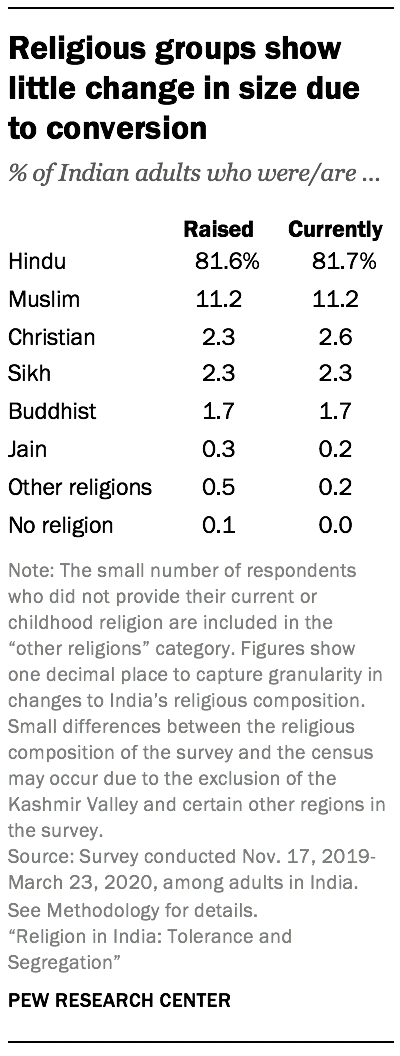
In recent years, conversion of people belonging to lower castes (including Dalits) away from Hinduism – a traditionally non-proselytizing religion – to proselytizing religions, especially Christianity, has been a contentious political issue in India. As of early 2021, nine states have enacted laws against proselytism , and some previous surveys have shown that half of Indians support legal bans on religious conversions. 4
This survey, though, finds that religious switching, or conversion, has a minimal impact on the overall size of India’s religious groups. For example, according to the survey, 82% of Indians say they were raised Hindu, and a nearly identical share say they are currently Hindu, showing no net losses for the group through conversion to other religions. Other groups display similar levels of stability.
Changes in India’s religious landscape over time are largely a result of differences in fertility rates among religious groups, not conversion.
Respondents were asked two separate questions to measure religious switching: “What is your present religion, if any?” and, later in the survey, “In what religion were you raised, if any?” Overall, 98% of respondents give the same answer to both these questions.
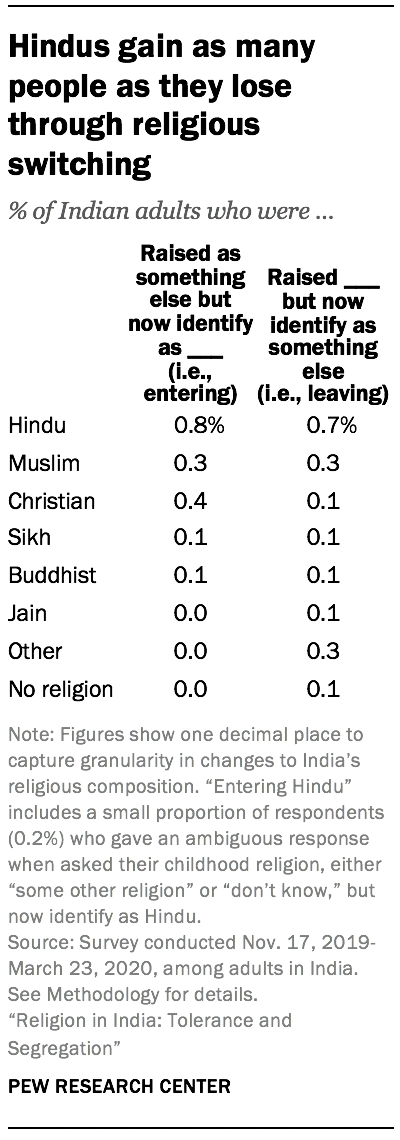
An overall pattern of stability in the share of religious groups is accompanied by little net gain from movement into, or out of, most religious groups. Among Hindus, for instance, any conversion out of the group is matched by conversion into the group: 0.7% of respondents say they were raised Hindu but now identify as something else, and although Hindu texts and traditions do not agree on any formal process for conversion into the religion, roughly the same share (0.8%) say they were not raised Hindu but now identify as Hindu. 5 Most of these new followers of Hinduism are married to Hindus.
Similarly, 0.3% of respondents have left Islam since childhood, matched by an identical share who say they were raised in other religions (or had no childhood religion) and have since become Muslim.
For Christians, however, there are some net gains from conversion: 0.4% of survey respondents are former Hindus who now identify as Christian, while 0.1% are former Christians.
Three-quarters of India’s Hindu converts to Christianity (74%) are concentrated in the Southern part of the country – the region with the largest Christian population. As a result, the Christian population of the South shows a slight increase within the lifetime of survey respondents: 6% of Southern Indians say they were raised Christian, while 7% say they are currently Christian.
Some Christian converts (16%) reside in the East as well (the states of Bihar, Jharkhand, Odisha and West Bengal); about two-thirds of all Christians in the East (64%) belong to Scheduled Tribes.
Nationally, the vast majority of former Hindus who are now Christian belong to Scheduled Castes (48%), Scheduled Tribes (14%) or Other Backward Classes (26%). And former Hindus are much more likely than the Indian population overall to say there is a lot of discrimination against lower castes in India. For example, nearly half of converts to Christianity (47%) say there is a lot of discrimination against Scheduled Castes in India, compared with 20% of the overall population who perceive this level of discrimination against Scheduled Castes. Still, relatively few converts say they, personally, have faced discrimination due to their caste in the last 12 months (12%).
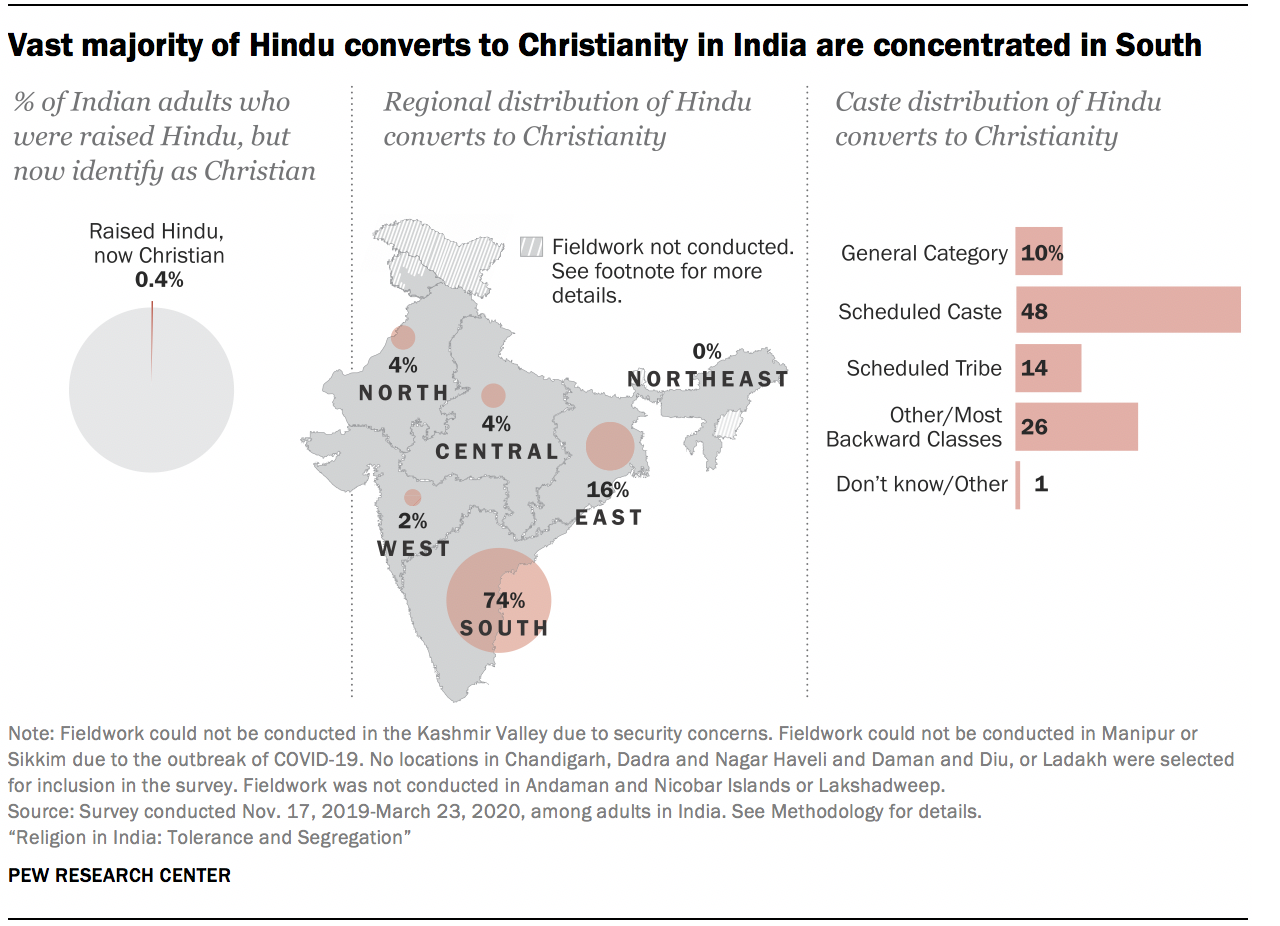
Though their specific practices and beliefs may vary, all of India’s major religious communities are highly observant by standard measures. For instance, the vast majority of Indians, across all major faiths, say that religion is very important in their lives. And at least three-quarters of each major religion’s followers say they know a great deal about their own religion and its practices. For example, 81% of Indian Buddhists claim a great deal of knowledge about the Buddhist religion and its practices.
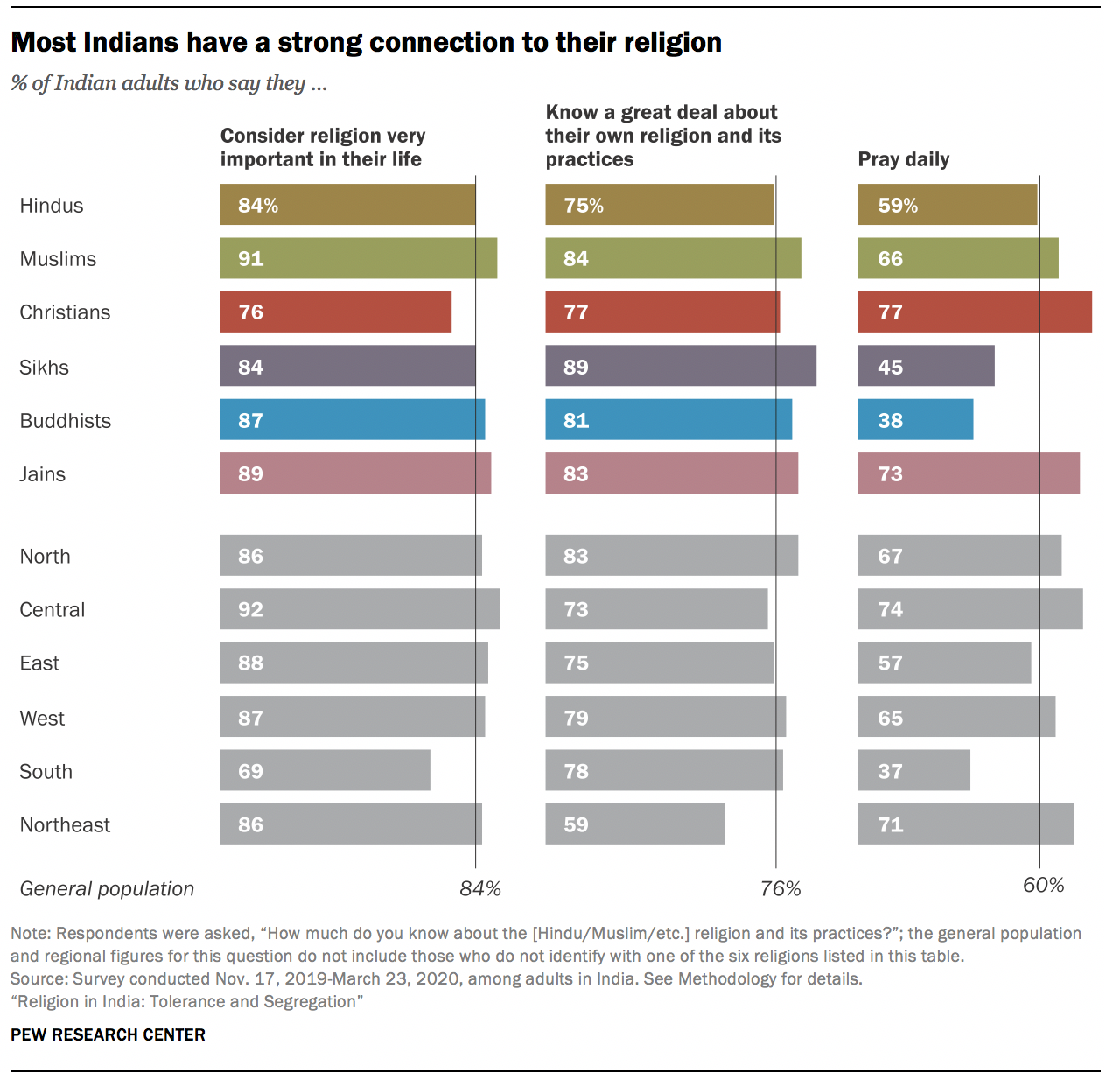
Indian Muslims are slightly more likely than Hindus to consider religion very important in their lives (91% vs. 84%). Muslims also are modestly more likely than Hindus to say they know a great deal about their own religion (84% vs. 75%).
Significant portions of each religious group also pray daily, with Christians among the most likely to do so (77%) – even though Christians are the least likely of the six groups to say religion is very important in their lives (76%). Most Hindus and Jains also pray daily (59% and 73%, respectively) and say they perform puja daily (57% and 81%), either at home or at a temple. 6
Generally, younger and older Indians, those with different educational backgrounds, and men and women are similar in their levels of religious observance. South Indians are the least likely to say religion is very important in their lives (69%), and the South is the only region where fewer than half of people report praying daily (37%). While Hindus, Muslims and Christians in the South are all less likely than their counterparts elsewhere in India to say religion is very important to them, the lower rate of prayer in the South is driven mainly by Hindus: Three-in-ten Southern Hindus report that they pray daily (30%), compared with roughly two-thirds (68%) of Hindus in the rest of the country (see “ People in the South differ from rest of the country in their views of religion, national identity ” below for further discussion of religious differences in Southern India).
The survey also asked about three rites of passage: religious ceremonies for birth (or infancy), marriage and death. Members of all of India’s major religious communities tend to see these rites as highly important. For example, the vast majority of Muslims (92%), Christians (86%) and Hindus (85%) say it is very important to have a religious burial or cremation for their loved ones.
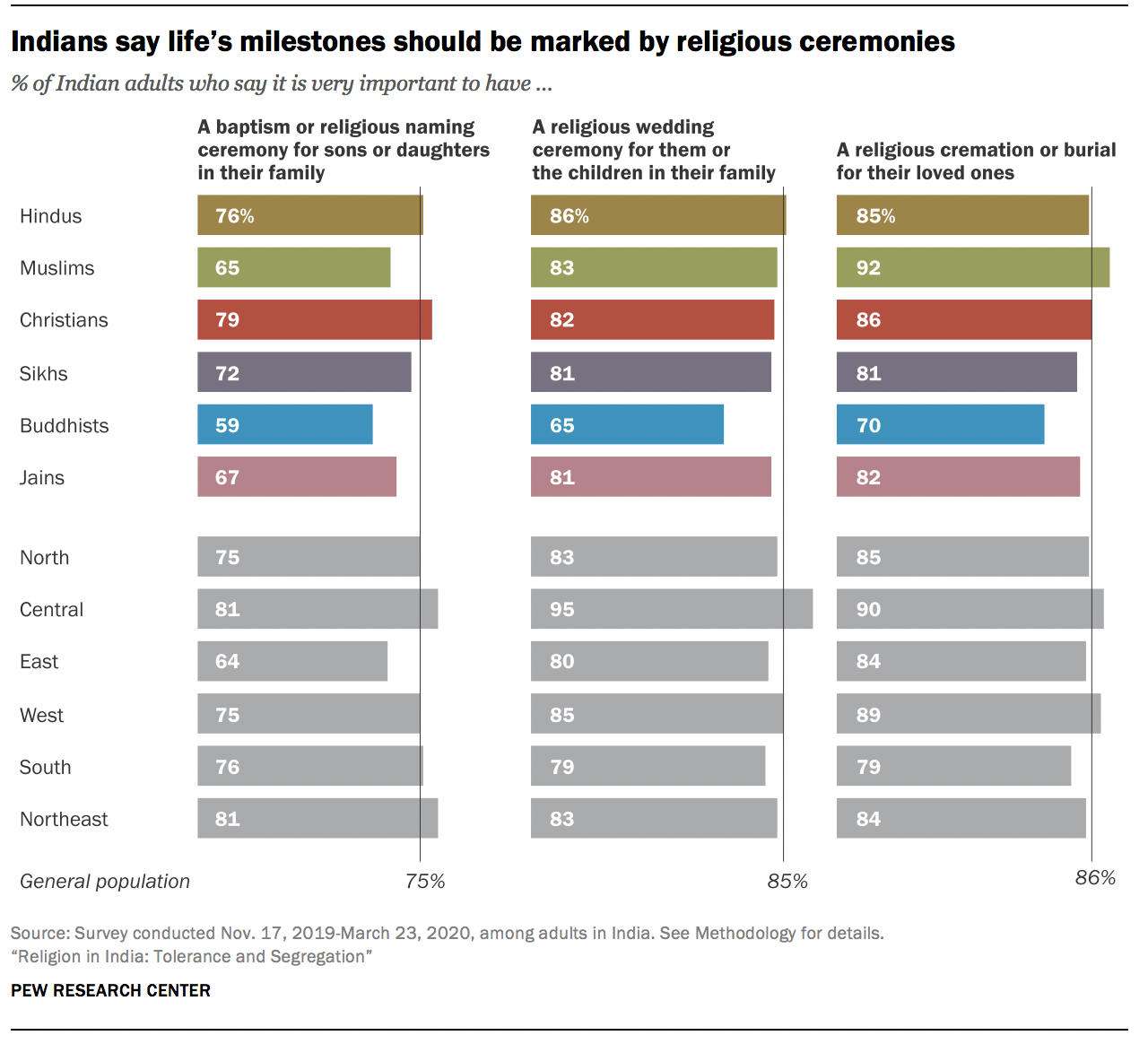
The survey also asked about practices specific to particular religions, such as whether people have received purification by bathing in holy bodies of water, like the Ganges River, a rite closely associated with Hinduism. About two-thirds of Hindus have done this (65%). Most Hindus also have holy basil (the tulsi plant) in their homes, as do most Jains (72% and 62%, respectively). And about three-quarters of Sikhs follow the Sikh practice of keeping their hair long (76%).
For more on religious practices across India’s religious groups, see Chapter 7 .
Nearly all Indians say they believe in God (97%), and roughly 80% of people in most religious groups say they are absolutely certain that God exists. The main exception is Buddhists, one-third of whom say they do not believe in God. Still, among Buddhists who do think there is a God, most say they are absolutely certain in this belief.
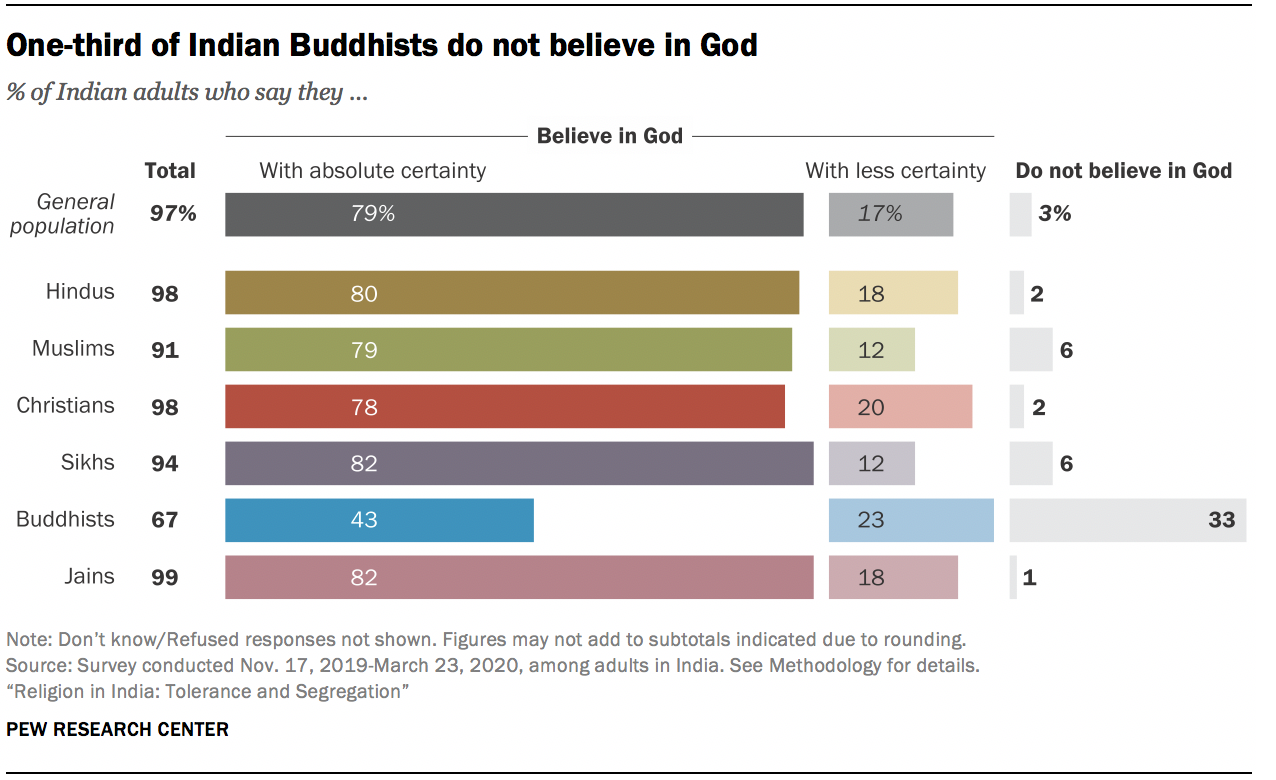
While belief in God is close to universal in India, the survey finds a wide range of views about the type of deity or deities that Indians believe in. The prevailing view is that there is one God “with many manifestations” (54%). But about one-third of the public says simply: “There is only one God” (35%). Far fewer say there are many gods (6%).
Even though Hinduism is sometimes referred to as a polytheistic religion , very few Hindus (7%) take the position that there are multiple gods. Instead, the most common position among Hindus (as well as among Jains) is that there is “only one God with many manifestations” (61% among Hindus and 54% among Jains).
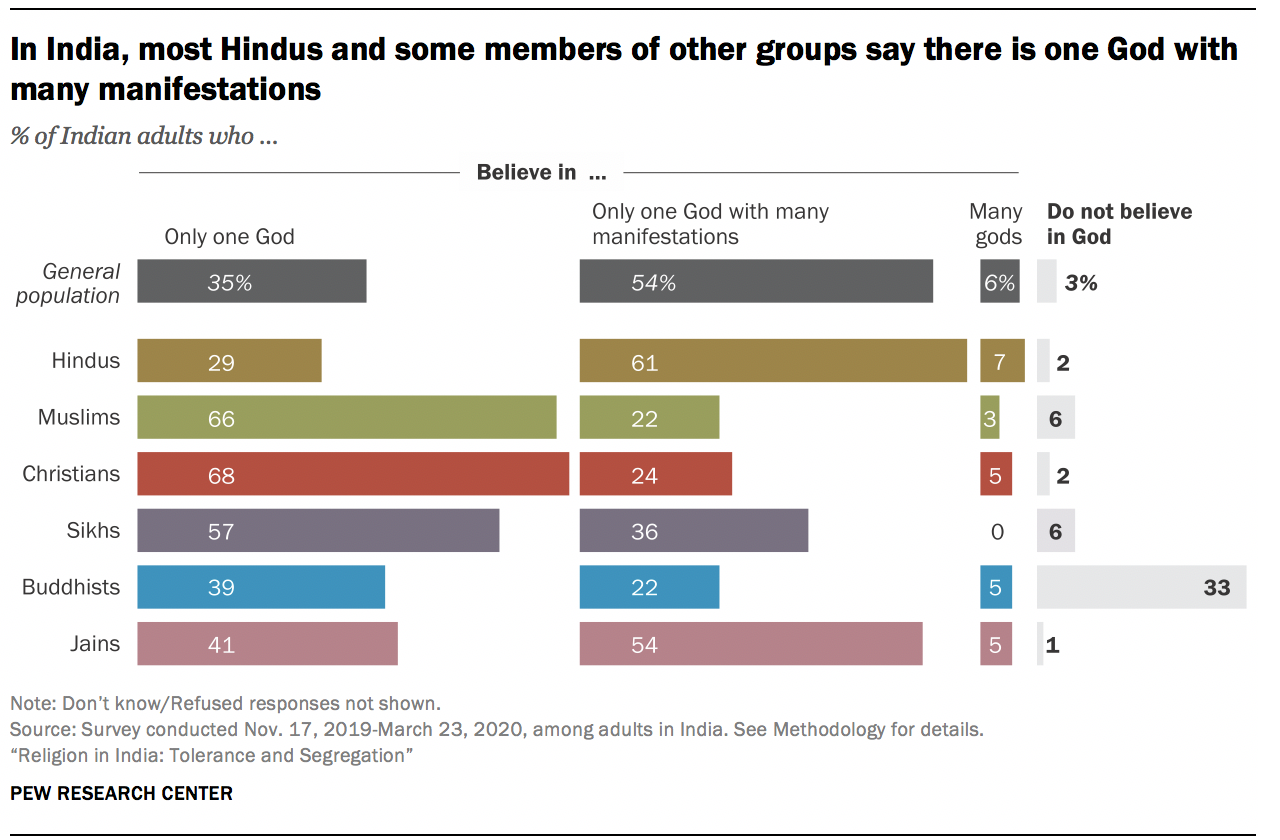
Among Hindus, those who say religion is very important in their lives are more likely than other Hindus to believe in one God with many manifestations (63% vs. 50%) and less likely to say there are many gods (6% vs. 12%).
By contrast, majorities of Muslims, Christians and Sikhs say there is only one God. And among Buddhists, the most common response is also a belief in one God. Among all these groups, however, about one-in-five or more say God has many manifestations, a position closer to their Hindu compatriots’ concept of God.
Most Hindus feel close to multiple gods, but Shiva, Hanuman and Ganesha are most popular
Traditionally, many Hindus have a “personal god,” or ishta devata: A particular god or goddess with whom they feel a personal connection. The survey asked all Indian Hindus who say they believe in God which god they feel closest to – showing them 15 images of gods on a card as possible options – and the vast majority of Hindus selected more than one god or indicated that they have many personal gods (84%). 7 This is true not only among Hindus who say they believe in many gods (90%) or in one God with many manifestations (87%), but also among those who say there is only one God (82%).
The god that Hindus most commonly feel close to is Shiva (44%). In addition, about one-third of Hindus feel close to Hanuman or Ganesha (35% and 32%, respectively).
There is great regional variation in how close India’s Hindus feel to some gods. For example, 46% of Hindus in India’s West feel close to Ganesha, but only 15% feel this way in the Northeast. And 46% of Hindus in the Northeast feel close to Krishna, while just 14% in the South say the same.
Feelings of closeness for Lord Ram are especially strong in the Central region (27%), which includes what Hindus claim is his ancient birthplace , Ayodhya. The location in Ayodhya where many Hindus believe Ram was born has been a source of controversy: Hindu mobs demolished a mosque on the site in 1992, claiming that a Hindu temple originally existed there. In 2019, the Indian Supreme Court ruled that the demolished mosque had been built on top of a preexisting non-Islamic structure and that the land should be given to Hindus to build a temple, with another location in the area given to the Muslim community to build a new mosque. (For additional findings on belief in God, see Chapter 12 .)
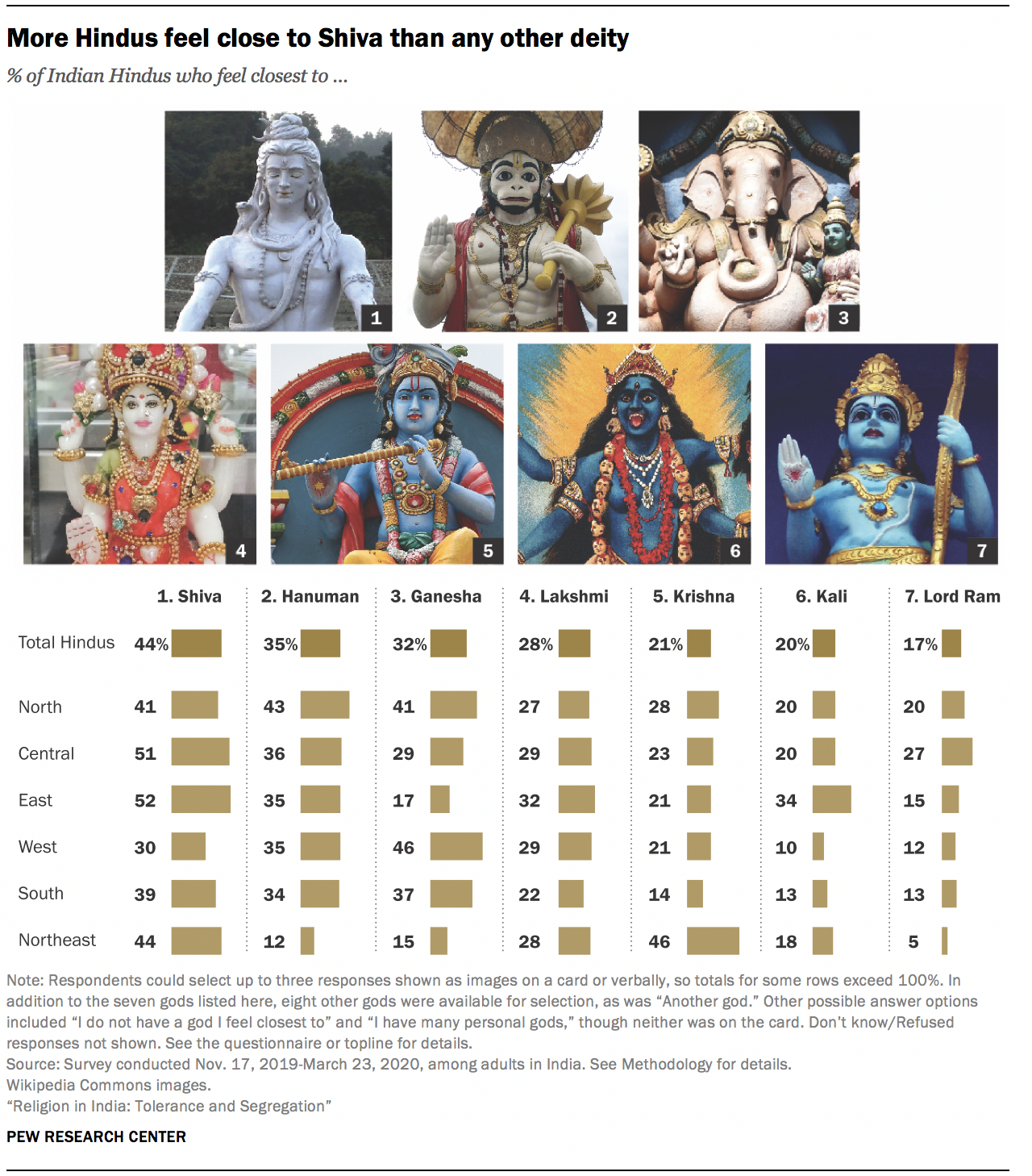
Sidebar: Despite economic advancement, few signs that importance of religion is declining
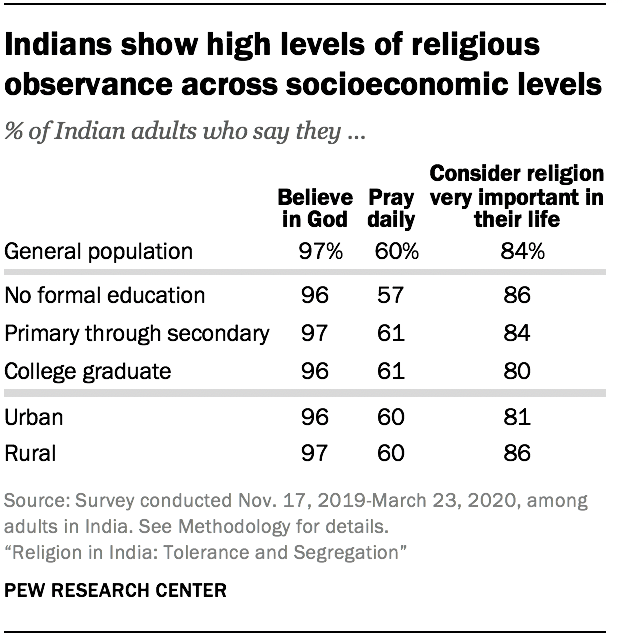
A prominent theory in the social sciences hypothesizes that as countries advance economically, their populations tend to become less religious, often leading to wider social change. Known as “secularization theory,” it particularly reflects the experience of Western European countries from the end of World War II to the present.
Despite rapid economic growth, India’s population so far shows few, if any, signs of losing its religion. For instance, both the Indian census and the new survey find virtually no growth in the minuscule share of people who claim no religious identity. And religion is prominent in the lives of Indians regardless of their socioeconomic status. Generally, across the country, there is little difference in personal religious observance between urban and rural residents or between those who are college educated versus those who are not. Overwhelming shares among all these groups say that religion is very important in their lives, that they pray regularly and that they believe in God.
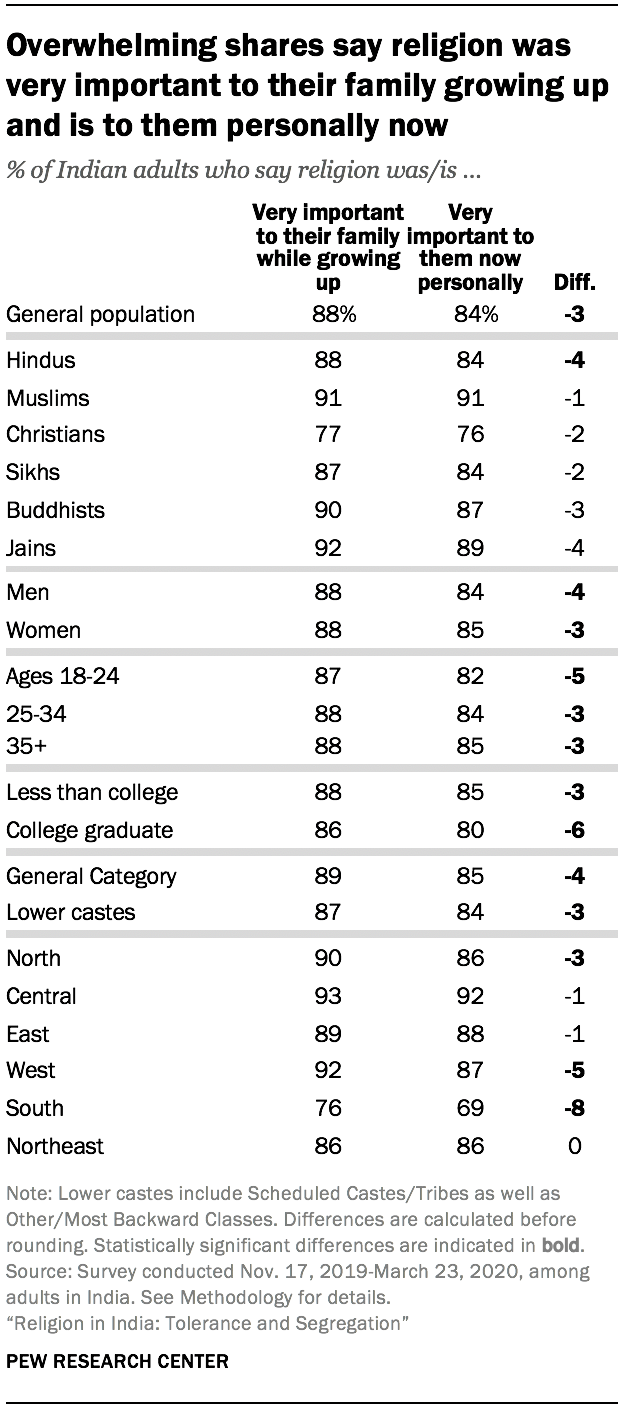
Nearly all religious groups show the same patterns. The biggest exception is Christians, among whom those with higher education and those who reside in urban areas show somewhat lower levels of observance. For example, among Christians who have a college degree, 59% say religion is very important in their life, compared with 78% among those who have less education.
The survey does show a slight decline in the perceived importance of religion during the lifetime of respondents, though the vast majority of Indians indicate that religion remains central to their lives, and this is true among both younger and older adults.
Nearly nine-in-ten Indian adults say religion was very important to their family when they were growing up (88%), while a slightly lower share say religion is very important to them now (84%). The pattern is identical when looking only at India’s majority Hindu population. Among Muslims in India, the same shares say religion was very important to their family growing up and is very important to them now (91% each).
The states of Southern India (Andhra Pradesh, Karnataka, Kerala, Puducherry, Tamil Nadu and Telangana) show the biggest downward trend in the perceived importance of religion over respondents’ lifetimes: 76% of Indians who live in the South say religion was very important to their family growing up, compared with 69% who say religion is personally very important to them now. Slight declines in the importance of religion, by this measure, also are seen in the Western part of the country (Goa, Gujarat and Maharashtra) and in the North, although large majorities in all regions of the country say religion is very important in their lives today.
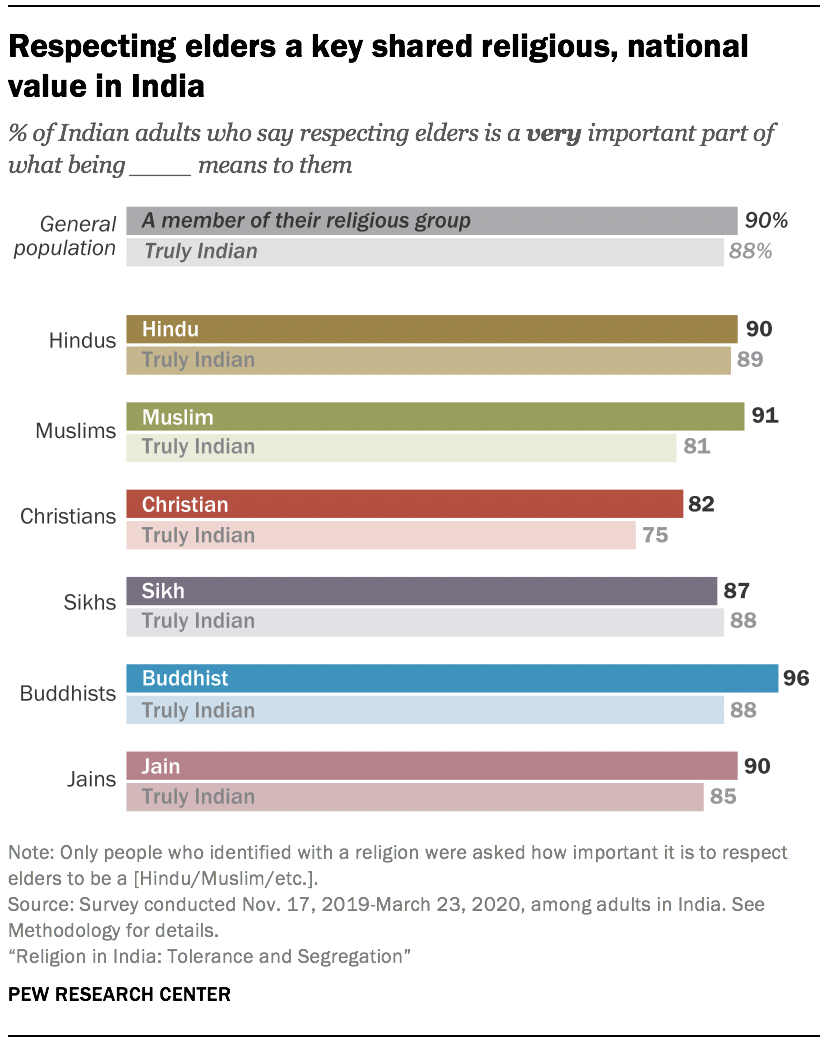
Despite a strong desire for religious segregation, India’s religious groups share patriotic feelings, cultural values and some religious beliefs. For instance, overwhelming shares across India’s religious communities say they are very proud to be Indian, and most agree that Indian culture is superior to others.
Similarly, Indians of different religious backgrounds hold elders in high respect. For instance, nine-in-ten or more Hindus, Muslims, Buddhists and Jains say that respecting elders is very important to what being a member of their religious group means to them (e.g., for Hindus, it’s a very important part of their Hindu identity). Christians and Sikhs also overwhelmingly share this sentiment. And among all people surveyed in all six groups, three-quarters or more say that respecting elders is very important to being truly Indian.
Within all six religious groups, eight-in-ten or more also say that helping the poor and needy is a crucial part of their religious identity.
Beyond cultural parallels, many people mix traditions from multiple religions into their practices: As a result of living side by side for generations, India’s minority groups often engage in practices that are more closely associated with Hindu traditions than their own. For instance, many Muslim, Sikh and Christian women in India say they wear a bindi (a forehead marking, often worn by married women), even though putting on a bindi has Hindu origins.
Similarly, many people embrace beliefs not traditionally associated with their faith: Muslims in India are just as likely as Hindus to say they believe in karma (77% each), and 54% of Indian Christians share this view. 8 Nearly three-in-ten Muslims and Christians say they believe in reincarnation (27% and 29%, respectively). While these may seem like theological contradictions, for many Indians, calling oneself a Muslim or a Christian does not preclude believing in karma or reincarnation – beliefs that do not have a traditional, doctrinal basis in Islam or Christianity.
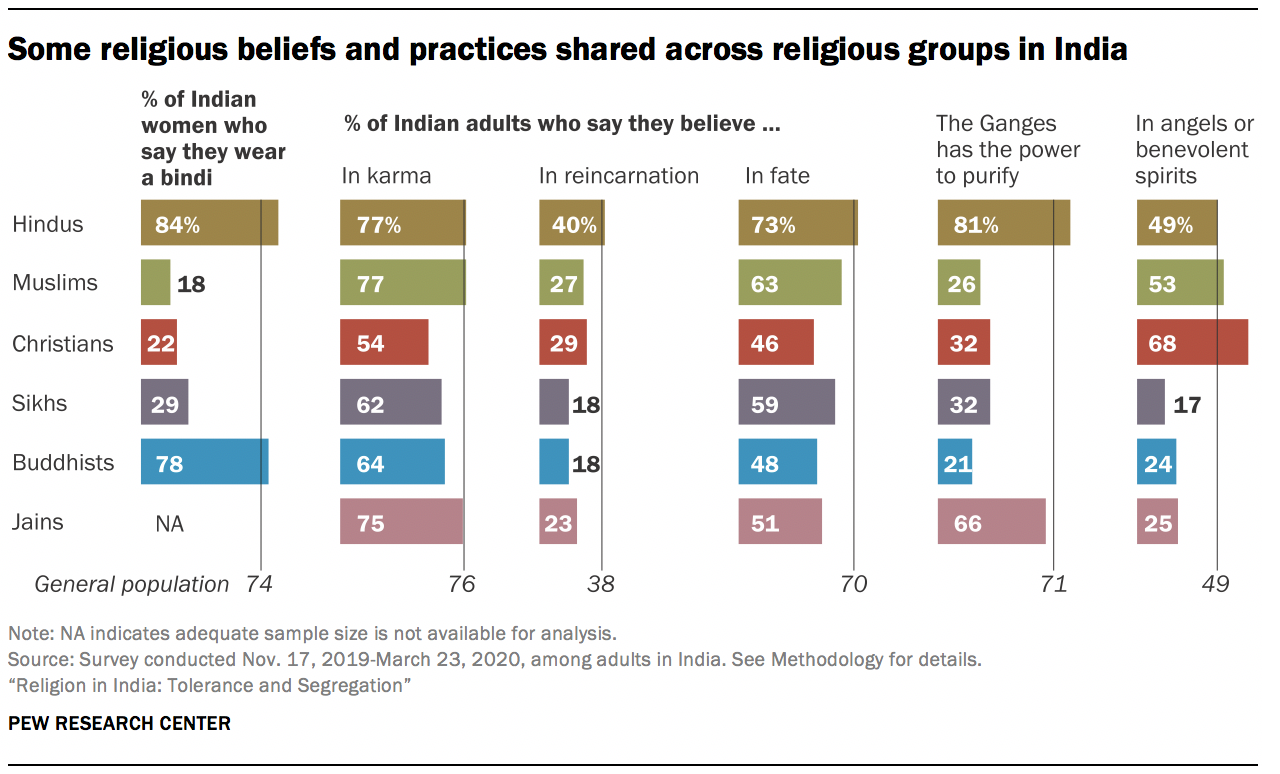
Most Muslims and Christians say they don’t participate in celebrations of Diwali, the Indian festival of lights that is traditionally celebrated by Hindus, Sikhs, Jains and Buddhists. But substantial minorities of Christians (31%) and Muslims (20%) report that they do celebrate Diwali. Celebrating Diwali is especially common among Muslims in the West, where 39% say they participate in the festival, and in the South (33%).
Not only do some followers of all these religions participate in a celebration (Diwali) that consumes most of the country once a year, but some members of the majority Hindu community celebrate Muslim and Christian festivals, too: 7% of Indian Hindus say they celebrate the Muslim festival of Eid, and 17% celebrate Christmas.
While there is some mixing of religious celebrations and traditions within India’s diverse population, many Hindus do not approve of this. In fact, while 17% of the nation’s Hindus say they participate in Christmas celebrations, about half of Hindus (52%) say that doing so disqualifies a person from being Hindu (compared with 35% who say a person can be Hindu if they celebrate Christmas). An even greater share of Hindus (63%) say a person cannot be Hindu if they celebrate the Islamic festival of Eid – a view that is more widely held in Northern, Central, Eastern and Northeastern India than the South or West.
Hindus are divided on whether beliefs and practices such as believing in God, praying and going to the temple are necessary to be a Hindu. But one behavior that a clear majority of Indian Hindus feel is incompatible with Hinduism is eating beef: 72% of Hindus in India say a person who eats beef cannot be a Hindu. That is even higher than the percentages of Hindus who say a person cannot be Hindu if they reject belief in God (49%), never go to a temple (48%) or never perform prayers (48%).
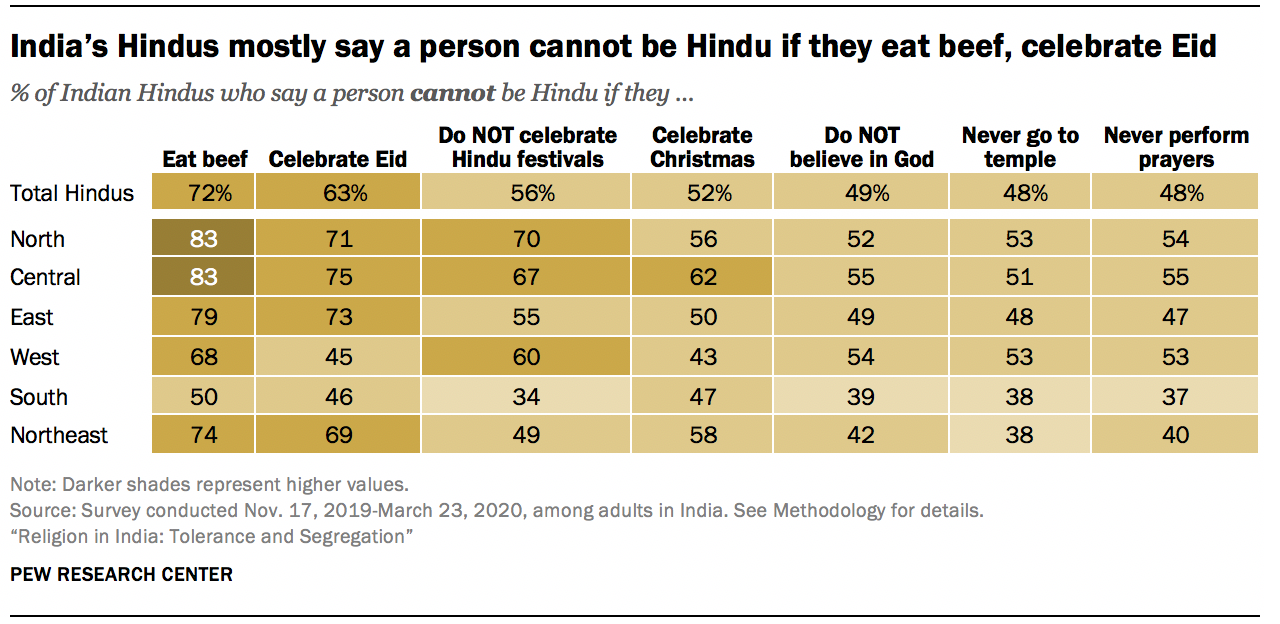
Attitudes toward beef appear to be part of a regional and cultural divide among Hindus: Southern Indian Hindus are considerably less likely than others to disqualify beef eaters from being Hindu (50% vs. 83% in the Northern and Central parts of the country). And, at least in part, Hindus’ views on beef and Hindu identity are linked with a preference for religious segregation and elements of Hindu nationalism. For example, Hindus who take a strong position against eating beef are more likely than others to say they would not accept followers of other religions as their neighbors (49% vs. 30%) and to say it is very important to be Hindu to be truly Indian (68% vs. 51%).
Relatedly, 44% of Hindus say they are vegetarians, and an additional 33% say they abstain from eating certain meats. Hindus traditionally view cows as sacred, and laws pertaining to cow slaughter have been a recent flashpoint in India . At the same time, Hindus are not alone in linking beef consumption with religious identity: 82% of Sikhs and 85% of Jains surveyed say that a person who eats beef cannot be a member of their religious groups, either. A majority of Sikhs (59%) and fully 92% of Jains say they are vegetarians, including 67% of Jains who do not eat root vegetables . 9 (For more data on religion and dietary habits, see Chapter 10 .)
Sidebar: People in the South differ from rest of the country in their views of religion, national identity
The survey consistently finds that people in the South (the states of Andhra Pradesh, Karnataka, Kerala, Tamil Nadu and Telangana, and the union territory of Puducherry) differ from Indians elsewhere in the country in their views on religion, politics and identity.
For example, by a variety of measures, people in the South are somewhat less religious than those in other regions – 69% say religion is very important in their lives, versus 92% in the Central part of the country. And 37% say they pray every day, compared with more than half of Indians in other regions. People in the South also are less segregated by religion or caste – whether that involves their friendship circles, the kind of neighbors they prefer or how they feel about intermarriage. (See Chapter 3 .)
Hindu nationalist sentiments also appear to have less of a foothold in the South. Among Hindus, those in the South (42%) are far less likely than those in Central states (83%) or the North (69%) to say being Hindu is very important to be truly Indian. And in the 2019 parliamentary elections, the BJP’s lowest vote share came in the South. In the survey, just 19% of Hindus in the region say they voted for the BJP, compared with roughly two-thirds in the Northern (68%) and Central (65%) parts of the country who say they voted for the ruling party.
Culturally and politically, people in the South have pushed back against the BJP’s restrictions on cow slaughter and efforts to nationalize the Hindi language . These factors may contribute to the BJP’s lower popularity in the South, where more people prefer regional parties or the Indian National Congress party.
These differences in attitudes and practices exist in a wider context of economic disparities between the South and other regions of the country. Over time, Southern states have seen stronger economic growth than the Northern and Central parts of the country. And women and people belonging to lower castes in the South have fared better economically than their counterparts elsewhere in the country. Even though three-in-ten people in the South say there is widespread caste discrimination in India, the region also has a history of anti-caste movements . Indeed, one author has attributed the economic growth of the South largely to the flattening of caste hierarchies.
Muslim identity in India
Most Muslims in India say a person cannot be Muslim if they never pray or attend a mosque. Similarly, about six-in-ten say that celebrating Diwali or Christmas is incompatible with being a member of the Muslim community. At the same time, a substantial minority express a degree of open-mindedness on who can be a Muslim, with fully one-third (34%) saying a person can be Muslim even if they don’t believe in God. (The survey finds that 6% of self-described Muslims in India say they do not believe in God; see “ Near-universal belief in God, but wide variation in how God is perceived ” above.)
Like Hindus, Muslims have dietary restrictions that resonate as powerful markers of identity. Three-quarters of Indian Muslims (77%) say that a person cannot be Muslim if they eat pork, which is even higher than the share who say a person cannot be Muslim if they do not believe in God (60%) or never attend mosque (61%).
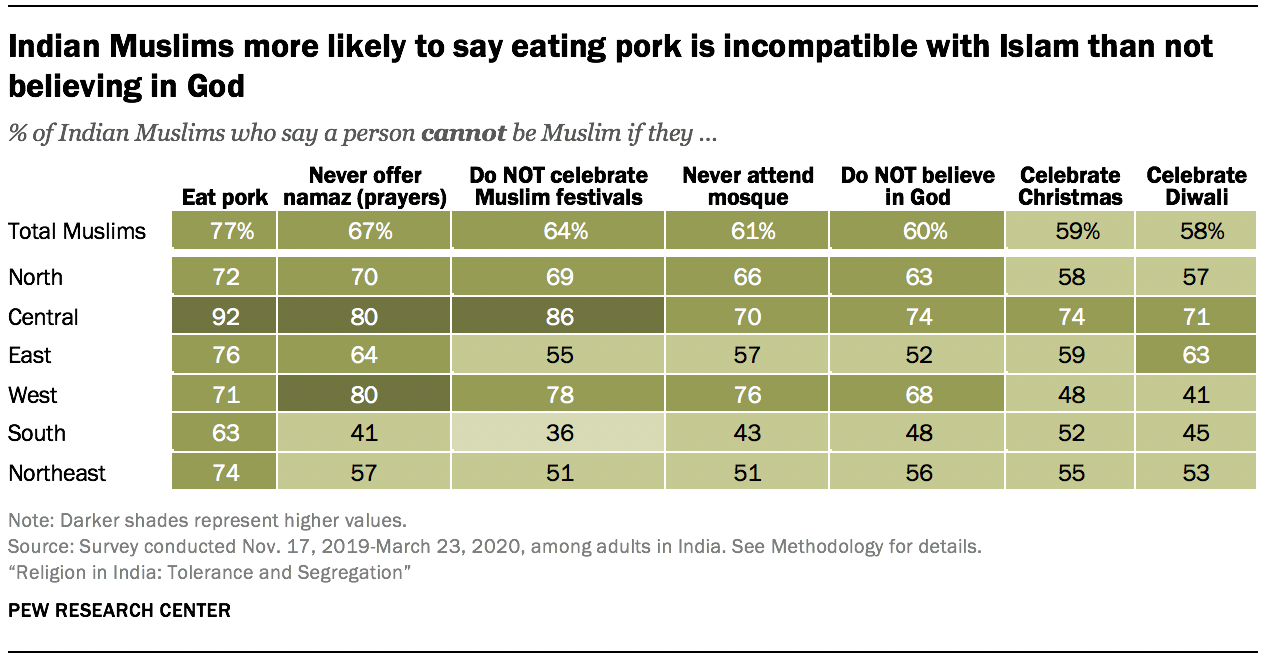
Indian Muslims also report high levels of religious commitment by a host of conventional measures: 91% say religion is very important in their lives, two-thirds (66%) say they pray at least once a day, and seven-in-ten say they attend mosque at least once a week – with even higher attendance among Muslim men (93%).
By all these measures, Indian Muslims are broadly comparable to Muslims in the neighboring Muslim-majority countries of Pakistan and Bangladesh, according to a Pew Research Center survey conducted in those countries in late 2011 and early 2012. In Pakistan, for example, 94% of Muslims said religion is very important in their lives , while 81% of Bangladeshi Muslims said the same. Muslims in India are somewhat more likely than those elsewhere in South Asia to say they regularly worship at a mosque (70% in India vs. 59% in Pakistan and 53% in Bangladesh), with the difference mainly driven by the share of women who attend.
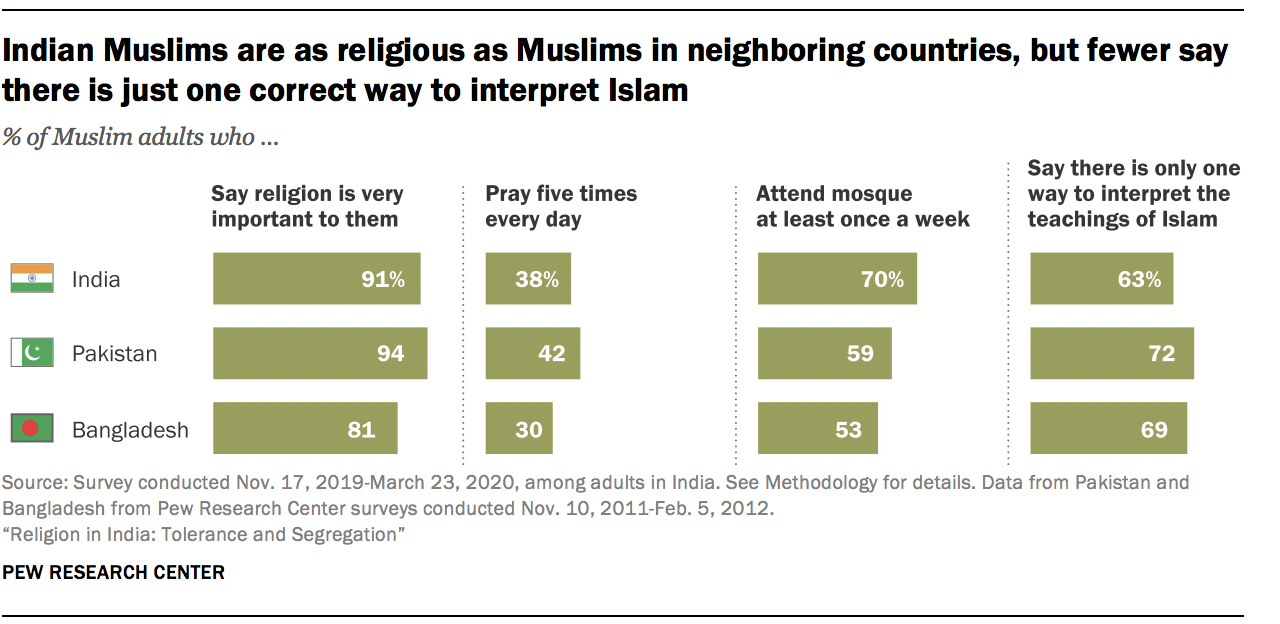
At the same time, Muslims in India are slightly less likely to say there is “only one true” interpretation of Islam (72% in Pakistan, 69% in Bangladesh, 63% in India), as opposed to multiple interpretations.
When it comes to their religious beliefs, Indian Muslims in some ways resemble Indian Hindus more than they resemble Muslims in neighboring countries. For example, Muslims in Pakistan and Bangladesh almost universally say they believe in heaven and angels, but Indian Muslims seem more skeptical: 58% say they believe in heaven and 53% express belief in angels. Among Indian Hindus, similarly, 56% believe in heaven and 49% believe in angels.
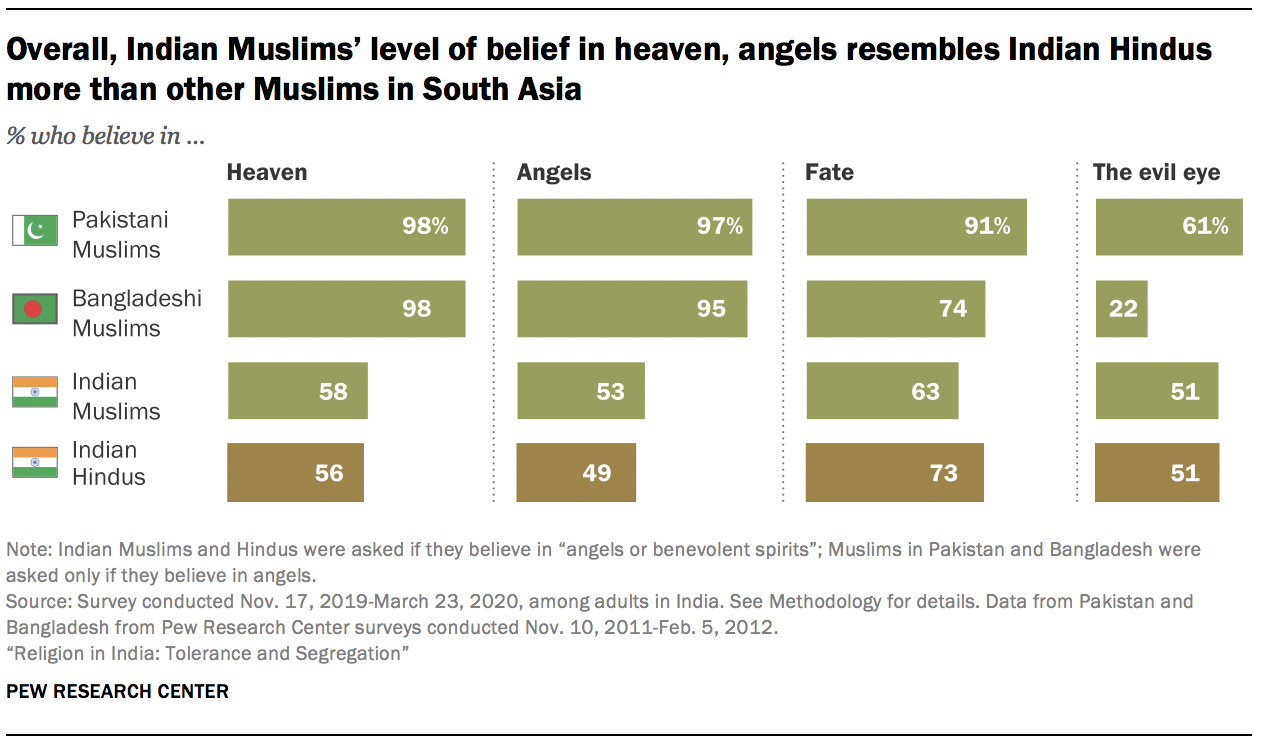
Majority of Muslim women in India oppose ‘triple talaq’ (Islamic divorce)
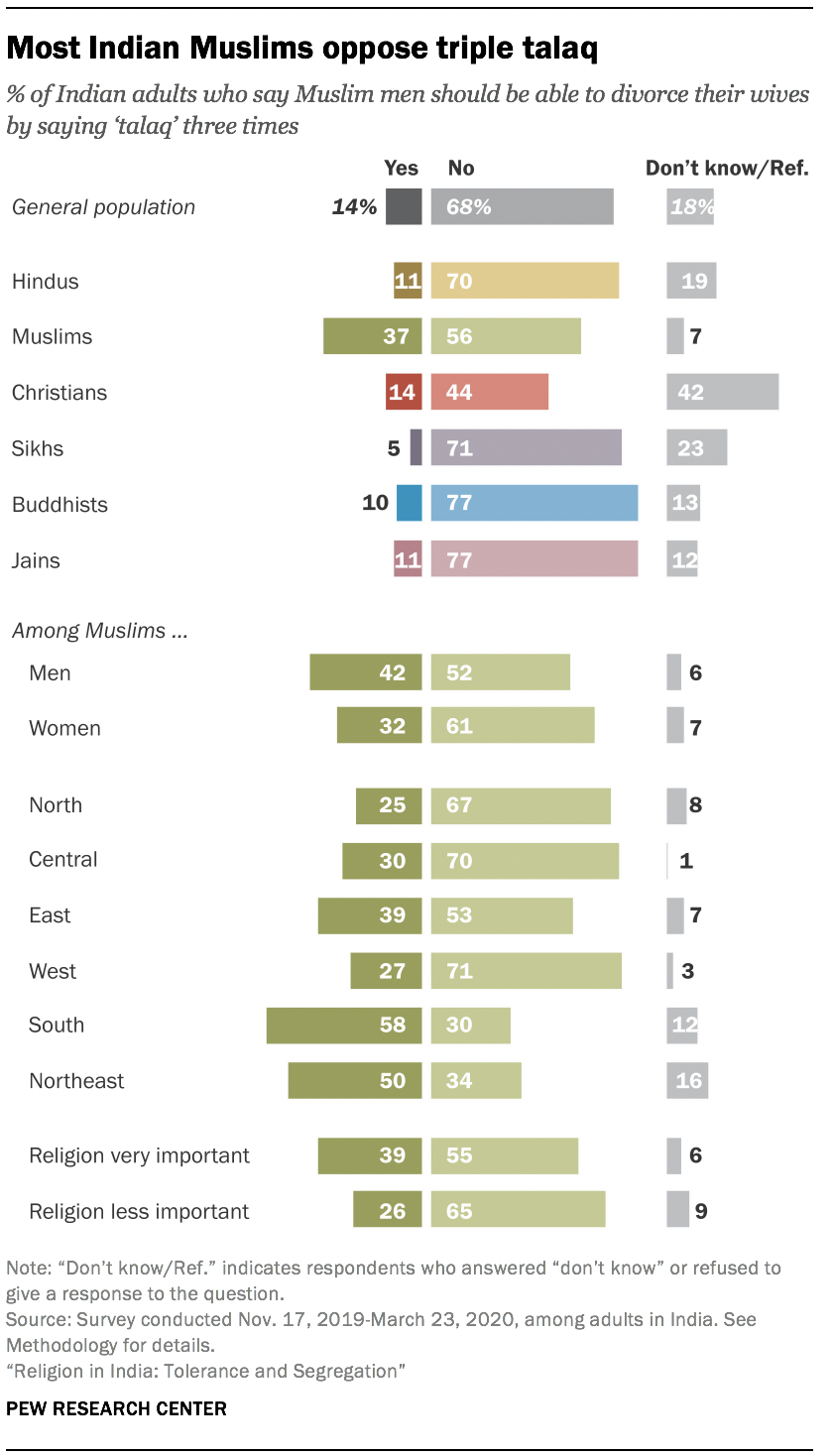
Many Indian Muslims historically have followed the Hanafi school of thought, which for centuries allowed men to divorce their wives by saying “talaq” (which translates as “divorce” in Arabic and Urdu) three times. Traditionally, there was supposed to be a waiting period and attempts at reconciliation in between each use of the word, and it was deeply frowned upon (though technically permissible) for a man to pronounce “talaq” three times quickly in a row. India’s Supreme Court ruled triple talaq unconstitutional in 2017, and it was banned by legislation in 2019 .
Most Indian Muslims (56%) say Muslim men should not be allowed to divorce this way. Still, 37% of Indian Muslims say they support triple talaq, with Muslim men (42%) more likely than Muslim women (32%) to take this position. A majority of Muslim women (61%) oppose triple talaq.
Highly religious Muslims – i.e., those who say religion is very important in their lives – also are more likely than other Muslims to say Muslim men should be able to divorce their wives simply by saying “talaq” three times (39% vs. 26%).
Triple talaq seems to have the most support among Muslims in the Southern and Northeastern regions of India, where half or more of Muslims say it should be legal (58% and 50%, respectively), although 12% of Muslims in the South and 16% in the Northeast do not take a position on the issue either way.
Sikhism is one of four major religions – along with Hinduism, Buddhism and Jainism – that originated on the Indian subcontinent. The Sikh religion emerged in Punjab in the 15th century, when Guru Nanak, who is revered as the founder of Sikhism, became the first in a succession of 10 gurus (teachers) in the religion.
Today, India’s Sikhs remain concentrated in the state of Punjab. One feature of the Sikh religion is a distinctive sense of community, also known as “Khalsa” (which translates as “ones who are pure”). Observant Sikhs differentiate themselves from others in several ways, including keeping their hair uncut. Today, about three-quarters of Sikh men and women in India say they keep their hair long (76%), and two-thirds say it is very important to them that children in their families also keep their hair long (67%). (For more analysis of Sikhs’ views on passing religious traditions on to their children, see Chapter 8 .)
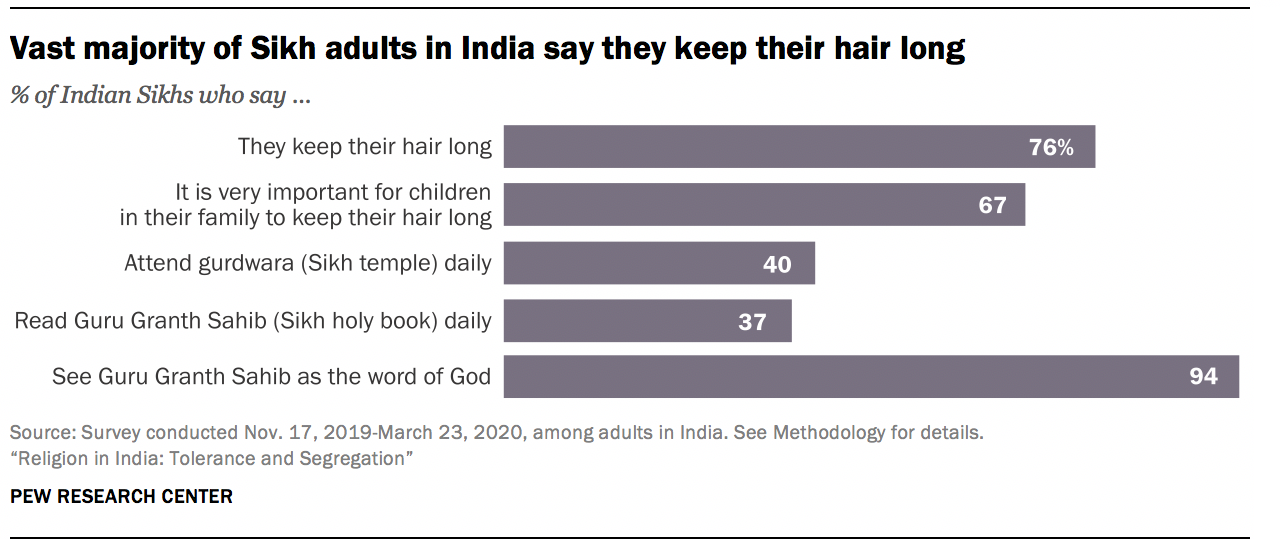
Sikhs are more likely than Indian adults overall to say they attend religious services every day – 40% of Sikhs say they go to the gurdwara (Sikh house of worship) daily. By comparison, 14% of Hindus say they go to a Hindu temple every day. Moreover, the vast majority of Sikhs (94%) regard their holy book, the Guru Granth Sahib, as the word of God, and many (37%) say they read it, or listen to recitations of it, every day.
Sikhs in India also incorporate other religious traditions into their practice. Some Sikhs (9%) say they follow Sufi orders, which are linked with Islam, and about half (52%) say they have a lot in common with Hindus. Roughly one-in-five Indian Sikhs say they have prayed, meditated or performed a ritual at a Hindu temple.
Sikh-Hindu relations were marked by violence in the 1970s and 1980s, when demands for a separate Sikh state covering the Punjab regions in both India and Pakistan (also known as the Khalistan movement) reached their apex. In 1984, Prime Minister Indira Gandhi was assassinated by her Sikh bodyguards as revenge for Indian paramilitary forces storming the Sikh Golden Temple in pursuit of Sikh militants. Anti-Sikh riots ensued in Northern India, especially in the state of Punjab.
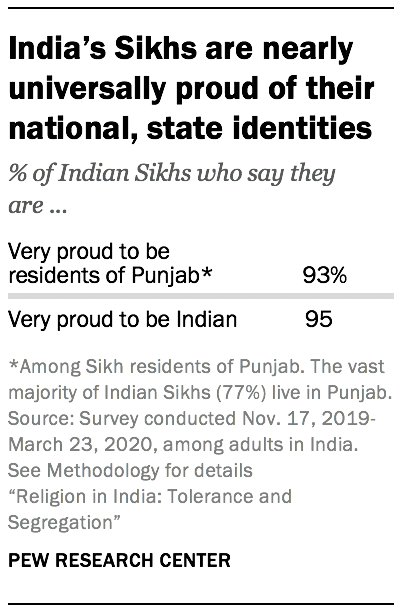
According to the Indian census, the vast majority of Sikhs in India (77%) still live in Punjab, where Sikhs make up 58% of the adult population. And 93% of Punjabi Sikhs say they are very proud to live in the state.
Sikhs also are overwhelmingly proud of their Indian identity. A near-universal share of Sikhs say they are very proud to be Indian (95%), and the vast majority (70%) say a person who disrespects India cannot be a Sikh. And like India’s other religious groups, most Sikhs do not see evidence of widespread discrimination against their community – just 14% say Sikhs face a lot of discrimination in India, and 18% say they personally have faced religious discrimination in the last year.
At the same time, Sikhs are more likely than other religious communities to see communal violence as a very big problem in the country. Nearly eight-in-ten Sikhs (78%) rate communal violence as a major issue, compared with 65% of Hindus and Muslims.
The BJP has attempted to financially compensate Sikhs for some of the violence that occurred in 1984 after Indira Gandhi’s assassination, but relatively few Sikh voters (19%) report having voted for the BJP in the 2019 parliamentary elections. The survey finds that 33% of Sikhs preferred the Indian National Congress Party – Gandhi’s party.
- Ahmed, Hilal. 2019. “ Siyasi Muslims: A story of political Islams in India .” ↩
- All survey respondents, regardless of religion, were asked, “Are you from a General Category, Scheduled Caste, Scheduled Tribe or Other Backward Class?” By contrast, in the 2011 census of India, only Hindus, Sikhs and Buddhists could be enumerated as members of Scheduled Castes, while Scheduled Tribes could include followers of all religions. General Category and Other Backward Classes were not measured in the census. A detailed analysis of differences between 2011 census data on caste and survey data can be found here . ↩
- According to the 2004 and 2009 National Election Studies by the Centre for the Study of Developing Societies (CSDS), roughly half of Indians or more said that marriages of boys and girls from different castes should be banned . In 2004, a majority also said this about people from different religions. ↩
- In both the 2004 and 2009 National Election Studies (organized by CSDS), roughly half of Indians said that “There should be a legal ban on religious conversions.” ↩
- This includes 0.2% of all Indian adults who now identify as Hindu but give an ambiguous response on how they were raised – either saying “some other religion” or saying they don’t know their childhood religion. ↩
- Puja is a specific worship ritual that involves prayer along with rites like offering flowers and food, using vermillion, singing and chanting. ↩
- Fifteen named deities were available for selection, though no answer options were read aloud. Respondents could select up to three of those 15 deities by naming them or selecting the corresponding image shown on a card. The answer option “another god” was available on the card or if any other deity name was volunteered by the respondent. Other possible answer options included “I do not have a god I feel closest to” and “I have many personal gods,” though neither was on the card. See the questionnaire or topline for the full list of gods offered. ↩
- The religious origins of karma are debated by scholars, but the concept has deep roots in Hinduism, Buddhism, Sikhism and Jainism. ↩
- For an analysis of Jain theology on the concept of jiva (soul) see Chapple, Christopher K. 2014. “Life All Around: Soul in Jainism.” In Biernacki, Loriliai and Philip Clayton, eds. “ Panentheism Across the World’s Traditions .” ↩
Sign up for our weekly newsletter
Fresh data delivery Saturday mornings
Sign up for The Briefing
Weekly updates on the world of news & information
- Beliefs & Practices
- Christianity
- International Political Values
- International Religious Freedom & Restrictions
- Interreligious Relations
- Other Religions
- Pew-Templeton Global Religious Futures Project
- Religious Characteristics of Demographic Groups
- Religious Identity & Affiliation
- Religiously Unaffiliated
- Size & Demographic Characteristics of Religious Groups
How common is religious fasting in the United States?
8 facts about atheists, spirituality among americans, how people in south and southeast asia view religious diversity and pluralism, religion among asian americans, most popular, report materials.
- Questionnaire
- Overview (Hindi)
- இந்தியாவில் மதம்: சகிப்புத்தன்மையும் தனிப்படுத்துதலும்
- भारत में धर्म: सहिष्णुता और अलगाव
- ভারতে ধর্ম: সহনশীলতা এবং পৃথকীকরণ
- भारतातील धर्म : सहिष्णुता आणि विलग्नता
- Related: Religious Composition of India
- How Pew Research Center Conducted Its India Survey
- Questionnaire: Show Cards
- India Survey Dataset
1615 L St. NW, Suite 800 Washington, DC 20036 USA (+1) 202-419-4300 | Main (+1) 202-857-8562 | Fax (+1) 202-419-4372 | Media Inquiries
Research Topics
- Age & Generations
- Coronavirus (COVID-19)
- Economy & Work
- Family & Relationships
- Gender & LGBTQ
- Immigration & Migration
- International Affairs
- Internet & Technology
- Methodological Research
- News Habits & Media
- Non-U.S. Governments
- Other Topics
- Politics & Policy
- Race & Ethnicity
- Email Newsletters
ABOUT PEW RESEARCH CENTER Pew Research Center is a nonpartisan fact tank that informs the public about the issues, attitudes and trends shaping the world. It conducts public opinion polling, demographic research, media content analysis and other empirical social science research. Pew Research Center does not take policy positions. It is a subsidiary of The Pew Charitable Trusts .
Copyright 2024 Pew Research Center
Terms & Conditions
Privacy Policy
Cookie Settings
Reprints, Permissions & Use Policy

Unity in Diversity: The Essence of India’s Composite Culture | Essay Writing for UPSC by Vikash Ranjan Sir | Triumph ias
Table of Contents
India’s Mosaic: A Celebration of Unity in Diversity
(relevant for essay writing for upsc civil services examination).
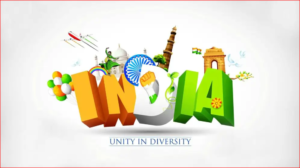
India’s vibrant landscape is dotted with myriad cultures, traditions, and histories. Dive into the mesmerizing mosaic of India’s composite culture and discover how it epitomizes unity in diversity.
The Threads of Time
From the ancient Indus Valley Civilization to modern-day India, the country has imbibed, evolved, and celebrated a myriad of influences, giving birth to its unique identity.
A Symphony of Cultures
Whether it’s the resonating chants from temples, the melodic calls for prayer from mosques, or the harmonious carols from churches, India embraces them all with open arms. Languages, festivals, art – every facet of Indian life reflects its harmonious blend.
Conclusion: A Lesson for the World
In times of global divisiveness, India’s composite culture stands tall as a testament to the strength and beauty of unity in diversity.
To master these intricacies and fare well in the Sociology Optional Syllabus , aspiring sociologists might benefit from guidance by the Best Sociology Optional Teacher and participation in the Best Sociology Optional Coaching . These avenues provide comprehensive assistance, ensuring a solid understanding of sociology’s diverse methodologies and techniques
India, Composite Culture, Unity in Diversity, Religions, Languages, Festivals, Art, Architecture, Historical Evolution.

Sociology Optional Syllabus Course Commencement Information
- Enrolment is limited to a maximum of 250 Seats.
- Course Timings: Evening Batch
- Course Duration: 4.5 Months
- Class Schedule: Monday to Saturday
- Batch Starts from: Admission open for online batch
Book Your Seat Fast Book Your Seat Fast
We would like to hear from you. Please send us a message by filling out the form below and we will get back with you shortly.
Instructional Format:
- Each class session is scheduled for a duration of two hours.
- At the conclusion of each lecture, an assignment will be distributed by Vikash Ranjan Sir for Paper-I & Paper-II coverage.
Study Material:
- A set of printed booklets will be provided for each topic. These materials are succinct, thoroughly updated, and tailored for examination preparation.
- A compilation of previous years’ question papers (spanning the last 27 years) will be supplied for answer writing practice.
- Access to PDF versions of toppers’ answer booklets will be available on our website.
- Post-course, you will receive two practice workbooks containing a total of 10 sets of mock test papers based on the UPSC format for self-assessment.
Additional Provisions:
- In the event of missed classes, video lectures will be temporarily available on the online portal for reference.
- Daily one-on-one doubt resolution sessions with Vikash Ranjan Sir will be organized post-class.
Syllabus of Sociology Optional
FUNDAMENTALS OF SOCIOLOGY
- Modernity and social changes in Europe and emergence of sociology.
- Scope of the subject and comparison with other social sciences.
- Sociology and common sense.
- Science, scientific method and critique.
- Major theoretical strands of research methodology.
- Positivism and its critique.
- Fact value and objectivity.
- Non- positivist methodologies.
- Qualitative and quantitative methods.
- Techniques of data collection.
- Variables, sampling, hypothesis, reliability and validity.
- Karl Marx- Historical materialism, mode of production, alienation, class struggle.
- Emile Durkheim- Division of labour, social fact, suicide, religion and society.
- Max Weber- Social action, ideal types, authority, bureaucracy, protestant ethic and the spirit of capitalism.
- Talcott Parsons- Social system, pattern variables.
- Robert K. Merton- Latent and manifest functions, conformity and deviance, reference groups.
- Mead – Self and identity.
- Concepts- equality, inequality, hierarchy, exclusion, poverty and deprivation.
- Theories of social stratification- Structural functionalist theory, Marxist theory, Weberian theory.
- Dimensions – Social stratification of class, status groups, gender, ethnicity and race.
- Social mobility- open and closed systems, types of mobility, sources and causes of mobility.
- Social organization of work in different types of society- slave society, feudal society, industrial /capitalist society
- Formal and informal organization of work.
- Labour and society.
- Sociological theories of power.
- Power elite, bureaucracy, pressure groups, and political parties.
- Nation, state, citizenship, democracy, civil society, ideology.
- Protest, agitation, social movements, collective action, revolution.
- Sociological theories of religion.
- Types of religious practices: animism, monism, pluralism, sects, cults.
- Religion in modern society: religion and science, secularization, religious revivalism, fundamentalism.
- Family, household, marriage.
- Types and forms of family.
- Lineage and descent.
- Patriarchy and sexual division of labour.
- Contemporary trends.
- Sociological theories of social change.
- Development and dependency.
- Agents of social change.
- Education and social change.
- Science, technology and social change.
INDIAN SOCIETY: STRUCTURE AND CHANGE
Introducing indian society.
- Indology (GS. Ghurye).
- Structural functionalism (M N Srinivas).
- Marxist sociology (A R Desai).
- Social background of Indian nationalism.
- Modernization of Indian tradition.
- Protests and movements during the colonial period.
- Social reforms.
SOCIAL STRUCTURE
- The idea of Indian village and village studies.
- Agrarian social structure – evolution of land tenure system, land reforms.
- Perspectives on the study of caste systems: GS Ghurye, M N Srinivas, Louis Dumont, Andre Beteille.
- Features of caste system.
- Untouchability – forms and perspectives.
- Definitional problems.
- Geographical spread.
- Colonial policies and tribes.
- Issues of integration and autonomy.
- Social Classes in India:
- Agrarian class structure.
- Industrial class structure.
- Middle classes in India.
- Lineage and descent in India.
- Types of kinship systems.
- Family and marriage in India.
- Household dimensions of the family.
- Patriarchy, entitlements and sexual division of labour
- Religious communities in India.
- Problems of religious minorities.
SOCIAL CHANGES IN INDIA
- Idea of development planning and mixed economy
- Constitution, law and social change.
- Programmes of rural development, Community Development Programme, cooperatives,poverty alleviation schemes
- Green revolution and social change.
- Changing modes of production in Indian agriculture.
- Problems of rural labour, bondage, migration.
3. Industrialization and Urbanisation in India:
- Evolution of modern industry in India.
- Growth of urban settlements in India.
- Working class: structure, growth, class mobilization.
- Informal sector, child labour
- Slums and deprivation in urban areas.
4. Politics and Society:
- Nation, democracy and citizenship.
- Political parties, pressure groups , social and political elite
- Regionalism and decentralization of power.
- Secularization
5. Social Movements in Modern India:
- Peasants and farmers movements.
- Women’s movement.
- Backward classes & Dalit movement.
- Environmental movements.
- Ethnicity and Identity movements.
6. Population Dynamics:
- Population size, growth, composition and distribution
- Components of population growth: birth, death, migration.
- Population policy and family planning.
- Emerging issues: ageing, sex ratios, child and infant mortality, reproductive health.
7. Challenges of Social Transformation:
- Crisis of development: displacement, environmental problems and sustainability
- Poverty, deprivation and inequalities.
- Violence against women.
- Caste conflicts.
- Ethnic conflicts, communalism, religious revivalism.
- Illiteracy and disparities in education.
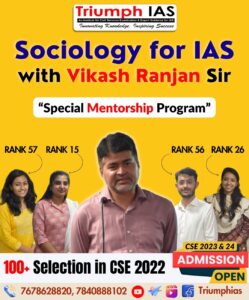
Mr. Vikash Ranjan, arguably the Best Sociology Optional Teacher , has emerged as a versatile genius in teaching and writing books on Sociology & General Studies. His approach to the Sociology Optional Syllabus / Sociology Syllabus is remarkable, and his Sociological Themes and Perspectives are excellent. His teaching aptitude is Simple, Easy and Exam Focused. He is often chosen as the Best Sociology Teacher for Sociology Optional UPSC aspirants.
About Triumph IAS
Innovating Knowledge, Inspiring Success We, at Triumph IAS , pride ourselves on being the best sociology optional coaching platform. We believe that each Individual Aspirant is unique and requires Individual Guidance and Care, hence the need for the Best Sociology Teacher . We prepare students keeping in mind his or her strength and weakness, paying particular attention to the Sociology Optional Syllabus / Sociology Syllabus , which forms a significant part of our Sociology Foundation Course .
Course Features
Every day, the Best Sociology Optional Teacher spends 2 hours with the students, covering each aspect of the Sociology Optional Syllabus / Sociology Syllabus and the Sociology Course . Students are given assignments related to the Topic based on Previous Year Question to ensure they’re ready for the Sociology Optional UPSC examination.
Regular one-on-one interaction & individual counseling for stress management and refinement of strategy for Exam by Vikash Ranjan Sir , the Best Sociology Teacher , is part of the package. We specialize in sociology optional coaching and are hence fully equipped to guide you to your dream space in the civil service final list.
Specialist Guidance of Vikash Ranjan Sir

The Best Sociology Teacher helps students to get a complete conceptual understanding of each and every topic of the Sociology Optional Syllabus / Sociology Syllabus , enabling them to attempt any of the questions, be direct or applied, ensuring 300+ Marks in Sociology Optional .
Classrooms Interaction & Participatory Discussion
The Best Sociology Teacher, Vikash Sir , ensures that there’s explanation & DISCUSSION on every topic of the Sociology Optional Syllabus / Sociology Syllabus in the class. The emphasis is not just on teaching but also on understanding, which is why we are known as the Best Sociology Optional Coaching institution.
Preparatory-Study Support

Online Support System (Oss)
Get access to an online forum for value addition study material, journals, and articles relevant to Sociology on www.triumphias.com . Ask preparation related queries directly to the Best Sociology Teacher , Vikash Sir, via mail or WhatsApp.
Strategic Classroom Preparation

Comprehensive Study Material
We provide printed booklets of concise, well-researched, exam-ready study material for every unit of the Sociology Optional Syllabus / Sociology Syllabus , making us the Best Sociology Optional Coaching platform.
Why Vikash Ranjan’s Classes for Sociology?
Proper guidance and assistance are required to learn the skill of interlinking current happenings with the conventional topics. VIKASH RANJAN SIR at TRIUMPH IAS guides students according to the Recent Trends of UPSC, making him the Best Sociology Teacher for Sociology Optional UPSC.
At Triumph IAS, the Best Sociology Optional Coaching platform, we not only provide the best study material and applied classes for Sociology for IAS but also conduct regular assignments and class tests to assess candidates’ writing skills and understanding of the subject.
Choose T he Best Sociology Optional Teacher for IAS Preparation?
At the beginning of the journey for Civil Services Examination preparation, many students face a pivotal decision – selecting their optional subject. Questions such as “ which optional subject is the best? ” and “ which optional subject is the most scoring? ” frequently come to mind. Choosing the right optional subject, like choosing the best sociology optional teacher , is a subjective yet vital step that requires a thoughtful decision based on facts. A misstep in this crucial decision can indeed prove disastrous.
Ever since the exam pattern was revamped in 2013, the UPSC has eliminated the need for a second optional subject. Now, candidates have to choose only one optional subject for the UPSC Mains , which has two papers of 250 marks each. One of the compelling choices for many has been the sociology optional. However, it’s strongly advised to decide on your optional subject for mains well ahead of time to get sufficient time to complete the syllabus. After all, most students score similarly in General Studies Papers; it’s the score in the optional subject & essay that contributes significantly to the final selection.
“ A sound strategy does not rely solely on the popular Opinion of toppers or famous YouTubers cum teachers. ”
It requires understanding one’s ability, interest, and the relevance of the subject, not just for the exam but also for life in general. Hence, when selecting the best sociology teacher, one must consider the usefulness of sociology optional coaching in General Studies, Essay, and Personality Test.
The choice of the optional subject should be based on objective criteria, such as the nature, scope, and size of the syllabus, uniformity and stability in the question pattern, relevance of the syllabic content in daily life in society, and the availability of study material and guidance. For example, choosing the best sociology optional coaching can ensure access to top-quality study materials and experienced teachers. Always remember, the approach of the UPSC optional subject differs from your academic studies of subjects. Therefore, before settling for sociology optional , you need to analyze the syllabus, previous years’ pattern, subject requirements (be it ideal, visionary, numerical, conceptual theoretical), and your comfort level with the subject.
This decision marks a critical point in your UPSC – CSE journey , potentially determining your success in a career in IAS/Civil Services. Therefore, it’s crucial to choose wisely, whether it’s the optional subject or the best sociology optional teacher . Always base your decision on accurate facts, and never let your emotional biases guide your choices. After all, the search for the best sociology optional coaching is about finding the perfect fit for your unique academic needs and aspirations.
To master these intricacies and fare well in the Sociology Optional Syllabus , aspiring sociologists might benefit from guidance by the Best Sociology Optional Teacher and participation in the Best Sociology Optional Coaching . These avenues provide comprehensive assistance, ensuring a solid understanding of sociology’s diverse methodologies and techniques. Sociology, Social theory, Best Sociology Optional Teacher, Best Sociology Optional Coaching, Sociology Optional Syllabus. Best Sociology Optional Teacher, Sociology Syllabus, Sociology Optional, Sociology Optional Coaching, Best Sociology Optional Coaching, Best Sociology Teacher, Sociology Course, Sociology Teacher, Sociology Foundation, Sociology Foundation Course, Sociology Optional UPSC, Sociology for IAS,
Follow us :
🔎 https://www.instagram.com/triumphias
🔎 www.triumphias.com
🔎https://www.youtube.com/c/TriumphIAS
https://t.me/VikashRanjanSociology
Find More Blogs
Leave a reply cancel reply.
Your email address will not be published. Required fields are marked *
- Art & Culture
- Offbeat Travel
- Volunteering
- Nostalgiphilia
- Culture Directory
- Collaborate
Indian Cultural diversity: The True Essence and Beauty of India
- Indian Culture
- Indian Heritage
Table of contents
India the land of diversity, diversity in architecture , diversity in indian clothing, diversity in indian food, diversity in religion, diversity in indian customs and tradition, diversity of indian languages, diversity in indian art forms, diversity in indian festivals, diversity in indian music, diversity in indian cinema, diversity in indian litrature, diversity in indian celebration.
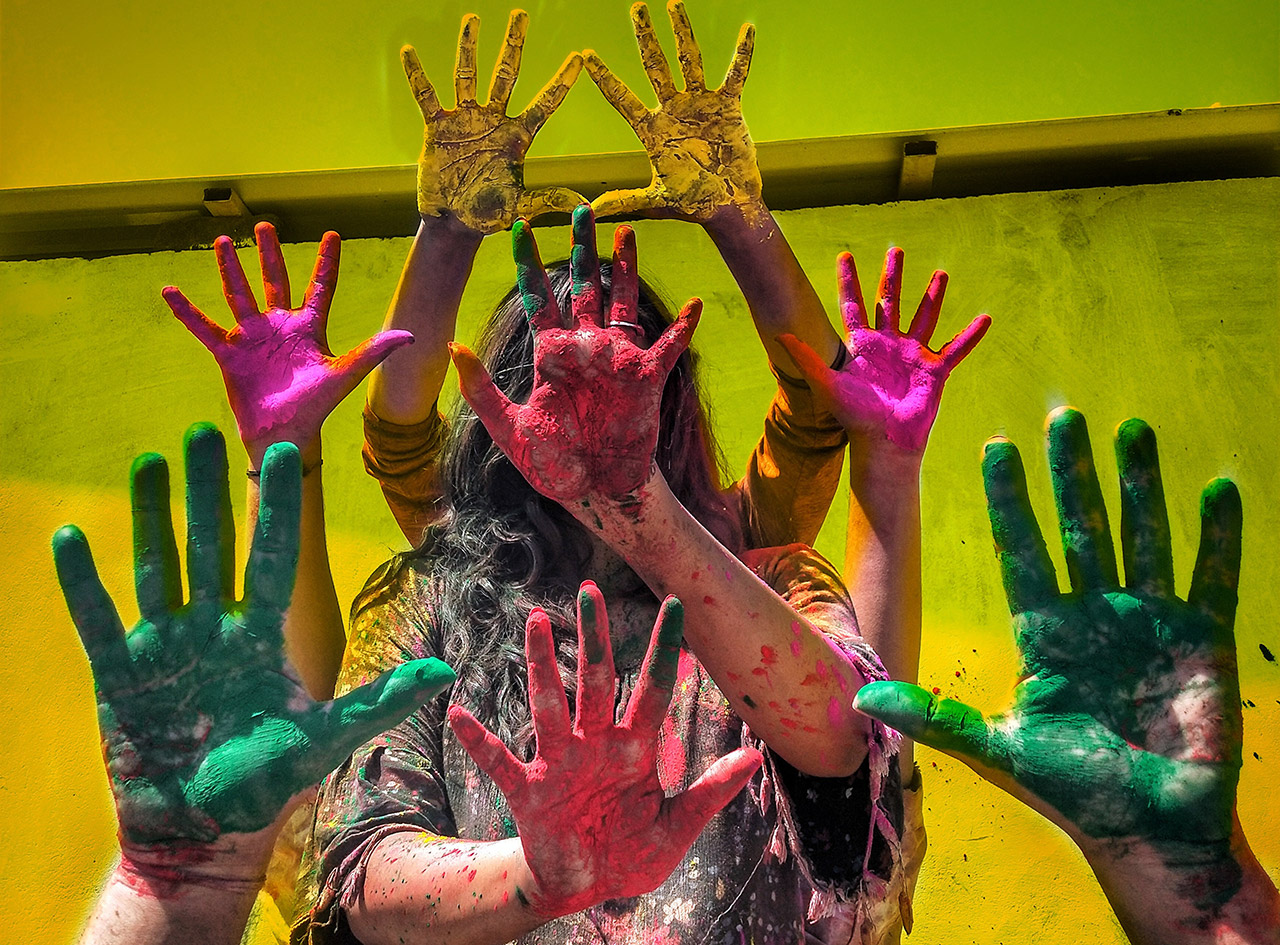
Indian culture is one of the most ancient cultures present in the world. The country is quite diverse and is home to several communities, each of whom has their own culture and traditions. It is this combination of various splendid cultures that make India one of a kind. The Indian cultural diversity is what makes India unique and beautiful.

Situated in the continent of Asia and enclosed by the Arabian sea, the Indian Ocean, and the Bay of Bengal, the nation, is divided into twenty-nine states and seven union territories. Pakistan, China, Bangladesh, Myanmar, Bhutan , and Nepal form the neighbouring countries of India.
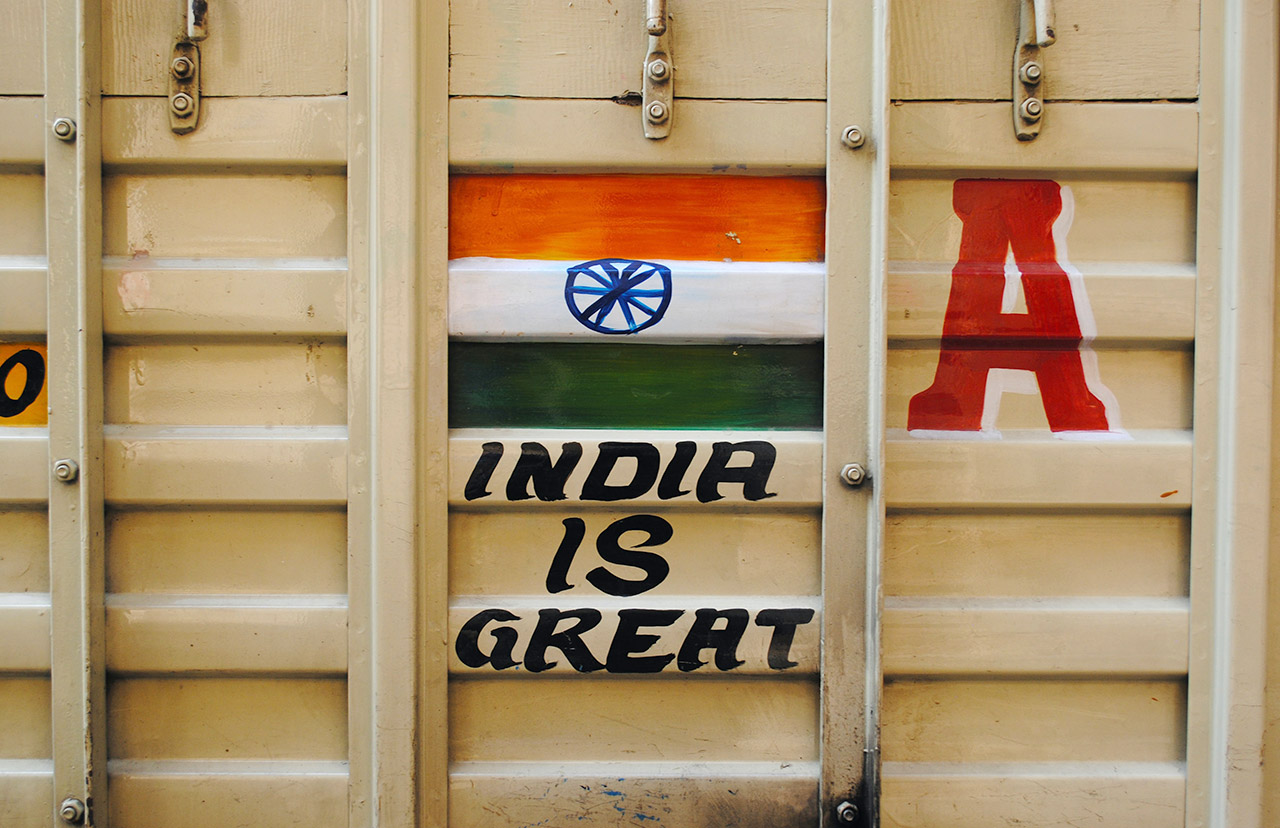
India is a land of diversity each state in the country is home to several communities who live in harmony with each other while preserving and upholding their own distinct culture and traditions. From Delhi , the capital of India, to Tamil Nadu , the southernmost state of India, the land, is blessed with amazing scenic beauty. The country is also home to several historical monuments which add to the varied heritage of India.
Recommended Read – Understanding the Culture of Indian States [Infographic]
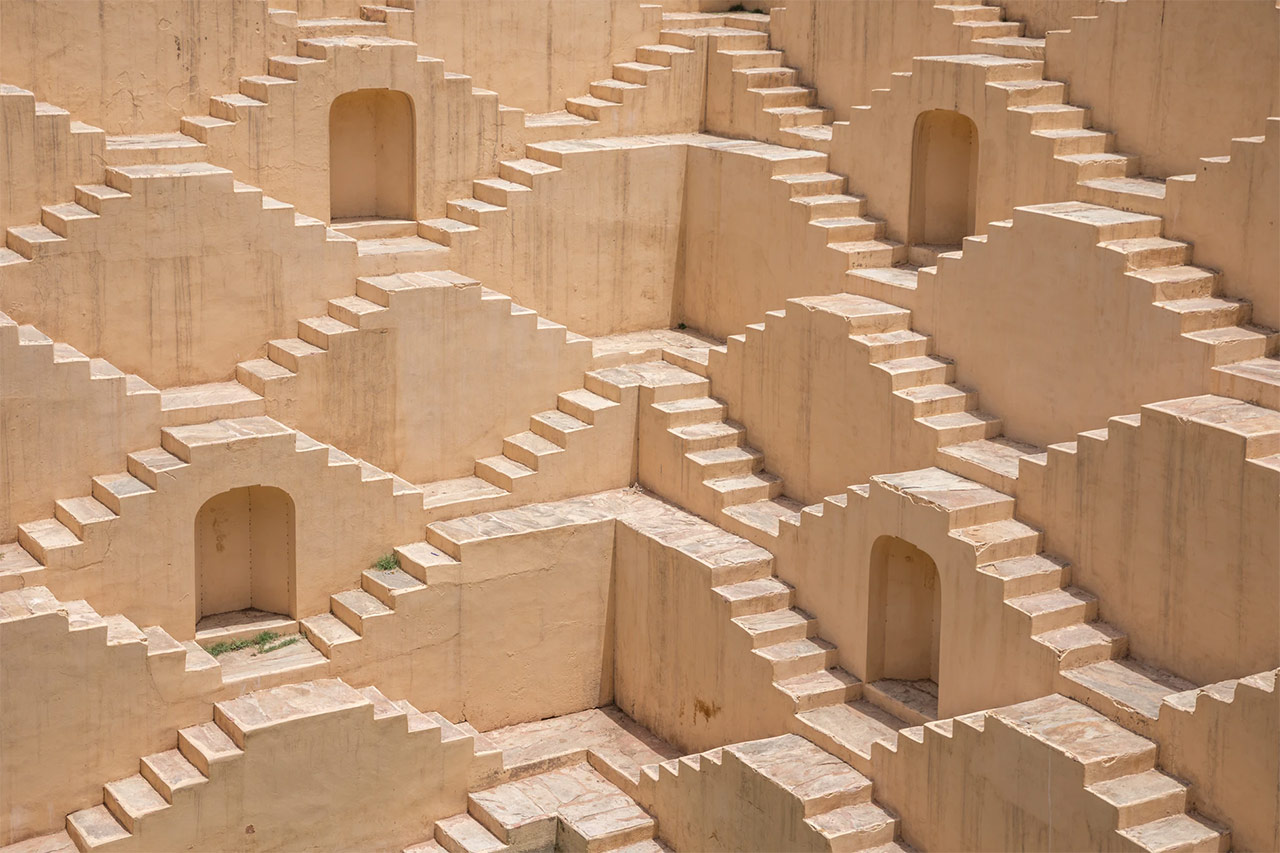
India is a country that is incredibly diversified and that of Indian architecture . India’s architecture spans from ancient caves to contemporary skyscrapers. As India grows, India’s architecture continues to diversify through continuously reverting to its roots while maintaining current trends.
India is also classified by the Dravidian and the Nagara architectural styles as the focal focus of Hindu architecture. In the empires, in the South of India, the Dravidian style prospered, whilst in the North of India, the Nagara style predominately appeared. India’s history, culture and religion are ingrained in its architecture.
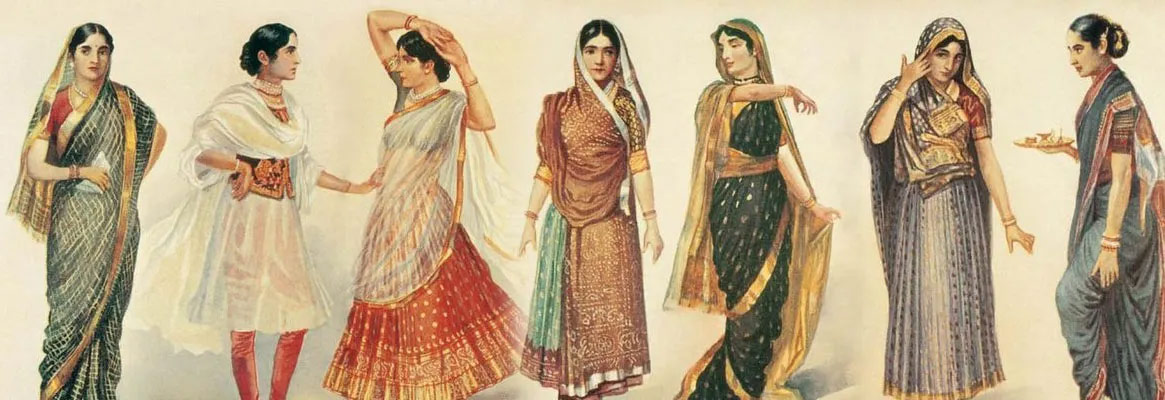
India’s vast and boundless array of traditional dress is full of aesthetic beauty. Made from many states of the country are fabrics, weaving processes, embellishments, styles and accessories of multiple sorts. A compelling epic about craftsmanship, culture or legacy tells a story in each piece. The land is a centre of heritage mode. Its diversity was a muse for a number of notable connoisseurs of fashion. In addition to the western clothing, Indians have their own ethnic attire like dhoti, kurta, sari, sherwani, turban etc. Dhoti is a piece of cloth draped around the waist by men. Dhoti is sometimes called Laacha or Dhuti. Kurta is one of India’s famous men’s ethnic clothing. It is usually worn on holidays today by folks. Likewise, the saree is the favourite choice for Indian women. A saree is a long robe, gracefully drawn by women around their bodies. Saree is Indian women’s most trendy clothing worldwide. Indian women are mostly seen in lovely sarees during religious and cultural events. However, due to their convenience, the sarees are substituted by salwar suits for the preferred daily wear.

Indian food is one of the world’s most tasteful and nuanced. There is no flavour homogeneity between North and South or East and West but rather an incredible richness of tastes. One of India’s assets is its culinary diversity.
Indian food contains so much that one ought to discuss more than just “Indian cuisines.” Each region offers a number of traditional meals and its own culinary features.
Each area is specialised in cuisine, not solely at regional, but also at the provincial level. The diversity in cuisine stem from diverse local cultures, geography (whether the region is near the sea, desert or mountains), and the economy. Indigenous kitchen likewise relies heavily on fresh local products and is seasonal.
Indian cuisine tends generally to seek a balance between spices and herbs that offers delicious dishes with surprising therapeutic and medicinal benefits.
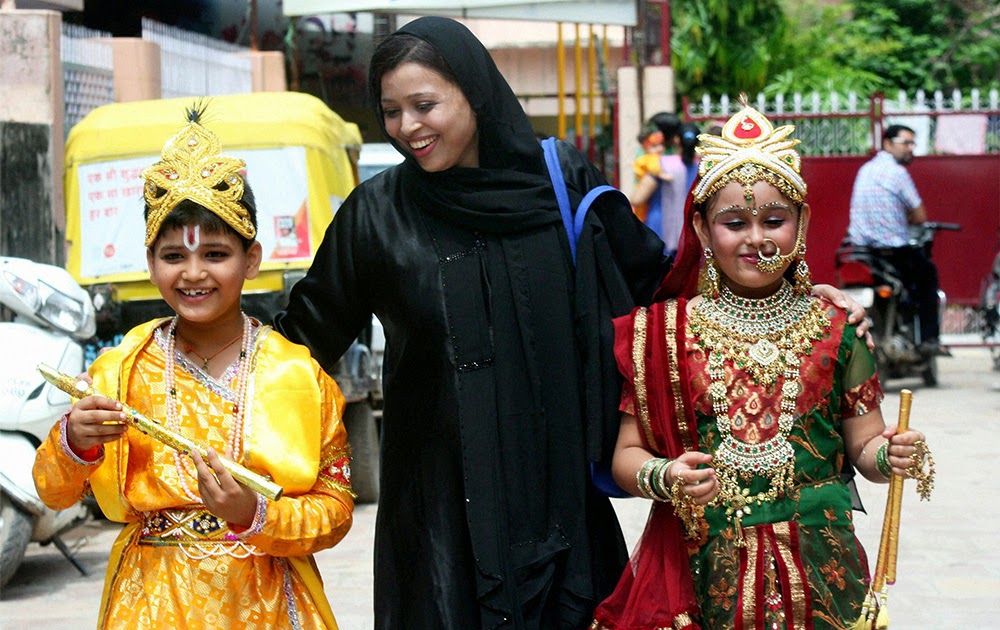
Indian religions have influenced and shaped the Indian culture
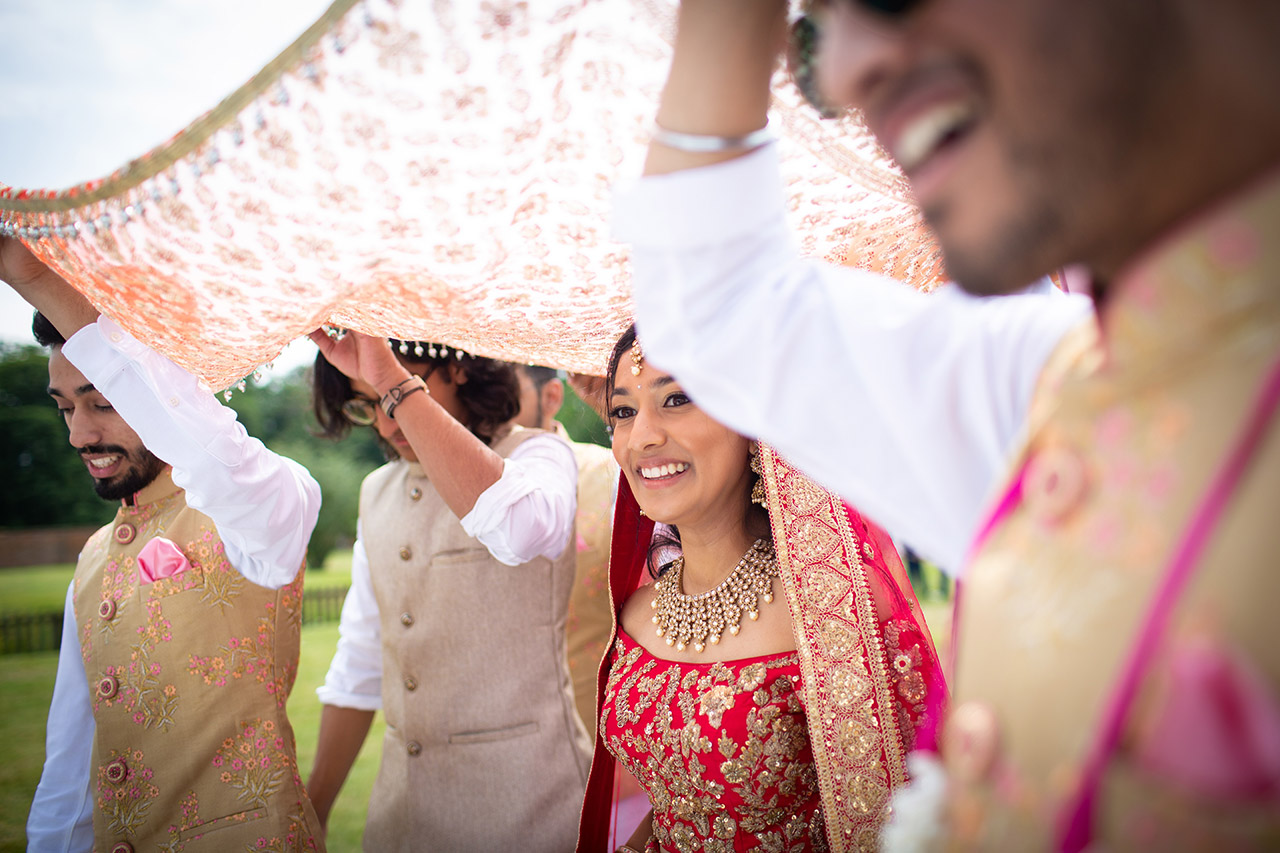
The vast differences in the customs, traditional beliefs and rituals can be witnessed if one analyses the differences in the culture prevalent in the northern and southern part of India. The festivals, the art forms, and to an extent, even the dressing style of the people are quite different in Northern India when compared to those in Southern India . While most of the Indian women wear the saree, the style of draping the saree varies in different parts of India. This difference can be seen, not only among different states but also among the various communities within the same state.
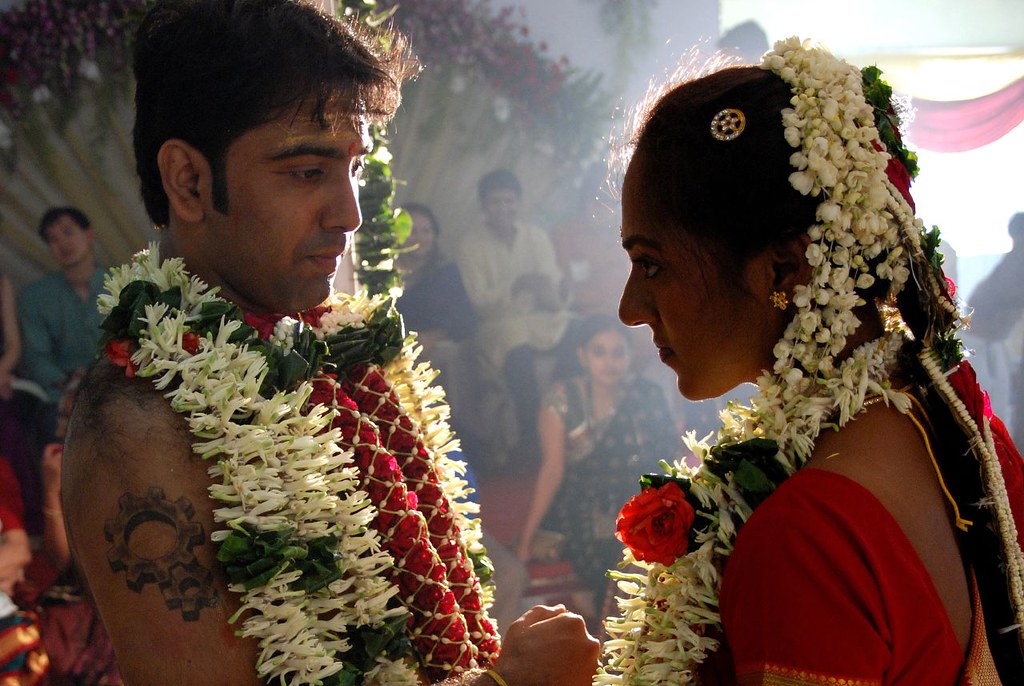
Though Hindi is the most commonly used language in India, there exist many other languages too. As diverse the country is, each state has its distinct language, such as Kannada, (which, is spoken in Karnataka), Malayalam, (which, is spoken in Kerala), Tamil , is spoken in Tamil Nadu, etc. Apart from the fact that each state has its own language, it is also worth mentioning that some states in India have more than one and sometimes more than three prevalent languages. Due to this, it would not come as a surprise that most Indians are bilingual (or sometimes Multilingual), and can effortlessly handle more than one or two languages.
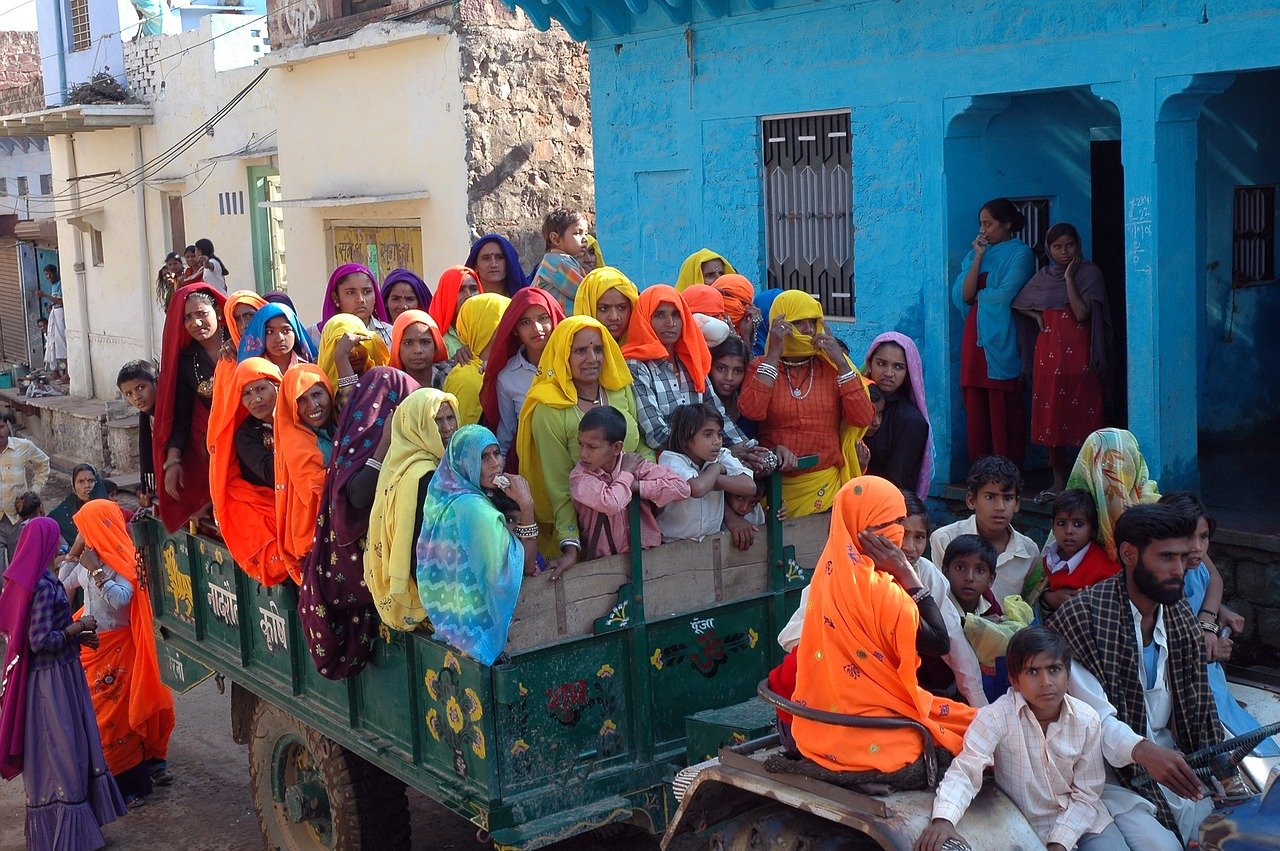
The family has always been an integral part of Indian society. In an Indian family, all the members share a close-knit connection. Joint families are also common in the country. In joint families, all the members of the family live under the same roof. However, in present times, nuclear families are becoming more common. In India, arranged marriages are relatively more common. The concept of an arranged marriage might seem a bit confusing to people from the western part of the world. However, in India, arranged marriages are more encouraged and are still very much prevalent in the country.
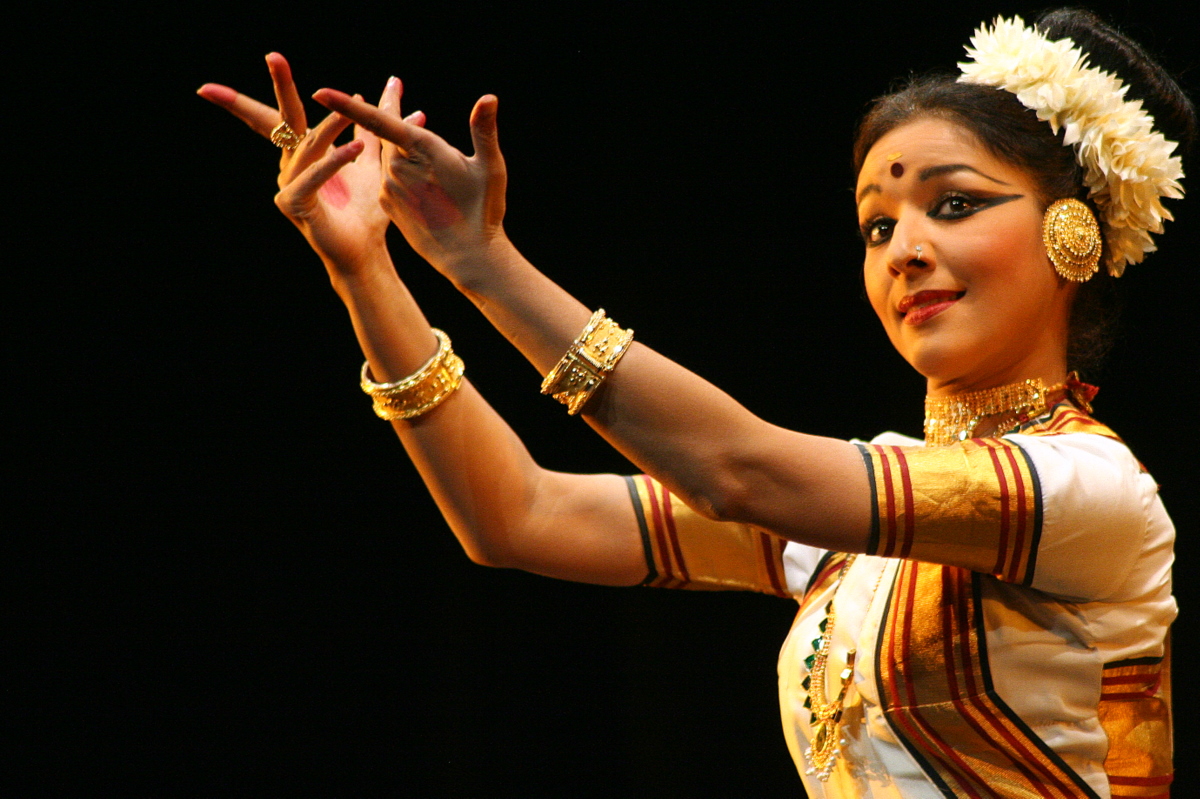
The unique and splendid art forms of India have a significant position in the culture of India. Each state is blessed with its unique art form and differs considerably from that of its neighbour. Though, it is worthwhile to note that many art forms of India are in some ways the amalgamation of other art forms borrowed from the neighbouring states. From the elegant Mohiniyattam , which focuses on the elegant and graceful movements of the dancer to the Ghoomar , a folk dance in Rajasthan, the art forms vary from each other but are equally beautiful and magical.
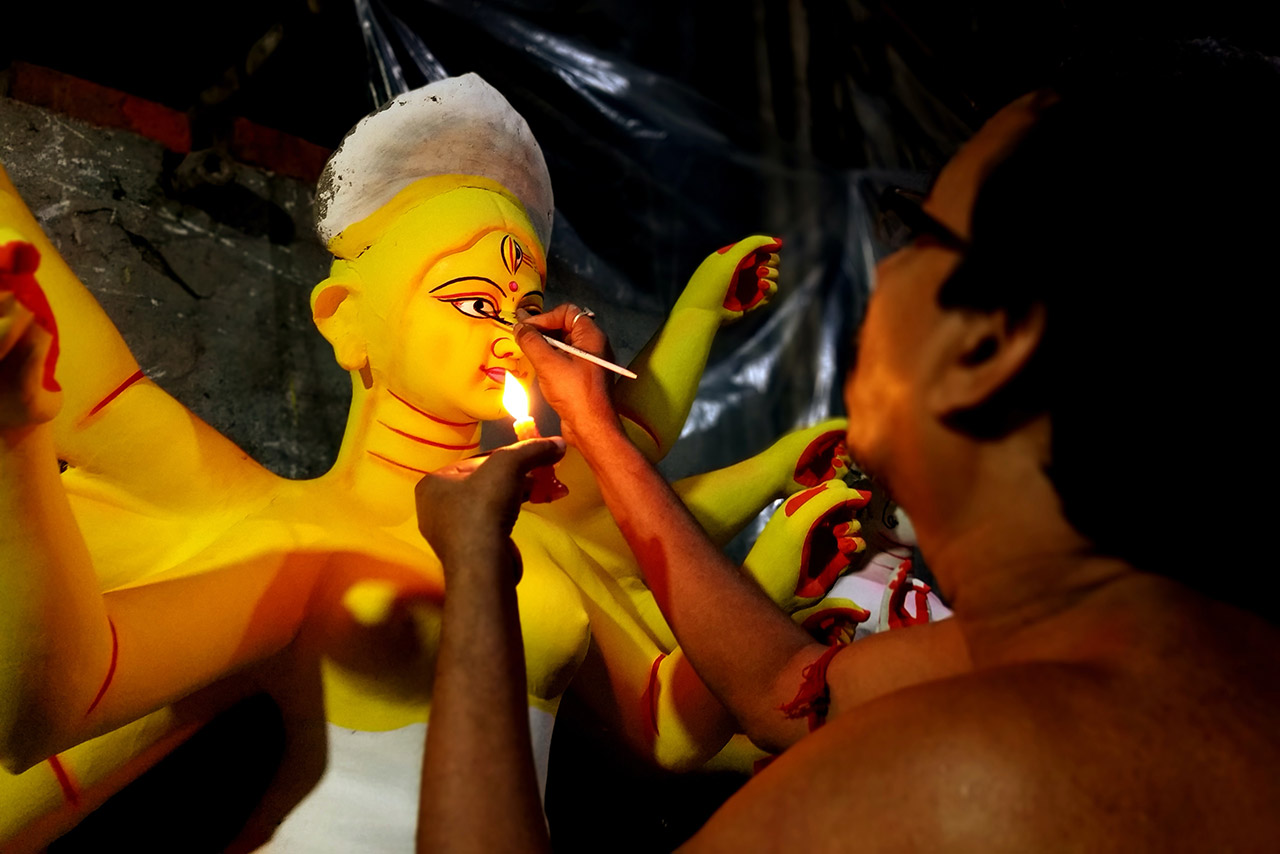
The festivals of India , too, are worth mentioning. As said earlier, each state has its own festivals, from the fragrant Onam, the festival of Kerala , which is characterized by the making of a floral carpet to the Pôhela Boishakh, (the onset New Year according to the Bengali calendar), the festivals are both colourful and equally incredible.
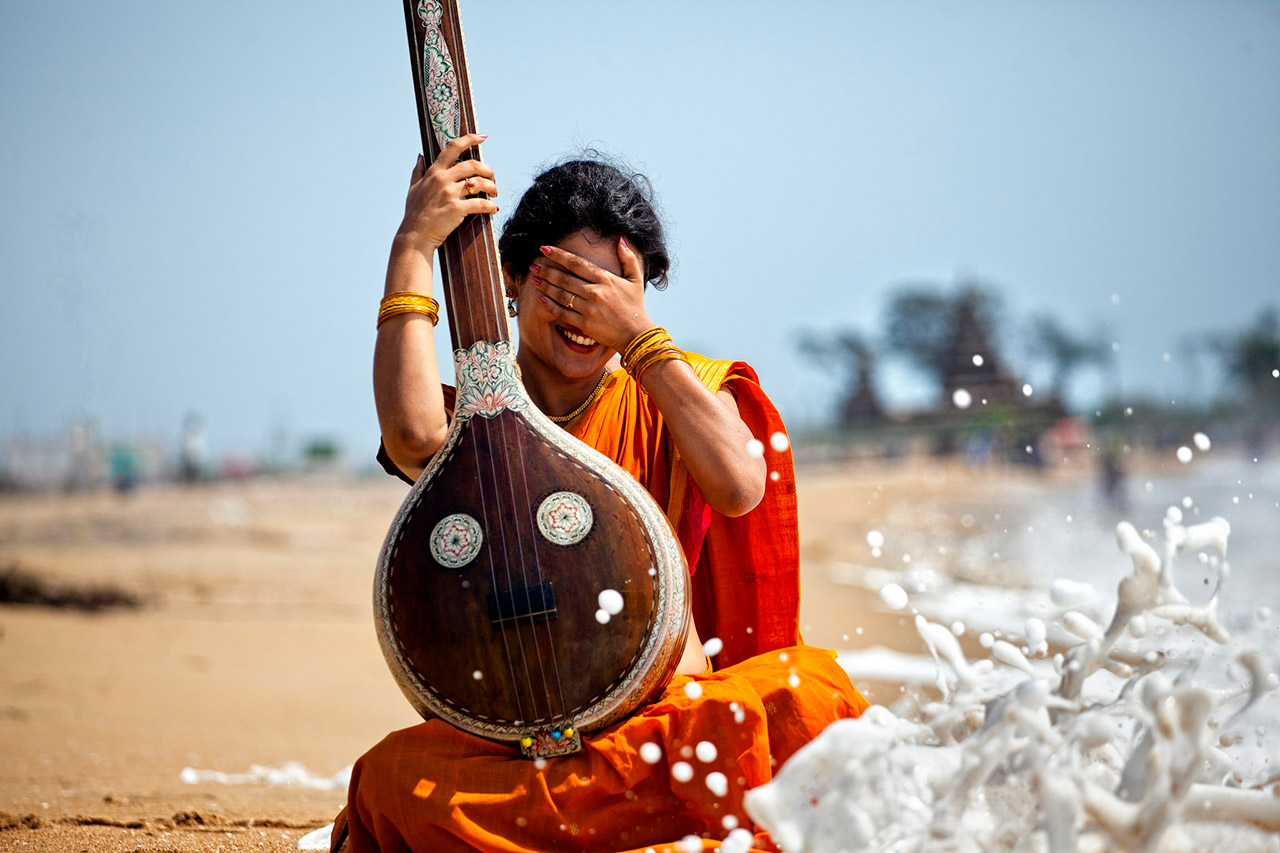
Music plays a significant role in the culture of any country, and India, too, is not an exception. Carnatic music , Hindustani music are the most popular in India. These are usually accompanied by the tune of the traditional musical instruments such as the tabla and the veena. Indian music is quite soothing and pleasing to the ear.
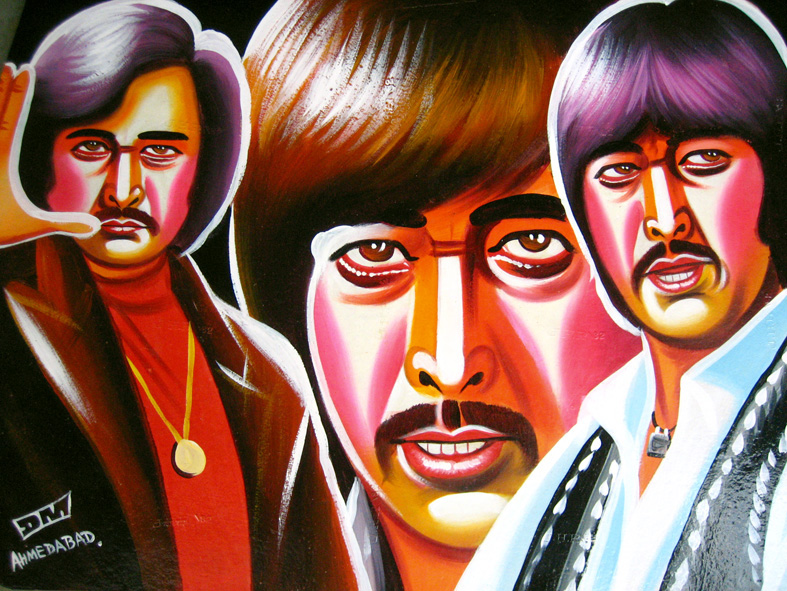
The movies produced in India, too, reflect the culture of the society. Each state in India has its own movie industry, though Bollywood is the most popular among them. The movie industries in India are known by different terms such as Mollywood (Malayalam movie industry), Tollywood, etc. Owing to the number of movies produced each year in different languages across India, adding to the fact that Indians love movies, India has now become one of the greatest producers of films.
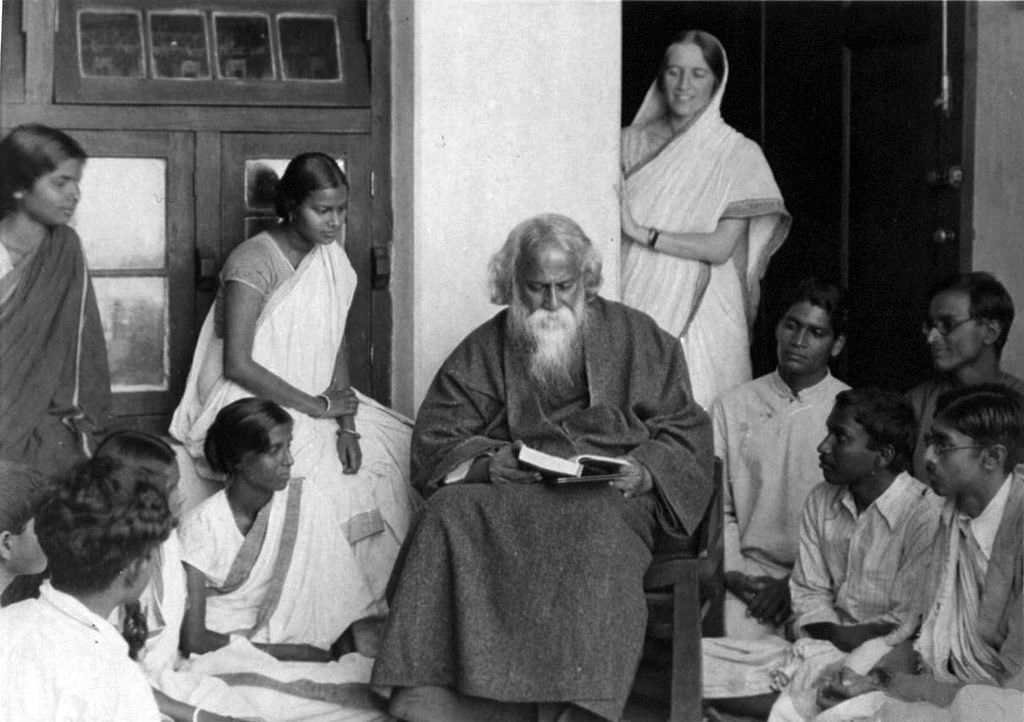
India has also been blessed with many intellectuals and legendary writers and poets who are renowned worldwide for their contributions to humanity. Prominent among them is Rabindranath Tagore , the first Asian and Indian to win the Nobel Prize . His work Gitanjali continues to spread its message and inspires all those who read it. Other prominent writers of India include Sarojini Naidu, Aurobindo Ghosh, among others. Artists such as Raja Ravi Varma, Rabindranath Tagore, and M F Hussain have helped in changing the face of Indian art.
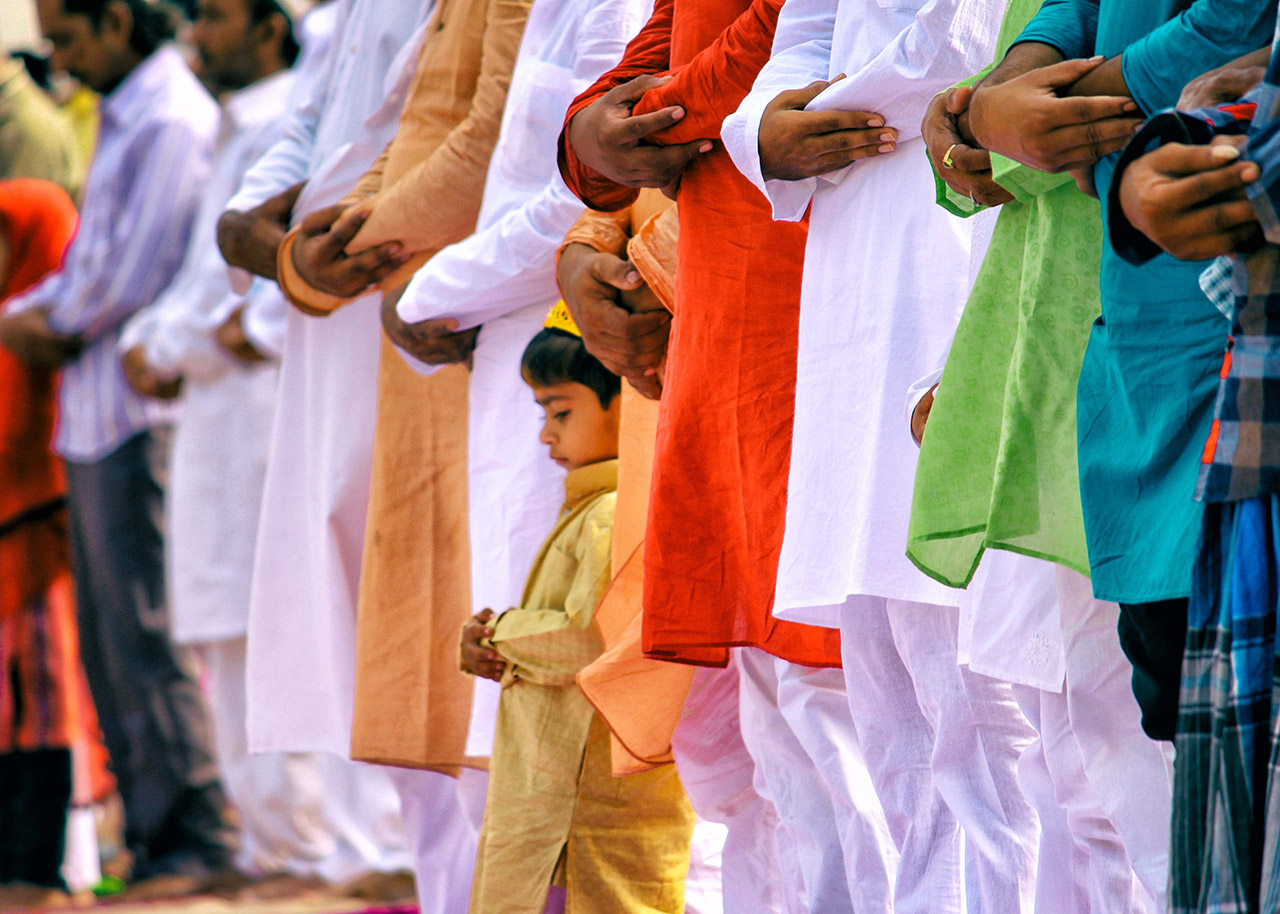
Festivals and celebrations are a common occurrence in India as they occur almost every other day; however, the grandeur and pomp of these festivals are quite impressive. The country is also home to many heritage sites and monuments , including the Taj Mahal. It is all these facts combined that makes the Indian culture unique and distinct from others.

The seventh-largest country in the world, India has set itself a unique and distinct place among the other countries of the world. The host of a culture that has been prevalent for a long time, India is perhaps one of the most diverse countries in the world. From the attire worn by the people belonging to different communities to the languages spoken and even in the food habits, the country both reflects its diversity and varied heritage.
Cover Photo by Tom Chen on Unsplash
Image credits: The copyright for the images used in this article belong to their respective owners. Best known credits are given under the image. For changing the image credit or to get the image removed from Caleidoscope, please contact us.
very good knowledge
Very good guys
It’s very helpful for my science homework theme page: celebrating cultural diversity
Thanks Aarradhya, all the best for your class project!
LEAVE A REPLY Cancel reply
Save my name, email, and website in this browser for the next time I comment.
INSPIRING READS
Temples of orissa – illustrious architectural wonders of india, sita kund: the heartbeat of bihar’s cultural legacy, traditional indian summer dishes to beat the heat and be healthy, the celebration of indian new year in various cultures of india, usher in a new ugadi festival by saving water , old love vs modern love, trending topics.
- Terms of Use
- Privacy Policy
Affiliate disclosure: As an Amazon Associate, we may earn commissions from qualifying purchases from Amazon. Learn more
© caleidoscope - 2024.

Call us @ 08069405205

Search Here

- An Introduction to the CSE Exam
- Personality Test
- Annual Calendar by UPSC-2024
- Common Myths about the Exam
- About Insights IAS
- Our Mission, Vision & Values
- Director's Desk
- Meet Our Team
- Our Branches
- Careers at Insights IAS
- Daily Current Affairs+PIB Summary
- Insights into Editorials
- Insta Revision Modules for Prelims
- Current Affairs Quiz
- Static Quiz
- Current Affairs RTM
- Insta-DART(CSAT)
- Insta 75 Days Revision Tests for Prelims 2024
- Secure (Mains Answer writing)
- Secure Synopsis
- Ethics Case Studies
- Insta Ethics
- Weekly Essay Challenge
- Insta Revision Modules-Mains
- Insta 75 Days Revision Tests for Mains
- Secure (Archive)
- Anthropology
- Law Optional
- Kannada Literature
- Public Administration
- English Literature
- Medical Science
- Mathematics
- Commerce & Accountancy
- Monthly Magazine: CURRENT AFFAIRS 30
- Content for Mains Enrichment (CME)
- InstaMaps: Important Places in News
- Weekly CA Magazine
- The PRIME Magazine
- Insta Revision Modules-Prelims
- Insta-DART(CSAT) Quiz
- Insta 75 days Revision Tests for Prelims 2022
- Insights SECURE(Mains Answer Writing)
- Interview Transcripts
- Previous Years' Question Papers-Prelims
- Answer Keys for Prelims PYQs
- Solve Prelims PYQs
- Previous Years' Question Papers-Mains
- UPSC CSE Syllabus
- Toppers from Insights IAS
- Testimonials
- Felicitation
- UPSC Results
- Indian Heritage & Culture
- Ancient Indian History
- Medieval Indian History
- Modern Indian History
- World History
- World Geography
- Indian Geography
- Indian Society
- Social Justice
- International Relations
- Agriculture
- Environment & Ecology
- Disaster Management
- Science & Technology
- Security Issues
- Ethics, Integrity and Aptitude

- Indian Heritage & Culture
- Enivornment & Ecology
- How to Study Art & Culture?
- What is Art and Culture? What is the difference between the two?
- Indus Civilization
- Evolution of rock-cut architecture in India
- Important rock-cut caves
- The contribution of Pallavas to Rock-cut architecture
- Comparision of art form found at Ellora and Mahabalipuram
- Buddhist Architecture
- Early Temples in India
- Basic form of Hindu temple
- Dravida style of temple architecture
- Nagara Style or North India Temple style
- Vesara style of temple architecture
- Characteristic features of Indo-Islamic form of architecture
- Styles of Islamic architecture in the Indian subcontinent
- Types of buildings in Islamic architecture in the Indian subcontinent
- Evolution of this form of architecture during the medieval period
- Modern Architecture
- Post-Independence architecture
- Indus Civilization Sculpture
- Bharhut Sculptures
- Sanchi Sculptures
- Gandhara School of Sculpture
- Mathura School of Sculpture
- Amaravati School of Sculpture
- Gupta Sculpture
- Medieval School of Sculpture
- Modern Indian Sculpture
- Pre Historic Painting
- Mural Paintings & Cave Paintings
- Pala School
- Mughal Paintings
- Bundi School of Painting
- Malwa School
- Mewar School
- Basohli School
- Kangra School
- Decanni School of Painting
- Madhubani Paintings or Mithila paintings
- Pattachitra
- Kalighat Painting
- Modern Indian Paintings
- Personalities Associated to Paintings
- Christianity
- Zoroastrianism
- Six Schools of Philosophy
- Lokayata / Charvaka
- Hindustani Music
- Carnatic Music
- Folk Music Tradition
- Modern Music
- Personalities associated with Music
- Bharatanatyam
- Mohiniattam
- Folk Dances
- Modern Dance in India
- Sanskrit Theatre
- Folk Theatre
- Modern Theatre
- Personalities associated with Theatre
- History of Puppetry
- String Puppetry
- Shadow Puppetry
- Rod Puppetry
- Glove Puppetry
- Indian Cinema and Circus
- Shankaracharya
- Ramanujacharya (1017-1137AD)
- Madhvacharya
- Vallabhacharya
- Kabir (1440-1510 AD)
- Guru Nanak (1469-1538 AD)
- Chaitanya Mahaprabhu
- Shankar Dev
- Purandaradasa
- Samard Ramdas
- Classical Languages
- Scheduled Languages
- Literature in Ancient India
- Buddhist and Jain Literature
- Tamil (Sangam) Literature
- Malayalam Literature
- Telugu Literature
- Medieval Literature
- Modern Literature
- Important characteristics of Fairs and Festivals of India
- Some of the major festivals that are celebrated in India
- Art & Crafts
- Ancient Science & Technology
- Medieval Science & Technology
- Famous Personalities in Science & Technology
- Tangible Cultural Heritage
- Intangible Cultural Heritage
- Cultural Heritage Sites
- Natural Heritage Sites
- Important Institutions
- Important programmes related to promotion and preservation of Indian heritage
- Ochre Colored Pottery (OCP)
- Black and Red Ware (BRW)
- Painted Grey-Ware (PGW)
- Northern Black Polished Ware (NBPW)
- Origin of Martial arts in India
- Various forms of Martial arts in India
- Introduction
- Characteristics of Indian Society
- Caste System
- Religious Pluralism
- Kinship, Marriage and Family
Diversity in India
- Women in Ancient India
- Women in Medieval India
- Women in Bhakti Movement
- Women in Modern India
- Women’s Liberation Movement
- Legislative Acts
- Constitutional Provisions for Women in our Constitution
- Indicators of Women’s Status in India
- Demographic Profile of Women in India
- Factors affecting Women’s Work Participation
- Women’s Organizations
- Government Response
- Women Empowerment Programs / Schemes by GoI
- Population size and distribution
- Process of population change/growth
- Sex rate, literacy rate and other important indicators
- National population policy
- Challenges posed by population growth
- Migration and population growth- Challenges associated with it
- Measures taken or to be taken to address issues posed by population growth
- Meaning of ‘Poverty’
- Classification of Poverty
- Various dimensions associated with poverty in India
- Poverty in India at the eve of Independence
- Various Methodologies proposed by various committees for calculation of Poverty
- Current Poverty level in India
- Some developments in recent years relating to Poverty Estimates are as follows:
- Meaning of Urbanization
- Classification of Urban cities in India
- Social change brought about by Urbanization in Indian society
- A critical appraisal of this social change on Indian society
- Government measures to address issues associated with urbanization in India
- A critical appraisal of these measures
- Other measures to address issues arising out of urbanization
- Meaning of ‘Globalization’
- Factors which aided the process of globalization in India
- Social change brought about globalization on Indian society
- Meaning of ‘Empowerment’
- Importance of social empowerment in the Indian context
- Measures taken to usher social empowerment in India after the independence
- Alternative approaches to social empowerment in India
- Meaning of Communalism
- Evolution of Communalism in India
- Factors responsible for the rise of communalism in the present Indian society
- Challenges posed by Communalism to present Indian society
- Measures taken to address this challenge
- Meaning of Regionalism
- Regionalism within nation
- Regionalism in India
- Potential cause for regionalism in India
- Why regional disparity still persists?
- Linguistic Reorganization of States
- Demand for Dravida Nadu
- Telangana Movement
- Shiv Sena against Kannadigas
- Bodoland Demand within Assam
- Khalistan Movement
- Attacks on Bihar Labourers by the ULFA
- The MNS Targeting North Indians
- Inter-State Disputes
- Creation of new States in 2000
- Regionalism and its impact on Indian Society
- Possible ways to tackle the negative effects of regionalism
- Nationalism and Regionalism
- Federalism and Regionalism
- Meaning of Secularism
- Importance of secularism in the Indian context
- Indian constitution and secularism
- Comparison of Western and Indian form of secularism
- Threats to secularism in the present times
- Possible ways to tackle the negative effects of secularism
Home » Society » Salient features of Indian Society » Features of Indian Society » Diversity in India
India is a plural society both in letter and spirit. It is rightly characterized by its unity and diversity. A grand synthesis of cultures, religions and languages of the people belonging to different castes and communities has upheld its unity and cohesiveness despite multiple foreign invasions.
National unity and integrity have been maintained even through sharp economic and social inequalities have obstructed the emergence of egalitarian social relations. It is this synthesis which has made India a unique mosque of cultures. Thus, India present seemingly multicultural situation within in the framework of a single integrated cultural whole.
The term ‘diversity’ emphasizes differences rather than inequalities. It means collective differences, that is, differences which mark off one group of people from another. These differences may be of any sort: biological, religious, linguistic etc. Thus, diversity means variety of races, of religions, of languages, of castes and of cultures.
Unity means integration. It is a social psychological condition. It connotes a sense of one- ness, a sense of we-ness. It stands for the bonds, which hold the members of a society together.
Unity in diversity essentially means “unity without uniformity” and “diversity without fragmentation”. It is based on the notion that diversity enriches human interaction.
When we say that India is a nation of great cultural diversity, we mean that there are many different types of social groups and communities living here. These are communities defined by cultural markers such as language, religion, sect, race or caste.
Various forms of diversity in India:
- Religious diversity: India is a land of multiple religions. Apart from the tribal societies, many of whom still live in the pre-religious state of animism and magic, the Indian
population consists of the Hindus (82.41%), Muslims (11.6%), Christians (2.32%), Sikhs (1.99%), Buddhists (0.77%) and Jains (0.41%). The Hindus themselves are divided into several sects such as Vaishnavas, Shaivates, Shaktas, Smartas etc. Similarly, the Muslims are divided into sects such as Shias, Sunnis, Ahmadiyas etc.
- Linguistic diversity: Languages spoken in India belong to several language families, the major ones being the Indo-Aryan languages spoken by 75% of Indians and the Dravidian languages spoken by 20% of Indians. Other languages belong to the Austroasiatic, Sino- Tibetan, Tai-Kadai, and a few other minor language families and isolates. India has the world’s second highest number of languages, after Papua New
- Racial diversity: 1931 census classified India’s racial diversity in the following groups- The Negrito, The Proto-Australoid, The Mongoloid, The Mediterranean, The Western Brachycephals and the Nordic. Representatives of all the three major races of the world, namely Caucasoid, Mongoloid, and Negroid, are found in the
- Caste diversity: India is a country of The term caste has been used to refer to both varna as well as jati. Varna is the four-fold division of society according to functional differentiation. Thus, the four varnas include Brahmins, Kshatriyas, Vaishyas and Shudras and an outcaste group. Whereas Jati refers to a hereditary endogamous status group practicing a specific traditional occupation.. There are more than 3000 jatis and there is no one all India system of ranking them in order and status. The jati system is not static and there is mobility in the system, through which jatis have changed their position over years. This system of upward mobility has been termed as “Sanskritization” by M. N. Srinivas.
- Cultural diversity: Cultural patterns reflect regional variations. Because of population diversity, there is immense variety in Indian culture as it is a blend of various cultures. Different religion, castes, regions follow their own tradition and culture. Thus, there is variation in art, architecture, dance forms, theatre forms, music
- Geographical diversity: Spanning across an area of 3.28 million square kilometre, India is a vast country with great diversity of physical features like dry deserts, evergreen forests, lofty mountains, perennial and non-perennial river systems, long coasts and fertile plains.
In addition to the above described major forms of diversity, India also has diversity of many other types like that of settlement patterns – tribal, rural, urban; marriage and kinship patterns along religious and regional lines and so on.
Factors Leading to Unity amidst Diversity in India:
- Constitutional identity: The entire country is governed by one single Even, most of the states follow a generalised scheme of 3-tier government structure, thus imparting uniformity in national governance framework. Further, the Constitution guarantees certain fundamental rights to all citizens regardless of their age, gender, class, caste, religion, etc.
- Religious co-existence: Religion tolerance is the unique feature of religions in India due to which multiple religions co-exist in Freedom of religion and religious practice is guaranteed by the Constitution itself. Moreover, there is no state religion and all religions are given equal preference by the state.
- Inter-State mobility: The Constitution guarantees freedom to move throughout the territory of India under Article 19 (1) (d), thus promoting a sense of unity and brotherhood among the
- Other factors such as uniform pattern of law, penal code, and administrative works (eg. All India services) too lead to uniformity in the criminal justice system, policy implementation
- Economic integration: The Constitution of India secures the freedom of Trade, Commerce and Intercourse within the Territory of India under Article Further, the Goods and Service Tax (GST) have paved way for ‘one country, one tax, one national market’, thus facilitating unity among different regions.
- Institution of pilgrimage and religious practices: In India, religion and spirituality have great significance. . From Badrinath and Kedarnath in the north to Rameshwaram in the south, Jagannath Puri in the east to Dwaraka in the west the religious shrines and holy rivers are spread throughout the length and breadth of the Closely related to them is the age-old culture of pilgrimage, which has always moved people to various parts of the country and fostered in them a sense of geo-cultural unity.
- Fairs and festivals: They also act as integrating factors as people from all parts of the country celebrate them as per their own local Eg. Diwali is celebrated throughout by Hindus in the country, similarly Id and Christmas are celebrated by Muslims and Christians, respectively. Celebration of inter-religious festivals is also seen in India.
- Climatic integration via monsoon: The flora and fauna in the entire Indian subcontinent, agricultural practices, life of people, including their festivities revolve around the monsoon season in
- Sports and Cinema: These are followed by millions in the country, thus, acting as a binding force across the length and breadth of
Factors that threaten India’s unity:
- Regionalism: Regionalism tends to highlight interests of a particular region/regions over national interests. It can also adversely impact national integration. Law and order situation is hampered due to regional demands and ensuing
- Divisive politics: Sometimes, ascriptive identities such as caste, religion etc. are evoked by politicians in order to garner This type of divisive politics can result in violence, feeling of mistrust and suspicion among minorities.
- Development imbalance: Uneven pattern of socio-economic development, inadequate economic policies and consequent economic disparities can lead to backwardness of a region. Consequently, this can result in violence, kickstart waves of migration and even accelerate demands of separatism.. For instance, due to economic backwardness of the North East region, several instances of separatist demands and secessionist tendencies have sprung up in the
- Ethnic differentiation and nativism: Ethnic differentiation has often led to clashes between different ethnic groups especially due to factors such as job competition, limited resources, threat to identity E.g. frequent clashes between Bodos and Bengali speaking Muslims in Assam. This has been accentuated by son of the soil doctrine, which ties people to their place of birth and confers some benefits, rights, roles and responsibilities on them, which may not apply to others.
- Geographical isolation: Geographical isolation too can lead to identity issues and separatist The North-East is geographically isolated from the rest of the country as it is connected with the rest of the country by a narrow corridor i.e the Siliguri corridor (Chicken’s neck). The region has inadequate infrastructure, is more backward economically as compared to the rest of the country. As a result, ithas witnessed several instances of separatism and cross-border terrorism, among others.
- Inter-religious conflicts: Inter-religious conflicts not only hamper relations between two communities by spreading fear and mistrust but also hinder the secular fabric of the country.
- Inter-state conflicts: This can lead emergence of feelings related to regionalism. It can also affect trade and communications between conflicting states. For instance, Cauvery River dispute between Karnataka and Tamil
- Influence of external factors: Sometimes external factors such as foreign organizations terrorist groups, extremist groups can incite violence and sow feelings of separatism. g. Inter-Services Intelligence (ISI) has been accused of supporting and training mujahideen to fight in Jammu and Kashmir and sow separatist tendencies among resident groups.
In-spite of the challenges posed by diversity, there can be no doubt on the role played by socio-cultural diversity in sustaining and developing Indian society.
Problem is not of diversity per se, but the handling of diversity in India society. The problems of regionalism, communalism, ethnic conflicts etc. have arisen because the fruits of development haven’t been distributed equally or the cultures of some groups haven’t been accorded due recognition.
Conclusion:
Hence, Constitution and its values must form guiding principles of our society. Any society which has tried to homogenize itself, has witnessed stagnation in due-course and ultimately decline. The most important example is this case is of Pakistan which tried to impose culture on East-Pakistan ultimately leading to creation of Bangladesh.

- Our Mission, Vision & Values
- Director’s Desk
- Commerce & Accountancy
- Previous Years’ Question Papers-Prelims
- Previous Years’ Question Papers-Mains
- Environment & Ecology
- Science & Technology

Cultural Diversity in India Essay, Indian Diversity Essay
Are you also looking for “Cultural Diversity in India Essay? If yes , then you have fallen on the world’s best website essayduniya.com. If you are searching Diversity in India essay 200 words, Article on cultural diversity in India, Cultural diversity essay, Cultural diversity in India UPSC, Short essay on cultural diversity in India, Cultural diversity in India essay pdf , India nation of diversity Essay, Indian diversity Essay, Cultural diversity in India PDF, Project on cultural diversity in India then your wait ends here.
Cultural Diversity in India Essay 200 Words
India, with a population of 1.38 billion people, has a rich cultural diversity. Because of population diversity, Indian culture is quite diverse. It is a mixture of numerous ethnicities from various religions, each with its own culture and traditions. Indian culture is one of the oldest in the world . Even throughout the Bronze Age, India had an urban civilization. The Indus Valley Civilization, also known as the Harappan Civilization, existed between 3300 BC and 1300 BC . India is one of the world’s most religious countries, with huge and active Hindu (80.45%) , Muslim (13.43%), Christian (2 . 34%), Sikh (1 . 86%), and other communities.
Unlike in the West, where religion is considered “private , ” Indians choose to make their religions open. Each state in the country has different communities that coexist while retaining and supporting its own distinct culture and traditions . From Delhi, India’s capital, to Tamil Nadu , the country’s southernmost state, the country is endowed with breathtaking natural beauty. The country also has various historical monuments that contribute to India’s diverse heritage . The Indian culture refers to the way of life of the Indian people. There is almost no other culture in the world that is as diverse and distinct as India’s.

Cultural Diversity in India Essay 300 Words
India is rich in traditions and has a distinct culture in terms of festivals , cuisines, dialects, dress, and so on. Indian heritage and culture have extended not only in India but also throughout Asia and many European countries. The nation is divided into twenty-nine states and seven union territories and is located on the Asian continent, bounded by the Arabian Sea, the Indian Ocean, and the Bay of Bengal. India’s neighbors are Pakistan, China, Bangladesh, Myanmar , Bhutan, and Nepal. Despite numerous foreign invasions, a vast synthesis of cultures, faiths, and languages of people from various castes and communities has maintained its unity and coherence. It is the mixture of numerous magnificent cultures that defines India . The diversity of Indian cultures is what differentiates and beautifies India. The landscapes of India are tremendously diverse, ranging from snow-capped mountain ranges to deserts, plains, hills, and plateaus.
India is a tremendously diverse country , and so is Indian architecture . The architecture of India ranges from prehistoric caves to modern skyscrapers. As India grows, its architecture continues to diversify by returning to its traditions while adhering to modern trends. As India develops , its architecture continues to expand by returning to traditions while sticking to current trends. Throughout the country, India celebrates numerous festivals such as Diwali , Holi, Eid, and Christmas. Which, once again, is observed in many places of the world. India is a multi-cuisine country . The majority of the cuisines are South Indian, North Indian, and seafood.
India is rich in various forms of art, dance, and theatre . Each state in India has its own folk dance culture, which is experienced at most festivals or as a welcome dance to visitors that enter the state or country. Most foreign nationals visit India to experience these traditions and desire to live, eat, and dance in accordance with Indian cultures, traditions, and customs.
Cultural Diversity in India Essay 500 Words
When we look at the history of India, we see that people from all over the world traveled to India and later became united by the Indian culture. As a result, several civilizations became mixed together. This is the true reason behind India’s cultural variety. Despite many foreign invasions, a vast synthesis of cultures, faiths, and languages of people from various castes and communities has maintained its unity and togetherness. This diversity has enriched the social lives of all Indians. Languages, festivals, religions, delicacies, dressing styles, and many more obvious facts help to explain India’s cultural variety. Each state in India is home to many communities that live in harmony with one another while retaining and sustaining their own distinct culture and traditions.
Let us know about Indian culture and its significance in detail.
Language Diversity
India possesses around 121 languages (22 languages and 99 languages not included in the Eighth Schedule) and over 19,500 dialects. Most of these languages are spoken by a small number of people, or they are restricted to specific regions, states , or places.
Clothing Diversity
India’s enormous and endless variety of traditional clothing is full of attractive appearances. Fabrics, weaving procedures, embellishments , styles, and various accessories are made in numerous states around the country. Each element included in the cloth tells a tale about craftsmanship, culture, or legacy. The country is a heritage-style center. In addition to western apparel , Indians have their own cultural attire such as dhoti, kurta, sari, sherwani, turban, and so on.
Cultural variation
Cultural patterns reflect geographic differences. Because of demographic diversity, Indian culture is dramatically different, as it is a combination of diverse cultures . Different Religions, castes, and regions all over the country have their own traditions and cultures . As a result, there is variety in art, architecture, dance styles, theatre forms, and music.
Religious Diversity
India is a multi-religious country. Aside from tribal communities, many of whom still practice animism and magic, the Indian population is made up of Hindus (82.41%), Muslims (11.6%), Christians (2.32%), Sikhs (1.99%), Buddhists (0 . 77%), and Jains (0.41%) . Hindus are split into numerous sects, including Vaishnavas, Shaivites, Shaktas, and Smartas. Similarly, Muslims are classified into sects such as Shias, Sunnis, Ahmadis, and others.
Food Diversity
Indian cuisine is among the most flavorful and tasty in the world. There is no flavor homogeneity between North and South, East and West, but rather an amazing diversity of flavors . India’s food diversity is one of its assets. Indian cuisine encompasses so much that it is necessary to cover more than just “Indian cuisine.” Each region has its own culinary qualities and a variety of traditional cuisines. Each region has its own cuisine, not only at the regional but also at the provincial level.
India, the world’s seventh-largest country, has established a unique and distinct position among the world’s countries. India is one of the most diverse countries on the planet. From the clothing worn by individuals of various ethnicities to the languages spoken and even the eating preferences, the country displays its diversity and unique heritage.
Do tell us in the comment box how you like “ Cultural Diversity in India Essay ”? Next, on which topic do you want a speech or an essay, do tell us by commenting! We are waiting for your comments…!
Environmental Pollution Essay Save the environment for future generations Essay Winter Season Essay My Start up Dream Essay My Start up Dream Essay Importance of Education Essay Srinivasa Ramanujan essay Essay on Future Educational Challenges Know Your Freedom Fighters Essay Essay on 5G Technology in English
Leave a Comment Cancel reply
Save my name, email, and website in this browser for the next time I comment.
Unity in Diversity Essay for Students and Children
500+ words essay on unity in diversity.
Unity in Diversity is a concept that signifies unity among individuals who have certain differences among them. These differences can be on the basis of culture, language, ideology, religion , sect, class, ethnicity, etc. Furthermore, the existence of this concept has been since time immemorial. Since then, it has been used by a variety of political and social organizations to symbolize unity among various persons or communities. People from many cultures, religious beliefs, and social statuses coexisting in peace and love is a prime illustration of “Unity in Diversity.” People have consistently shown this praiseworthy behaviour almost everywhere on Earth . The concept has certainly resulted in the ethical and moral evolution of humanity.

Unity in Diversity
The phrase “Unity in Diversity” refers to harmony and peace. It is employed among various groups to ensure that tolerance is uniform. Caste, creed, race, and nationality are all examples of diversity. Physical, cultural, linguistic, and political differences are also included in unity in diversity.
It educates all humans and living beings to unify and find methods to bond with one another despite their differences. This will create an environment in which individuals can coexist harmoniously. “Unity in Diversity” is a long-standing concept that may be traced back to Western and Eastern traditions.
Unity in Diversity in India
The existence of oneness despite numerous distinctions is the meaning of unity in variety. India is one of the excellent examples one can learn to understand the concept of Unity in diversity. We can clearly observe that people of all religions, creeds, castes, dialects, cultures, lifestyles, dressing sense, faith in God, rituals of worship, and so on coexist peacefully under one roof, i.e. in one country of India. We can never forget the liberation movements led by Indians of all faiths, religions and castes to establish India as an independent country. In India, the struggle for freedom is a magnificent example of unity in diversity.
India is the world’s largest and most populous country, home to people of various religions such as Hinduism, Buddhism, Islam, Sikhism, Jainism, Christianity, and Parsees, all of which believe in the same Dharma and Karma doctrine. The Indian society is god-fearing by nature, believing in soul purification, reincarnation, salvation, heaven’s luxury, and hell’s punishments. People here celebrate their religious holidays (Holi, Diwali, Eid, Christmas, Good Friday, Mahavir Jayanti, Buddha Jayanti, Ganesh Chaturthi and so on) in a very peaceful manner, without causing harm to other religious people.
In India, Hindi is the mother tongue, but many other dialects and languages are spoken by people of various religions and regions (such as English, Urdu, Sanskrit, Bhojpuri, Bihari, Punjabi, Marathi, Bengali, Odiya, Gujarati, Malayali, Kashmiri, and so on); however, everyone is proud to be a citizen of great India.
The story of India’s unity amid variety is remarkable because it conveys a clear message that the country is more powerful than any religion or community in particular. Around 1.3 billion people live in harmony and contentment. With the world’s second-largest population of numerous ethnic and religious groupings, India is now the most important secular country, with a distinct character of unity in diversity.
Advantages of Unity in Diversity
First of all, following Unity in Diversity implies an interaction between many types of individuals. These individuals will probably have certain differences among them. This would occur also in workplaces, schools, public places, etc. Most noteworthy, working with diverse people provides an opportunity for exposure. Furthermore, this interaction would build up a tolerance in people. Hence, people would respect the opinion of others.
Unity in Diversity certainly enhances the quality of teamwork. This is because of the development of trust and bonding among people. As such the coordination and cooperation becomes very efficient. Consequently, the rate of completion of projects significantly increases.
In the world of business, a new principle is being followed. This principle is to think global and act locally. The reason for using this principle by companies is different social and cultural traditions. This principle is certainly a victory for the concept of Unity in Diversity. Also, more and more companies are doing business in different regions of the World.
The concept of Unity in Diversity is effective in solving various social problems . This is possible as diverse people tend to know each other. Consequently, this increases mutual respect among the people.
Unity in Diversity is very useful for a diverse country. Above all, the concept allows people of different religions, cultures, castes, to live together peacefully. The belief in Unity in Diversity certainly reduces the chances of riots and disturbances.
Get the huge list of more than 500 Essay Topics and Ideas
Unity in Diversity in Politics
The phrase Unity in Diversity has become a symbol of Canadian multiculturalism. Adélard Godbout, Premier of Quebec, first used this phrase in Canada. Canada certainly is an excellent example of Unity in Diversity. Above all, there is very low racism in Canada. Furthermore, the people of Canada are warm and friendly. They are very welcoming of foreigners in Canada. There are almost no incidents of hate speech and discrimination against foreigners in Canada.
The European Union, in 2000, adopted Unity in Diversity as its official motto. Above all, this was in reference to many diverse Nations of the European Union. This diversity of European Union member states was due to differences in culture. Furthermore, the adoption of Unity in Diversity as a motto shows unity. It shows Europeans have come together irrespective of differences.
India is another brilliant example of Unity in Diversity . In India, people of diverse religions, cultures, castes, sects, etc. have been living together. Furthermore, they have been living together for many centuries. This certainly shows the intense tolerance and unity of the Indian people. Hence, India is a country that perfectly demonstrates Unity in Diversity.
In conclusion, Unity in Diversity is an integral part of ethics and morality. The concept is certainly essential for the future progress of human society. People must display faith in this concept. Above all, they must keep aside feelings of racism , discrimination, and oppression. Without Unity in Diversity, the demise of humanity will certainly happen.
FAQs on Unity in Diversity Essay
Q1 How Unity in Diversity enhances the quality of teamwork?
A1 Unity in Diversity certainly enhances the quality of teamwork. This is because Unity in Diversity causes the development of trust and bonding among people. This ultimately results in significantly increasing the rate of completion of projects.
Q2 Why India is a brilliant example of Unity in Diversity?
A2 India is certainly a brilliant example of Unity in Diversity. This is because India has people of diverse religions, cultures, castes, sects, etc. Above all, these people have been living together peacefully for many centuries. Within a kilometer, you can discover mosques, temples, churches, and other religious buildings.
Q3. How can one sustain unity in the presence of diversity?
A3 . To keep unity in the variety by accepting other people’s choices, letting others express their opinions, and continually interacting with others without questioning their religion, caste, or financial strength. Unity in diversity can also be preserved by raising knowledge about the value of unity in diversity and incorporating the notion into primary education. Also, through instilling tolerance in all people, regardless of their culture, traditions, or values.
Customize your course in 30 seconds
Which class are you in.

- Travelling Essay
- Picnic Essay
- Our Country Essay
- My Parents Essay
- Essay on Favourite Personality
- Essay on Memorable Day of My Life
- Essay on Knowledge is Power
- Essay on Gurpurab
- Essay on My Favourite Season
- Essay on Types of Sports
Leave a Reply Cancel reply
Your email address will not be published. Required fields are marked *
Download the App

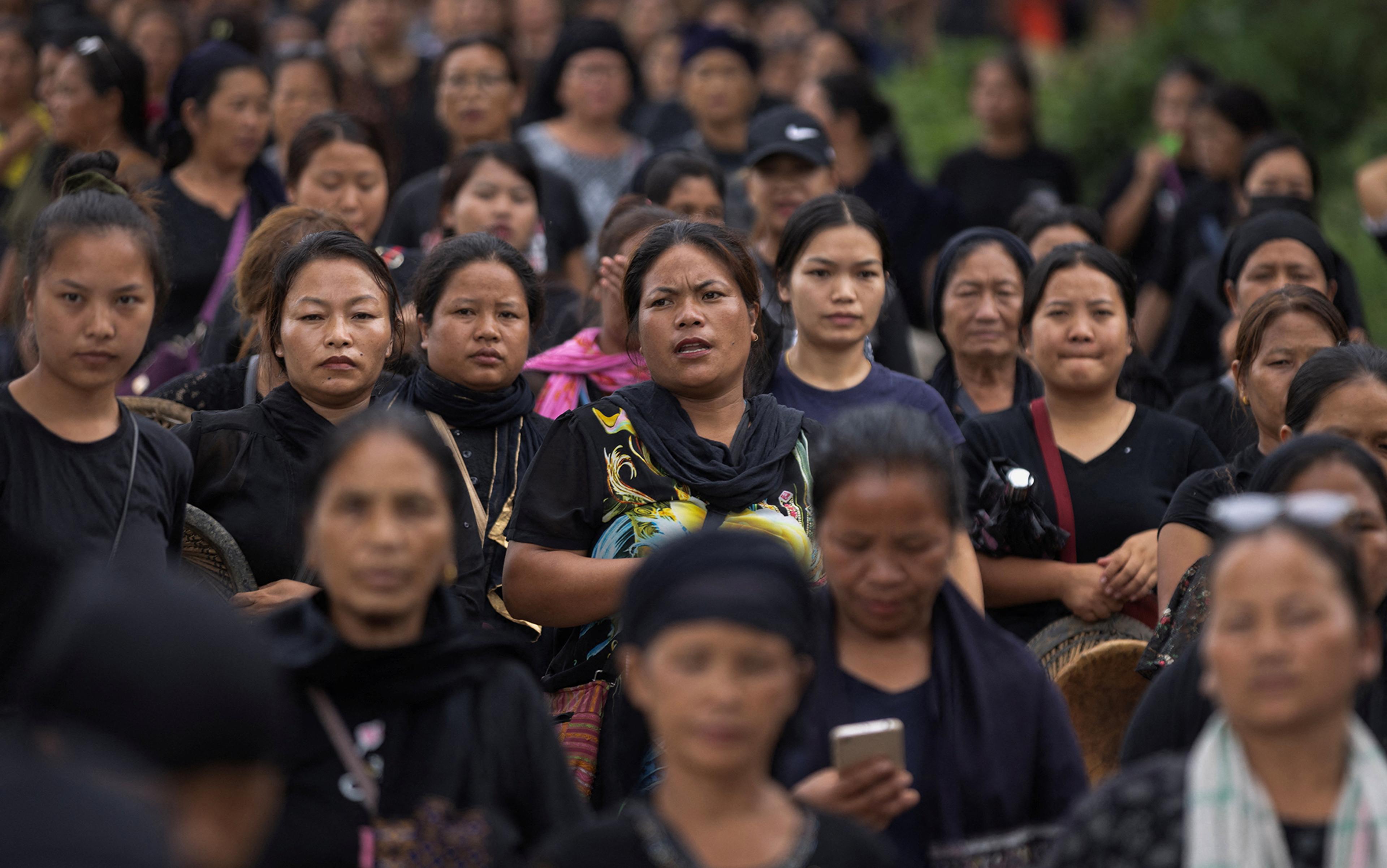
Kuki women attending a protest in Churachandpur District in the northeastern state of Manipur, India, 22 July 2023. Photo by Adnan Abidi/Reuters
India and indigeneity
In a country of such extraordinary diversity, the un definition of ‘indigenous’ does little more than fuel ethnic violence.
by Dikshit Sarma Bhagabati + BIO
In early May 2023, a video surfaced on social media of a mob of young men parading two naked women. With the women’s faces, bosoms and genitalia blurred, the boys could be heard chastising them: ‘Your men raped our women, now we will rape you.’ This happened in Manipur, a state in northeast India. ‘We’ denoted the Meiteis, the dominant tribe in the state, and ‘you’ the Kukis, their hill neighbours.
In December 2019, on the plains of neighbouring Assam, a huge civil-society movement against the Citizenship Amendment Act (CAA) was taking shape. The CAA is a controversial law that grants fast-track citizenship to Hindu, Sikh, Buddhist, Jain, Parsi and Christian – but not Muslim – immigrants from Pakistan, Afghanistan and Bangladesh. People across religions and classes took to the streets, raising slogans that ultimately boiled down to a common sentiment : ‘We are the sons of the soil, and they must be deported.’ Here, ‘we’ represented Assamese speakers, and ‘they’ referred to the Bangladeshi immigrants against whom the Assamese have been rallying since the mid-1970s.
The Assamese and Meitei nativists both drew on a common impulse to prefigure themselves as indigenous while reviling another as a threat to the purity of their indigeneity. However, against the claims of the Meiteis and the Assamese, the Kukis and the Bengali-speaking immigrants also maintain avowals of indigeneity.
Assam and Manipur are bordering states in the northeastern stretch of India. Located at the confluence of South Asia and Southeast Asia, the region serves as the country’s gateway to Tibet, Bangladesh and Myanmar. Since May 2023, the Meiteis and the Kukis have been engaged in an ethnic strife that has killed at least 175 people, injured 1,000 more, destroyed more than 4,000 houses, and left close to 70,000 displaced. Though the anti-CAA movement in Assam took far fewer lives, mostly resulting in the death of Assamese protesters due to police brutality, it brought civic and economic activities in the state to a standstill for close to two months. As much as the political conflicts in Manipur and Assam differ in important ways, both also feature groups with overlapping, at times even mutually exclusive, claims over land, nativity and nationhood that rest on the mantle of indigeneity. From caste-Hindu communities to tribes living in the contiguous highlands between India and Myanmar, multiple groups identify as indigenous. Yet none of them can fully satisfy the definition of indigenous peoples that has emerged in international law and Indian jurisprudence.
W hat international law has to say about indigeneity has repercussions outside courtrooms and global organisations. Since the 1960s, there has been a flow of ideas from decolonial struggles on the margins to influential legal institutions, defining who is indigenous and who is not. These definitions have then travelled back to the grassroots in vernacularised idioms. The intellectual itinerary of ‘indigeneity’ has been a circuit back and forth between the UN and its allied institutions, on the one hand, and societies in the Americas and Oceania that have experienced a wholesale replacement of their native populations, or settler colonialism, on the other. India, meanwhile, is mired in its own squabbles over tribality, caste and religion. Indian contests over forms of belonging do not quite accord with the efforts underway in the West to internationalise indigeneity.
Until about 50 years ago, indigenous peoples were completely absent from global institutions. Their legal personality arose in contrast to the enduring effects of the European conquest and the genocides in the Americas and Australia. It was only in 1971 that the UN finally admitted in ECOSOC Resolution 1589 (L) that ‘indigenous populations often encounter racial prejudice and discrimination’. Special Rapporteur José Martínez Cobo was then tasked with compiling a detailed report on the status of indigenous groups around the world. The prevalent belief at that point in time favoured the integration of these disenfranchised communities within their parent states. Cobo’s 25-chapter report , published over 12 years, offered a definition of indigeneity that still remains the dominant legal standard.
Indigeneity has become just another ambivalent and opportunity-costed postcolonial identity
To put it succinctly, Cobo constructed two objective markers of indigeneity: precolonial continuity and territorial rootedness. The first seeks to carve ‘historical continuity with pre-invasion and pre-colonial societies’. The second captures the intimate relationship that the indigenous share with their lands to differentiate them from ‘other sectors of the society’. In law and international covenants, these two criteria have become a hard-and-fast matrix to distinguish communities as indigenous and vest them with certain cultural and material rights. To this objective roster, the International Labour Organization’s handbook Understanding the Indigenous and Tribal Peoples Convention (1989) added a subjective element, allowing groups to self-identify as indigenous. We now have an awkward juridical position where the capacity to call oneself indigenous exists, but, in order to translate the entitlement into concrete rights, communities must rely on courts and international institutions that still encourage Cobo’s formula. Notably, Cobo’s objective criteria, along with subjective self-identification, loosely compose the putative understanding of indigeneity in the dialogue between international law and the struggles of the marginalised.
Over the past half century, the progress of indigenous rights has been so significant that communities today can harbour aspirations in international law to transcend the nation-states responsible for their historical enslavement. When municipal constitutionalism fails, the language of human rights provides an alternative framework for activism and action at multinational platforms – the Inter-American Court of Human Rights, for example. Creation stories, traditions of Dreaming, and other mythological or religious methods of land ownership can now be translated into the grammar of modern law to converse with the state and the civil society in the only voice they recognise. In India, on the contrary, competition over such strategic benefits has concocted a systemic trend of killing and maiming over who is more indigenous and to the exclusion of whom. Amid the country’s extraordinary diversity, indigeneity has become just another ambivalent and opportunity-costed postcolonial identity. Any liberatory promise of freedom contained within the concept has been obscured by violent recurrences of one Assam after another Manipur. In India, there really is no determinative way to spell out who is indigenous.
L et’s consider the insistence on precolonial continuity in Cobo’s definition, which has also become a commonsensical notion. The Meiteis in Manipur, who populate the plains, portray themselves as more indigenous since they have purportedly been living there for longer than the Kukis in the nearby hills. The Meiteis are largely Hindu, hence their sense of being there concomitantly fuses the Hindu Right’s impossible assertion of timeless sovereignty over India. The Kukis are predominantly Christian, and their conversion in the past 200 years is derided by the Meiteis as a break from their indigenous or tribal faith. The Kukis in turn dismiss Meitei indigeneity on the grounds that their Hindu affiliation should curtail any minority status. The recent violence in Manipur, after all, started after a High Court judgment recognising the Meiteis as a Scheduled Tribe, which would have given them affirmative action measures of a similar kind to that enjoyed by the Kukis. Tribality, or indigeneity, in India is not a trait to be determined once and for all, but is a dynamic assemblage of affinities and differences with respect to the caste-Hindu mainstream. Different communities can shift registers to indigeneity to proliferate a seemingly historical, anthropological or legal claim of belonging. But these truths, Manipur teaches us, are usually circumscribed by violent political or fundamentalist clashes.
The problem in Assam stems from the Assamese-speaking majority fearing that they will be rendered a minority in their own home if immigrants from Bangladesh are naturalised. Two facts cannot be denied. First, immigration is a reality in Assam. It began in the 19th century as a colonial policy of transporting labourers to cultivate inhospitable sandbars in the Brahmaputra basin, and was aggravated in the aftermath of the 1971 Bangladesh liberation war. Second, unlike the Hindu Right’s paranoia of Muslim domination, demographic overhauls are not uncommon to the Northeast. Between 1881 and 2011, the tribal population in the neighbouring state of Tripura dropped from 63.77 per cent to 31.78 per cent, turning them into a minority against Bengali immigrants. The Assamese thus have long been afraid of becoming homeless in their own home.
So, who is indigenous to Assam? In the 15th and 16th centuries, the caste-Hindu population was consolidated by a priestly class that came from mainland India. The Ahoms – the people who unified Assam and ruled the area until the British dethroned them in 1826 – themselves arrived here in the 13th century from South China. The tribes, likewise, can trace unhindered presence in the state only from the recent past, and have much older cultural ties across the Southeast Asian highlands. In protests, these communities all identify as Assamese speakers although some speak it only as a second language. They celebrate themselves as indigenous in distinction to Bengali immigrants. Most of these groups can show some magnitude of cultural uninterruptedness, truncated simply by an act of migration that clearly did not have colonial motives. But they also exhibit a xenophobia that frequently erupts as riots and the internment of Bangladeshi immigrants in premises harrowingly akin to concentration camps. To speak of precolonial continuity in this situation does not lead to any ascertainment of indigeneity; for the question of varying degrees and dynamics of continuity within the category of Assamese speakers cannot be resolved through Cobo’s criteria. The Assamese themselves do not care for greater clarity in their movements for belonging and self-determination. As a result, we have another instance where indigeneity in India is linked to exclusion and violence.
The contours of that indigenous personality are contested, so territory affords little help in identification
Cobo’s idea of territorial rootedness has produced another share of dangers. Territory in indigenous struggles entails more than land ownership. It often becomes a material venue that hosts fights against resource extraction. To talk of territory is to inaugurate dialogue between various indigenous peoples and between the indigenous and their settler neighbours about self-determination, co-managing resources, and apportioning legal entitlements. In India as well, marginalised communities have highlighted their profound associations with where they live to combat the militant-managerial state’s hunger for natural riches that lie beneath their sacred hills and rivers. But when these justified claims are redirected against rival groups for control over scarce resources, indigeneity becomes a morbid weapon.
The Kukis contend that the Meiteis’ preponderance in the Imphal Valley has enabled a monopoly over developmental initiatives. The Meiteis, on the other hand, allege that the Kukis threaten the territorial integrity of India. By accommodating ethnically similar immigrants from Myanmar in their villages, the Kukis supposedly have managed to boost their population to the brink of a demographic replacement. Their territorial relationship to an imagined ethnic terrain spread across the international border is taken by the Meiteis and Hindu nationalists as a token of disrespect to India’s sovereignty. Territory, by definition, is a political construction of geography. This is as valid elsewhere as it is in India. But in Australia and the Americas, movements around territorial control are oriented towards reclaiming the authority that European colonialism had invaded under the guise of terra nullius or barring the state from further expropriating these lands. In the settler-colonial societies of these continents, we can see coherence, in principle, in a reflexive distinction between indigenous and non-indigenous populations. In India, the contours of that indigenous personality itself are murky and contested, so territory affords little help in identification. It becomes another battleground.
In Assam, inclusion in the National Register of Citizens (NRC) required proving ancestry or residence in the state before 24 March 1971 through any one of 14 possible documents, among which were property records and electoral rolls. Many immigrants who had arrived recently managed to forge documents. Many who had been living in the state for generations lacked the necessary papers, and the state declared them foreigners. The government then planned to regularise the possession of numerous sandbars, the main home of immigrants, into ownership based on the new NRC. This project of who gets to rightfully call certain lands their own and who must be imprisoned prompted groups to manufacture nativity through a legal device to win property awards.
Unlike the Aboriginal peoples in Australia, very few communities in South Asia can backdate where they currently live to originary creation stories. For most, their communitarian folk identity is constitutive of constant movements. One can move upwards from Assam towards the Himalayas and would chance upon the Lisu people in Arunachal. Although they had migrated from modern-day Myanmar and China, they learned to call their current villages their undisturbed home until the state evicted them from their forests to create a national park. Or one can travel south to Mizoram’s border with Myanmar’s Chin State. Here the Bru people have been living under the threat of constant pogroms at the hands of the majority Mizo population. But the Mizo were quite content to open the borders for their ethnic brethren from Myanmar following the 2021 coup. The Mizo, the Bru and the Lisu are all tribal communities. Movement is at the heart of their history and selfhood. Any attempt to freeze this indeterminacy under the guise of indigeneity will only incite such groups to fight among themselves for supremacy over the territories where they now find themselves trapped.
I t might be possible to abjure Western notions of indigeneity drawn from their brush with settler colonialism and devise the concept anew for India. But doing so is not easy. Anthropologically, there remain doubts about how to objectively distinguish tribal formations. For the sake of argument, we can agree that those constitutionally designated as Scheduled Tribes are properly indigenous, irrespective of the heterogeneity within this classification itself. The difficulty arises when some tribal groups actually tend to fulfil Cobo’s criteria and still choose to represent themselves differently.
The word ‘Adivasi’ means original inhabitants. Some forest tribes use this self-referent as a more perspicacious name for their cultural uniqueness. Many present-day Adivasis trace their ancestry back by four millennia to the decline of the Indus Valley Civilisation. Their association with their traditional forests, too, goes back to antiquity. Alas, we may have found the Indian indigenous. The Gond, the Oraon, the Santhals can well seek membership in the international cast. Adivasi is not an official term regulated by the state, thus all the other tribes in the Northeast may also join the bandwagon and begin to so denote themselves.
At present, however, these northeastern communities prefer their tribal identities over being hailed as Adivasi. Regardless of anthropological and historical uncertainty, both terms invoke similar attitudes, though ‘Adivasi’ foregrounds the entitlement of being original inhabitants, whereas ‘tribality’ underlines differentiation from the caste-Hindu, capitalist mainstream. Wanting to be indigenous as tribals is a political refusal to subscribe to Adivasi marginalisation. Still more, the Adivasis themselves hold on to their unique identification. It is not that they have never claimed to be indigenous. Nor is it the case that the concept has not been gaining popular appeal and theoretical currency of late. Rather, indigeneity for the Adivasis is a semantic gambit devoid of the conceptual baggage it carries in international law and popularly in the West. In their dealings with the state, civil society and mainstream populations, they present themselves by the chosen name of their organised solidarity – original inhabitants, quite indigenous, but à la an Adivasi, not an indigenous, people.
The Mizo, the Kukis, the Meiteis and others harness the term to help hide their wanton records
The Adivasis in the Chota Nagpur Plateau have grown tired of the Indian legal system’s prolonged failure to stop their lands from being mined and their forests from being cleared. In response, they conceived of a movement called Pathalgadi. They engraved their constitutional rights on gigantic stone tablets that are usually epitaphs to dead ancestors. The move signified the national civic legal order as dead to them because the communities wanted to show that they could represent their rights better than the Indian state. The solidarity they were striving to build was across Adivasi cosmologies and not the globalised index of indigeneity. For them, Adivasi was the politically loaded term, while indigeneity, when used intermittently, was just an everyday shorthand to translate the belonging they were fighting for into a language intelligible to all.
Even those who seem to fit the American and Australian template of indigeneity in India have an alternative way – an Adivasi way – to define themselves. This is in addition to the Mizo, the Kukis, the Meiteis and others who harness the term to help hide their wanton records. The UN Declaration on the Rights of Indigenous Peoples gives us an alternative to the deadlock of whether indigeneity or being indigenous in India is a strictly legal matter. It advocates the subjective right of groups to self-identify, which opens up the possibility of fostering the term as a political comparative to link select organised movements around the world. The prospects of these struggles rely on agreement as to who is indigenous. In India, the established criteria in international law and the dominant scholarship make the matter of indigeneity itself a source of confusion, ending up as a racialised justification for violence.
Be it in Assam or Manipur, or of the Mizo or the Pathalgadi Adivasis, their struggles are all geared towards self-determination. Conversely, their travails stem from the intrusion, apathy and high-handedness of the state. Why should they not fight for complete sovereignty, for freedom from the state that has failed them? One, international law denies sovereignty to indigenous self-determination. In fact, The Indigenous and Tribal Peoples Convention of 1989 stipulates that ‘the term peoples’, when read with indigenous, ‘shall not be construed as having any implications as regards the rights which may attach to the term under international law’. Second, flirting with secessionism is a risky move, especially if the enemy now is not the courtroom or another community but the formal armed forces. Very few groups, therefore, exhibit consensus in desiring freedom at such high costs. And secessionism is not a guarantee against violence, however justified its cause might be. There is no assurance that partitioning Manipur into two separate states for the Kukis and the Meteis will ensure a peaceful population transfer or that xenophobia will wane out in an independent Assam. But a newfound zeal for full sovereignty in these places will disentangle indigeneity from what the people are actually struggling for – freedom from the disorder spawned by the Indian state.
Without any theoretical cohesion about what the term ‘indigenous’ denotes, it will continue to be an empty signifier that India has borrowed from elsewhere. The only substance behind it has proven to be violence. No doubt anthropologists, political theorists and critical legal scholars have also criticised the rigid Western design of indigeneity and cautioned against adopting it as a universally cogent concept. Many have also regretted the violence inflicted in its name. But in India these pathologies have become the rule. Since, as we saw, the fundamental method of designating indigeneity does not work here, there is no medium except violence to settle competing claims – neither a legal doctrine, nor any scope for public reasoning. This, in the end, brings us to two conclusions. First, no matter how vernacularised, localised or situated indigeneity gets as we move towards the grassroots, the persistence of a Western agent – be it in international law, academia or activism – means that the spectre of objective definitions will return every so often as conflicts even in places where they are supposed to work. Yet without transnational networks and some international supervision, there is no assurance that indigenous peoples anywhere will finally be free from pain and suffering in their home countries. Perhaps all experiences of oppression need not be articulated in the lexis of indigeneity. There are other political methods, like the Adivasis’, to envision a shared feeling of belonging somewhere before colonisers took over. Indigeneity may be useful for others, but we can pull the plug on it in India.
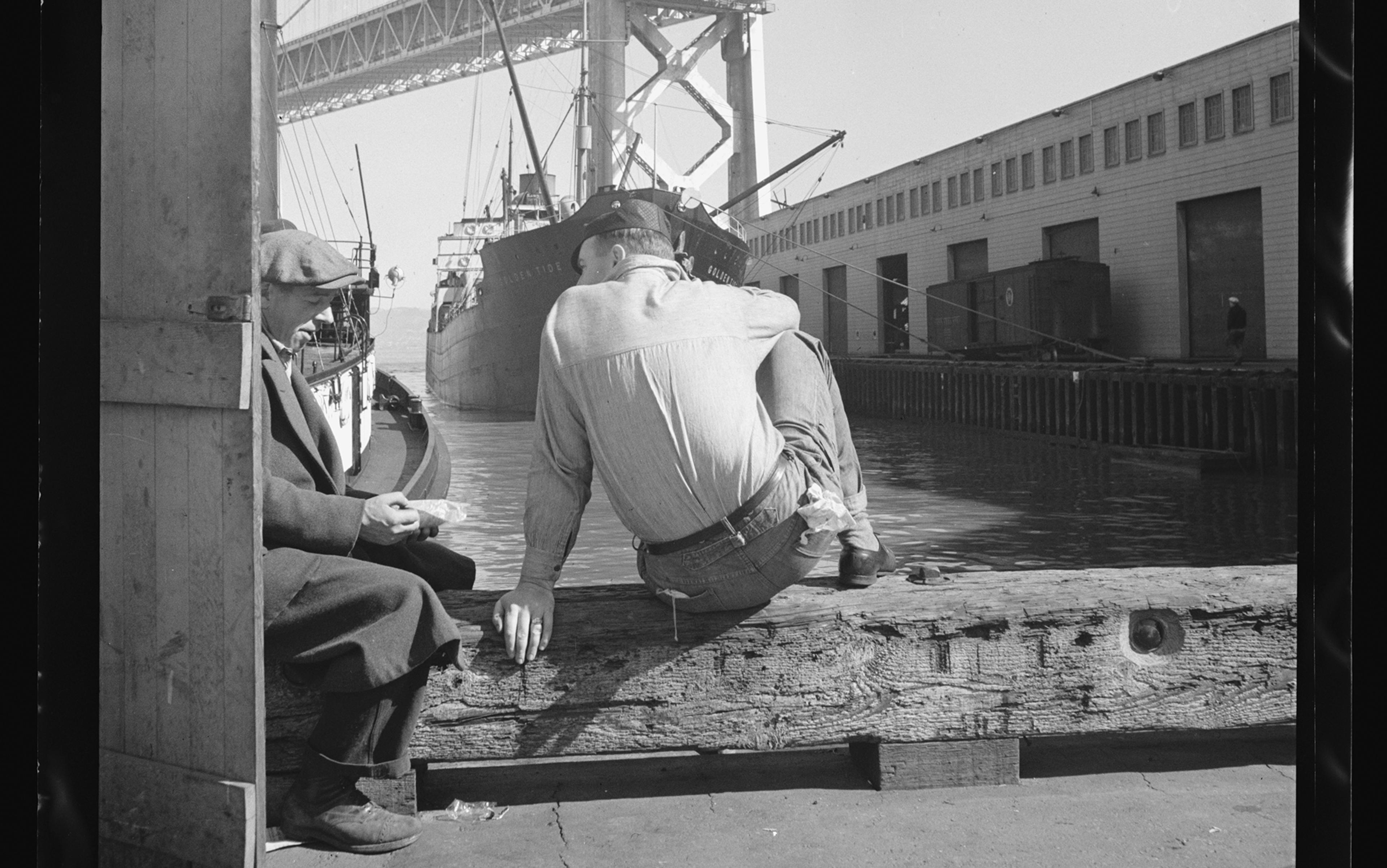
Stories and literature
Do liberal arts liberate?
In Jack London’s novel, Martin Eden personifies debates still raging over the role and purpose of education in American life
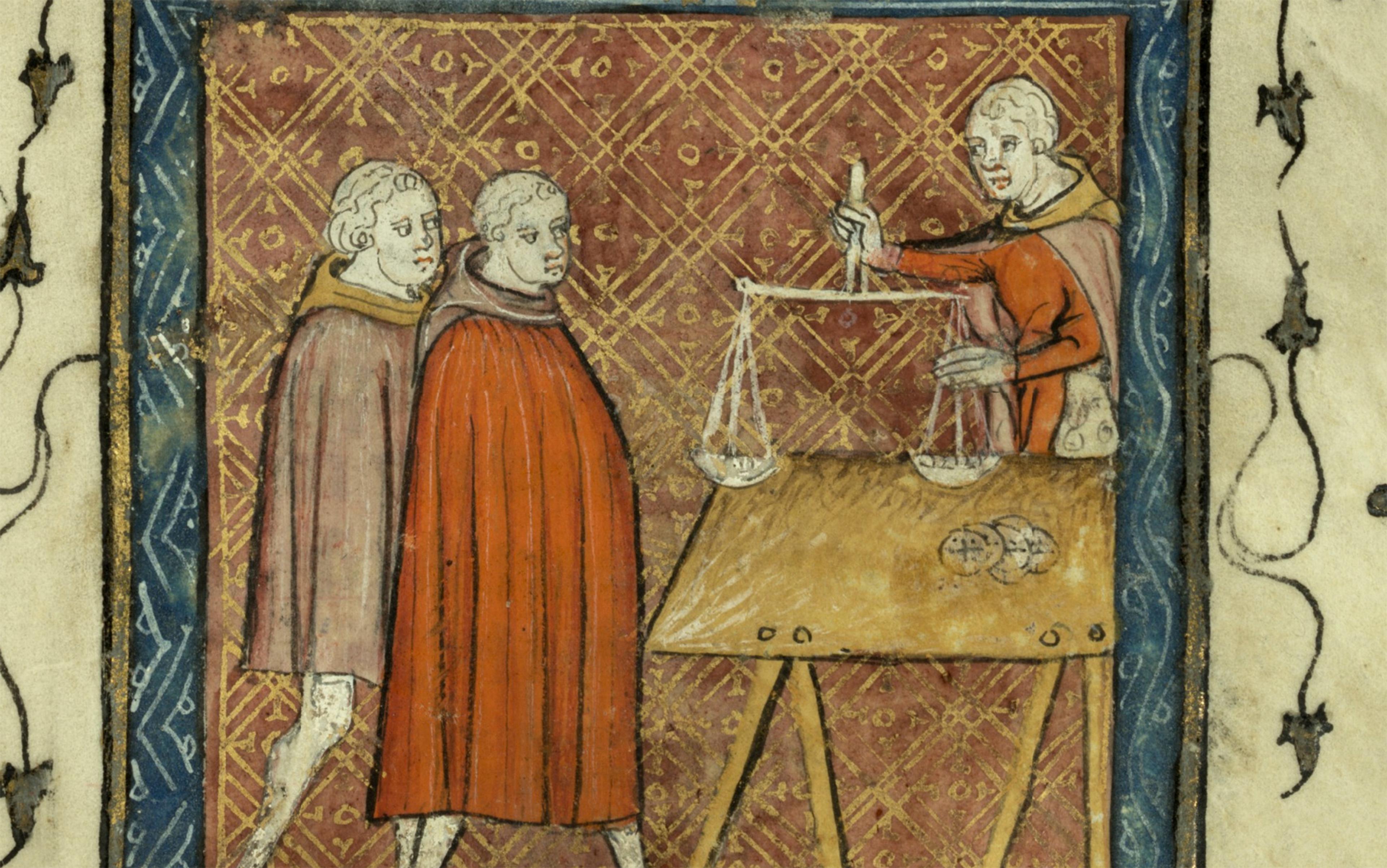
History of ideas
Reimagining balance
In the Middle Ages, a new sense of balance fundamentally altered our understanding of nature and society

What would Thucydides say?
In constantly reaching for past parallels to explain our peculiar times we miss the real lessons of the master historian
Mark Fisher

The environment
Emergency action
Could civil disobedience be morally obligatory in a society on a collision course with climate catastrophe?
Rupert Read

Return of the descendants
I migrated to my ancestral homeland in a search for identity. It proved to be a humbling experience in (un)belonging
Jessica Buchleitner

Economic history
Credit card nation
Americans have always borrowed, but how exactly did their lives become so entangled with the power of plastic cards?
Sean H Vanatta
What are your chances of acceptance?
Calculate for all schools, your chance of acceptance.
Your chancing factors
Extracurriculars.
6 Diversity College Essay Examples
What’s covered:, how to write the diversity essay after the end of affirmative action, essay #1: jewish identity, essay #2: being bangladeshi-american, essay #3: marvel vs dc, essay #4: leadership as a first-gen american, essay #5: protecting the earth, essay #6: music and accents, where to get your diversity essays edited, what is the diversity essay.
While working on your college applications, you may come across essays that focus on diversity , culture, or values. The purpose of these essays is to highlight any diverse views or opinions that you may bring to campus. Colleges want a diverse student body that’s made up of different backgrounds, religions, ethnicities, sexual orientations, and interests. These essay prompts are a way for them to see what students can bring to their school.
In this post, we will share six essays written by real students that cover the topic of culture and diversity. We’ll also include what each essay did well and where there is room for improvement. Hopefully, this will be a useful resource to inspire your own diversity essay.
Please note: Looking at examples of real essays students have submitted to colleges can be very beneficial to get inspiration for your essays. That said, you should never copy or plagiarize from these examples when writing your own essays. Colleges can tell when an essay isn’t genuine and they will not have a favorable view of students who have plagiarized.
In June 2023, the Supreme Court ruled that the use of race in college admissions was unconstitutional. In other words, they struck down the use of affirmative action in college admissions . This will affect college-bound students of color in a number of ways, including lowering their chances of acceptance and reducing the amount of direct outreach they’ll receive from colleges. Another change to consider is the ways in which students should tackle their diversity essays.
Although colleges can no longer directly factor race into admissions, students aren’t prohibited from discussing their racial backgrounds in supplemental application essays. If your racial background is important to you, seriously consider writing about it in your diversity essays. If you don’t, admissions officers are extremely limited in their ability to consider your race when making an admission decision.
As in the essays listed below, discussing your race is an excellent tool for showing admissions officers the person behind the grades and test scores. Beyond that, it provides admissions officers with an opportunity to put themselves in your shoes—showing them how your background has presented challenges to overcome, helped build important life skills, and taught you valuable lessons.
Diversity Essay Examples
I was thirsty. In my wallet was a lone $10 bill, ultimately useless at my school’s vending machine. Tasked with scrounging together the $1 cost of a water bottle, I fished out and arranged the spare change that normally hid in the bottom of my backpack in neat piles of nickels and dimes on my desk. I swept them into a spare Ziploc and began to leave when a classmate snatched the bag and held it above my head.
“Want your money back, Jew?” she chanted, waving the coins around. I had forgotten the Star-of-David around my neck, but quickly realized she must have seen it and connected it to the stacks of coins. I am no stranger to experiencing and confronting antisemitism, but I had never been targeted in my school before. I grabbed my bag and sternly told her to leave. Although she sauntered away, the impact remained.
This incident serves as an example of the adversity I have and will continue to face from those who only see me as a stereotype. Ironically, however, these experiences of discrimination have only increased my pride as a member of the Jewish Community. Continuing to wear the Star-of-David connects me to my history and my family. I find meaning and direction in my community’s values, such as pride, education, and giving—and I am eager to transfer these values to my new community: the Duke community.
What the Essay Did Well
Writing about discrimination can be difficult, but if you are comfortable doing it, it can make for a powerful story. Although this essay is short and focused on one small interaction, it represents a much larger struggle for this student, and for that reason it makes the essay very impactful.
The author takes her time at the beginning of the essay to build the scene for the audience, which allows us to feel like we are there with her, making the hateful comments even more jarring later on. If she had just told us her classmate teased her with harmful stereotypes, we wouldn’t feel the same sense of anger as we do knowing that she was just trying to get a drink and ended up being harassed.
This essay does another important thing—it includes self-reflection on the experience and on the student’s identity. Without elaborating on the emotional impact of a situation, an essay about discrimination would make admission officers feel bad for the student, but they wouldn’t be compelled to admit the student. By describing how experiences like these drive her and make her more determined to embody positive values, this student reveals her character to the readers.
What Could Be Improved
While including emotional reflection in the latter half of the essay is important, the actual sentences could be tightened up a bit to leave a stronger impression. The student does a nice job of showing us her experience with antisemitism, but she just tells us about the impact it has on her. If she instead showed us what the impact looked like, the essay would be even better.
For example, rather than telling us “Continuing to wear the Star-of-David connects me to my history and my family,” she could have shown that connection: “My Star-of-David necklace thumps against my heart with every step I take, reminding me of my great-grandparents who had to hide their stars, my grandma’s spindly fingers lighting the menorah each Hanukkah, and my uncle’s homemade challah bread.” This new sentence reveals so much more than the existing sentence about the student and the deep connection she feels with her family and religion.
Life before was good: verdant forests, sumptuous curries, and a devoted family.
Then, my family abandoned our comfortable life in Bangladesh for a chance at the American dream in Los Angeles. Within our first year, my father was diagnosed with thyroid cancer. He lost his battle three weeks before my sixth birthday. Facing a new country without the steady presence of my father, we were vulnerable—prisoners of hardship in the land of the free.
We resettled in the Bronx, in my uncle’s renovated basement. It was meant to be our refuge, but I felt more displaced than ever. Gone were the high-rise condos of West L.A.; instead, government projects towered over the neighborhood. Pedestrians no longer smiled and greeted me; the atmosphere was hostile, even toxic. Schoolkids were quick to pick on those they saw as weak or foreign, hurling harsh words I’d never heard before.
Meanwhile, my family began integrating into the local Bangladeshi community. I struggled to understand those who shared my heritage. Bangladeshi mothers stayed home while fathers drove cabs and sold fruit by the roadside—painful societal positions. Riding on crosstown buses or walking home from school, I began to internalize these disparities.
During my fleeting encounters with affluent Upper East Siders, I saw kids my age with nannies, parents who wore suits to work, and luxurious apartments with spectacular views. Most took cabs to their destinations: cabs that Bangladeshis drove. I watched the mundane moments of their lives with longing, aching to plant myself in their shoes. Shame prickled down my spine. I distanced myself from my heritage, rejecting the traditional panjabis worn on Eid and refusing the torkari we ate for dinner every day.
As I grappled with my relationship with the Bangladeshi community, I turned my attention to helping my Bronx community by pursuing an internship with Assemblyman Luis Sepulveda. I handled desk work and took calls, spending the bulk of my time actively listening to the hardships constituents faced—everything from a veteran stripped of his benefits to a grandmother unable to support her bedridden grandchild.
I’d never exposed myself to stories like these, and now I was the first to hear them. As an intern, I could only assist in what felt like the small ways—pointing out local job offerings, printing information on free ESL classes, reaching out to non-profits. But to a community facing an onslaught of intense struggles, I realized that something as small as these actions could have vast impacts.
Seeing the immediate consequences of my actions inspired me. Throughout that summer, I internalized my community’s daily challenges in a new light. I began to see the prevalent underemployment and cramped living quarters less as sources of shame. Instead, I saw them as realities that had to be acknowledged, but that could ultimately be remedied.
I also realized the benefits of the Bangladeshi culture I had been so ashamed of. My Bangla language skills were an asset to the office, and my understanding of Bangladeshi etiquette allowed for smooth communication between office staff and the office’s constituents. As I helped my neighbors navigate city services, I saw my heritage with pride—a perspective I never expected to have.
I can now appreciate the value of my unique culture and background, and the value of living with less. This perspective offers room for progress, community integration, and a future worth fighting for. My time with Assemblyman Sepulveda’s office taught me that I can be an agent of change who can enable this progression. Far from being ashamed of my community, I want to someday return to local politics in the Bronx to continue helping others access the American Dream. I hope to help my community appreciate the opportunity to make progress together. By embracing reality, I learned to live it. Along the way, I discovered one thing: life is good, but we can make it better.
This student’s passion for social justice and civic duty shines through in this essay because of how honest it is. Sharing their personal experience with immigrating, moving around, being an outsider, and finding a community allows us to see the hardships this student has faced and builds empathy towards their situation.
However, what really makes it strong is that the student goes beyond describing the difficulties they faced and explains the mental impact it had on them as a child: “Shame prickled down my spine. I distanced myself from my heritage, rejecting the traditional panjabis worn on Eid and refusing the torkari we ate for dinner every day.” The rejection of their culture presented at the beginning of the essay creates a nice juxtaposition with the student’s view in the latter half of the essay, and helps demonstrate how they have matured.
They then use their experience interning as a way to delve into a change in their thought process about their culture. This experience also serves as a way to show how their passion for social justice began. Using this experience as a mechanism to explore their thoughts and feelings is an excellent example of how items that are included elsewhere on your application should be incorporated into your essay.
This essay prioritizes emotions and personal views over specific anecdotes. Although there are details and certain moments incorporated throughout to emphasize the author’s points, the main focus remains on the student and how they grapple with their culture and identity.
One area for improvement is the conclusion. Although the forward-looking approach is a nice way to end an essay focused on social justice, it would be nice to include more details and imagery in the conclusion. How does the student want to help their community? What government position do they see themselves holding one day?
A more impactful ending might describe the student walking into their office at the New York City Housing Authority in 15 years. This future student might be looking at the plans to build a new development in the Bronx just blocks away from where they grew up that would provide quality housing to people in their Bangladeshi community. They would smile while thinking about how far they have come from that young kid who used to be ashamed of their culture.
Superhero cinema is an oligopoly consisting of two prominent, towering brands: Marvel and DC. I’m a religious supporter of Marvel, but last year, I discovered that my friend, Tom, was a DC fan. After a vociferous 20-minute quarrel about which was better, we decided to allocate one day to have a professional debate, using carefully assembled and coherent arguments.
One week later, we both brought pages of notes and evidence cards (I also had my Iron-Man bobblehead for moral support). Our impartial moderator—a Disney fan—sat in the middle with a stopwatch, open-policy style. I began the debate by discussing how Marvel accentuated the humanity of the storyline—such as in Tony Stark’s transformation from an egotistical billionaire to a compassionate father—which drew in a broader audience, because more people resonated with certain aspects of the characters. Tom rebutted this by capitalizing on how Deadpool was a duplicate of Deathstroke, how Vision copied Red Tornado, and how DC sold more comics than Marvel.
40 minutes later, we reached an impasse. We were out of cards, and we both made excellent points, so our moderator was unable to declare a winner. Difficult conversations aren’t necessarily always the ones that make political headlines. Instead, a difficult discussion involves any topic with which people share an emotional connection.
Over the years, I became so emotionally invested in Marvel that my mind erected an impenetrable shield, blocking out all other possibilities. Even today, we haven’t decided which franchise was better, but I realized that I was undermining DC for no reason other than my own ignorance.
The inevitability of diversity suggests that it is our responsibility to understand the other person and what they believe in. We may not always experience a change in opinion, but we can grant ourselves the opportunity to expand our global perspective. I strive to continue this adventure to increase my awareness as a superhero aficionado, activist, and student, by engaging in conversations that require me to think beyond what I believe and to view the world from others’ perspectives.
And yes, Tom is still my friend.
Diversity doesn’t always have to be about culture or heritage; diversity exists all around us, even in our comic book preferences. The cleverness of this essay lies in the way the student flipped the traditional diversity prompt on its head and instead discussed his diverse perspective on a topic he is passionate about. If you don’t have a cultural connection you are compelled to write about, this is a nifty approach to a diversity prompt—if it’s handled appropriately.
While this student has a non-traditional topic, he still presents it in a way that pays respect to the key aspects of a diversity essay: depicting his perspective and recognizing the importance of diverse views. Just as someone who is writing about a culture that is possibly unfamiliar to the reader, the student describes what makes Marvel and DC unique and important to him and his friend, respectively. He also expands on how a lack of diversity in superhero consumption led to his feeling of ignorance, and how it now makes him appreciate the need for diversity in all aspects of his life.
This student is unapologetically himself in this essay, which is ultimately why this unorthodox topic is able to work. He committed to his passion for Marvel by sharing analytical takes on characters and demonstrating how the franchise was so important to his identity that it momentarily threatened a friendship. The inclusion of humor through his personal voice—e.g., referring to the argument as a professional debate and telling us that the friendship lived on—contributes to the essay feeling deeply personal.
Choosing an unconventional topic for a diversity essay requires extra care and attention to ensure that you are still addressing the core of the prompt. That being said, if you accomplish it successfully, it makes for an incredibly memorable essay that could easily set you apart!
While this is a great essay as is, the idea of diversity could have been addressed a little bit earlier in the piece to make it absolutely clear the student is writing about his diverse perspective. He positions Marvel and DC as two behemoths in the superhero movie industry, but in the event that his reader is unfamiliar with these two brands, there is little context about the cultural impact each has on its fans.
To this student, Marvel is more than just a movie franchise; it’s a crucial part of his identity, just as someone’s race or religion might be. In order for the reader to fully understand the weight of his perspective, there should be further elaboration—towards the beginning—on how important Marvel is to this student.
Leadership was thrust upon me at a young age. When I was six years old, my abusive father abandoned my family, leaving me to step up as the “man” of the house. From having to watch over my little sister to cooking dinner three nights a week, I never lived an ideal suburban life. I didn’t enjoy the luxuries of joining after-school activities, getting driven to school or friends’ houses, or taking weekend trips to the movies or bowling alley. Instead, I spent my childhood navigating legal hurdles, shouldering family responsibilities, and begrudgingly attending court-mandated therapy sessions.
At the same time, I tried to get decent grades and maintain my Colombian roots and Spanish fluency enough to at least partially communicate with my grandparents, both of whom speak little English. Although my childhood had its bright and joyful moments, much of it was weighty and would have been exhausting for any child to bear. In short, I grew up fast. However, the responsibilities I took on at home prepared me to be a leader and to work diligently, setting me up to use these skills later in life.
I didn’t have much time to explore my interests until high school, where I developed my knack for government and for serving others. Being cast in a lead role in my school’s fall production as a freshman was the first thing to give me the confidence I needed to pursue other activities: namely, student government. Shortly after being cast, I was elected Freshman Vice-President, a role that put me in charge of promoting events, delegating daily office tasks, collaborating with the administration on new school initiatives, and planning trips and fundraisers.
While my new position demanded a significant amount of responsibility, my childhood of helping my mom manage our household prepared me to be successful in the role. When I saw the happy faces of my classmates after a big event, I felt proud to know that I had made even a small difference to them. Seeing projects through to a successful outcome was thrilling. I enjoyed my time and responsibilities so much that I served all four years of high school, going on to become Executive Vice-President.
As I found success in high school, my mother and grandparents began speaking more about the life they faced prior to emigrating from Colombia. To better connect with them, I took a series of Spanish language classes to regain my fluency. After a practice run through my presentation on Bendíceme, Ultima ( Bless me, Ultima ) by Rudolofo Anaya, with my grandmother, she squeezed my hand and told me the story of how my family was forced from their home in order to live free of religious persecution. Though my grandparents have often expressed how much better their lives and their children’s lives have been in America, I have often struggled with my identity. I felt that much of it was erased with my loss of our native language.
In elementary school, I learned English best because in class I was surrounded by it. Spanish was more difficult to grasp without a formal education, and my family urged me to become fluent in English so I could be of better help to them in places as disparate as government agencies and grocery stores. When I was old enough to recognize the large part of my identity still rooted in being Colombian, it was challenging to connect these two sides of who I was.
Over time I have been able to reconcile the two in the context of my aspirations. I found purpose and fulfillment through student council, and I knew that I could help other families like my own if I worked in local government. By working through city offices that address housing, education, and support for survivors of childhood abuse, I could give others the same liberties and opportunities my family has enjoyed in this country. Doing so would also help me honor my roots as a first-generation American.
I have been a leader my entire life. Both at Harvard and after graduation, I want to continue that trend. I hope to volunteer with organizations that share my goals. I want to advise policy-making politicians on ways to make children and new immigrants safer and more secure. When my family was at their worst, my community gave back. I hope to give that gift to future generations. A career in local, city-based public service is not a rashly made decision; it is a reflection of where I’ve already been in life, and where I want to be in the future.
Although this essay begins on a somber note, it goes on to show this student’s determination and the joy he found. Importantly, it also ends with a positive, forward-looking perspective. This is a great example of how including your hardship can bolster an essay as long as it is not the essay’s main focus.
Explaining the challenges this student faced from a young age—becoming the man of the house, dealing with legal matters, maintaining good grades, etc.—builds sympathy for his situation. However, the first paragraph is even more impactful because he explains the emotional toll these actions had on him. We understand how he lost the innocence of his childhood and how he struggled to remain connected to his Colombian heritage with all his other responsibilities. Including these details truly allows the reader to see this student’s struggle, making us all the more joyful when he comes out stronger in the end.
Pivoting to discuss positive experiences with student government and Spanish classes for the rest of the essay demonstrates that this student has a positive approach to life and is willing to push through challenges. The tone of the essay shifts from heavy to uplifting. He explains the joy he got out of helping his classmates and connecting with his grandparents, once again providing emotional reflection to make the reader care more.
Overall, this essay does a nice job of demonstrating how this student approaches challenges and negative experiences. Admitting that the responsibilities of his childhood had a silver lining shows his maturity and how he will be able to succeed in government one day. The essay strikes a healthy balance between challenge and hope, leaving us with a positive view of a student with such emotional maturity.
Although the content of this essay is very strong, it struggles with redundancy and disorganized information. He mentions his passion for government at the beginning of the student government paragraph, then again addresses government in the paragraph focused on his Colombian heritage, and concludes by talking about how he wants to get into government once more. Similarly, in the first paragraph, he discusses the struggle of maintaining his Colombian identity and then fully delves into that topic in the third paragraph.
The repetition of ideas and lack of a streamlined organization of this student’s thoughts diminishes some of the emotional impact of the story. The reader is left trying to piece together a swirling mass of information on their own, rather than having a focused, sequential order to follow.
This could be fixed if the student rearranged details to make each paragraph focused on a singular idea. For example, the first paragraph could be about his childhood. The second could be about how student government sparked his interest in government and what he hopes to do one day. The third could be about how he reconnected with his Colombian roots through his Spanish classes, after years of struggling with his identity. And the final paragraph could tie everything together by explaining how everything led to him wanting to pursue a future serving others, particularly immigrants like his family.
Alternatively, the essay could follow a sequential order that would start with his childhood, then explain his struggle with his identity, then show how student government and Spanish classes helped him find himself, and finally, conclude with what he hopes to accomplish by pursuing government.
I never understood the power of community until I left home to join seven strangers in the Ecuadorian rainforest. Although we flew in from distant corners of the U.S., we shared a common purpose: immersing ourselves in our passion for protecting the natural world.
Back home in my predominantly conservative suburb, my neighbors had brushed off environmental concerns. My classmates debated the feasibility of Trump’s wall, not the deteriorating state of our planet. Contrastingly, these seven strangers delighted in bird-watching, brightened at the mention of medicinal tree sap, and understood why I once ran across a four-lane highway to retrieve discarded beer cans.
Their histories barely resembled mine, yet our values aligned intimately. We did not hesitate to joke about bullet ants, gush about the versatility of tree bark, or discuss the destructive consequences of materialism. Together, we let our inner tree-huggers run free.
In the short life of our little community, we did what we thought was impossible. By feeding on each other’s infectious tenacity, we cultivated an atmosphere that deepened our commitment to our values and empowered us to speak out on behalf of the environment. After a week of stimulating conversations and introspective revelations about engaging people from our hometowns in environmental advocacy, we developed a shared determination to devote our lives to this cause.
As we shared a goodbye hug, my new friend whispered, “The world needs saving. Someone’s gotta do it.” For the first time, I believed that that someone could be me.
This student is expressing their diversity through their involvement in a particular community—another nice approach if you don’t want to write about culture or ethnicity. We all have unique things that we geek out over. This student expresses the joy that they derived from finding a community where they could express their love for the environment. Passion is fundamental to university life and generally finds its way into any successful application.
The essay finds strength in the fact that readers feel for the student. We get a little bit of backstory about where they come from and how they felt silenced— “Back home in my predominantly conservative suburb, my neighbors had brushed off environmental concerns” —so it’s easy to feel joy for them when they get set free and finally find their community.
This student displays clear values: community, ecoconsciousness, dedication, and compassion. An admissions officer who reads a diversity essay is looking for students with strong values who will enrich the university community with their unique perspective—that sounds just like this student!
One area of weakness in this essay is the introduction. The opening line— “I never understood the power of community until I left home to join seven strangers in the Ecuadorian rainforest” —is a bit clichéd. Introductions should be captivating and build excitement and suspense for what is to come. Simply telling the reader about how your experience made you understand the power of community reveals the main takeaway of your essay without the reader needing to go any further.
Instead of starting this essay with a summary of what the essay is about, the student should have made their hook part of the story. Whether that looks like them being exasperated with comments their classmates made about politics, or them looking around apprehensively at the seven strangers in their program as they all boarded their flight, the student should start off in the action.
India holds a permanent place in my heart and ears. Whenever I returned on a trip or vacation, I would show my grandmother how to play Monopoly and she would let me tie her sari. I would teach my grandfather English idioms—which he would repeat to random people and fishmongers on the streets—and he would teach me Telugu phrases.
It was a curious exchange of worlds that I am reminded of every time I listen to Indian music. It was these tunes that helped me reconnect with my heritage and ground my meandering identity. Indian music, unlike the stereotype I’d long been imbued with, was not just a one-and-done Bollywood dance number! Each region and language was like an island with its own unique sonic identity. I’m grateful for my discovery of Hindi, Telugu, Kannada, and Tamil tunes, for these discoveries have opened me up to the incredible smorgasbord of diversity, depth, and complexity within the subcontinent I was born in.
Here’s an entirely-different sonic identity for you: Texan slang. “Couldya pass the Mango seltzer, please, hon?” asked my Houstonian neighbor, Rae Ann—her syllables melding together like the sticky cake batter we were making.
Rae Ann and her twang were real curiosities to me. Once, she invited my family to a traditional Texan barbecue with the rest of our neighbors. As Hindus, we didn’t eat beef, so we showed up with chicken kebabs, instead. Rather than looking at us bizarrely, she gladly accepted the dish, lining it up beside grilled loins and hamburger patties.
Her gesture was a small but very well-accepted one and I quickly became convinced she was the human manifestation of “Southern hospitality”—something reflected in each of her viscous, honey-dripping phrases. “Watch out for the skeeters!” was an excellent example. It was always funny at first, but conveyed a simple message: We’ve got each other’s backs and together, we can overcome the blood-sucking mosquitoes of the Houstonian summer! I began to see how her words built bridges, not boundaries.
I believe that sounds—whether it’s music or accents—can make a difference in the ways we perceive and accept individuals from other backgrounds. But sound is about listening too. In Rice’s residential college, I would be the type of person to strike up a conversation with an international student and ask for one of their Airpods (you’d be surprised how many different genres and languages of music I’ve picked up in this way!).
As both an international student and Houstonian at heart, I hope to bridge the gap between Rice’s domestic and international populations. Whether it’s organizing cultural events or simply taking the time to get to know a student whose first language isn’t English, I look forward to listening to the stories that only a fellow wanderer can tell.
This essay does an excellent job of addressing two aspects of this student’s identity. Looking at diversity through sound is a very creative way to descriptively depict their Indian and Texan cultures. Essays are always more successful when they stimulate the senses, so framing the entire response around sound automatically opens the door for vivid imagery.
The quotes from this student’s quirky neighbor bring a sense of realism to the essay. We can feel ourselves at the barbecue and hear her thick Texan accent coming through. The way people communicate is a huge part of their culture and identity, so the way that this student perfectly captures the essence of their Texan identity with accented phrases is skillfully done.
This essay does such a great job of making the sounds of Texas jump off the page, so it is a bit disappointing that it wasn’t able to accomplish the same for India. The student describes the different Indian languages and music styles, but doesn’t bring them to life with quotes or onomatopoeia in the manner that they did for the sounds of Texas.
They could have described the buzz of the sitar or the lyrical pattern of the Telugu phrases their grandfather taught them. Telling us about the diversity of sounds in Indian music is fine, but if the reader can’t appreciate what those sounds resemble, it makes it harder to understand the Indian half of the author’s identity. Especially since this student emulated the sounds and essence of Texas so well, it’s important that India is given the same treatment so we can fully appreciate both sides of this essay.
More Supplemental Essay Tips
How to Write a Stellar “Why This College?” Essay + Examples
How to Write a Stellar Extracurricular Activity College Essay
Do you want feedback on your diversity essays? After rereading your essays countless times, it can be difficult to evaluate your writing objectively. That’s why we created our free Peer Essay Review tool , where you can get a free review of your essay from another student. You can also improve your own writing skills by reviewing other students’ essays.
If you want a college admissions expert to review your essay, advisors on CollegeVine have helped students refine their writing and submit successful applications to top schools. Find the right advisor for you to improve your chances of getting into your dream school!
Related CollegeVine Blog Posts

Your Article Library
Essay on the different forms of diversity in india.
ADVERTISEMENTS:
Here is your essay on the different forms of diversity seen in India for school and college students:
The diversity in India is unique. Being a large country with large population. India presents endless varieties of physical features and cultural patterns. It is the land of many languages it is only in India people professes all the major religions of the world. In short, India is “the epitome of the world”. The vast population is composed of people having diverse creeds, customs and colours. Some of the important forms of diversity in India are discussed below.

Image Courtesy : 3.bp.blogspot.com/_Nodr966MwnA/TOKnvCa-5JI/AAAAAAAADic/repday11.jpg
1. Diversity of Physical Features:
The unique feature about India is the extreme largest mountains covered with snow throughout the year. The Himalayas or the adobe of snow is the source of the mighty rivers like Indus. Ganga and Yamuna. These perennial rivers irrigate extensive areas in the North to sustain the huge population of the country. At the same time Northern India contains and zones and the desert of Rajasthan where nothing grows accept a few shrubs.
2. Racial Diversity:
A race is a group of people with a set of distinctive physical features such set skin, colour, type of nose, form of hair etc. A.W. Green says, “A race is a large biological human grouping with a number of distinctive, inherited characteristics which vary within a certain range.”
The Indian sub-continent received a large number of migratory races mostly from the Western and the Eastern directions. Majority of the people of India are descendants of immigrants from across the Himalayas. Their dispersal into sub-continent has resulted in the consequent regional concentration of a variety of ethnic elements. India is an ethnological museum Dr B.S Guha identifies the population of India into six main ethnic groups, namely (1) the Negrito’ (2) the Proto-Australoids, (3) the Mongoloids (4) the Mediterranean or Dravidian (5) the Western Brachycephals and (6) the Nordic. People belonging to these different racial stocks have little in common either in physical appearance or food habits. The racial diversity is very perplexing.
Herbert Risley had classified the people of India into seven racial types. These are- (1) Turko-Iranian (2) Indo-Aryan, (3) Scytho-Dravidian, (4) Aryo-Dravidian, (5) Mongo o- Dravidian, (6) Mongoloid and (7) Dravidian. These seven racial types can be reduced to three basic types- the Indo-Aryan, the Mongolian and the Dravidian. In his opinion the last two types would account for the racial composition of tribal India.
Other administrative officers and anthropologists like J.H. Hutton, D.N. Majumdar and B. S. Guha have given the latest racial classification of the Indian people based on further researches in this field. Hutton’s and Guha’s classifications are based on 1931 census operations.
3. Linguistic Diversity:
The census of 1961 listed as many as 1,652 languages and dialects. Since most of these languages are spoken by very few people, the subsequent census regarded them as spurious but the 8′ h Schedule of the Constitution of India recognizes 22 languages. These are (1) Assamese, (2) Bengali, (3) Gujarati, (4) Hindi, (5) Kannada, (6) Kashmir. (7) zKonkani. (8) Malayalam. (9) Manipuri, (10) Marathi, (11) Nepali. (12) Oriya, (13) Punjabi, (14) Sanskrit. (15) Tamil, (16) Telugu, (17) Urdu, and (18) Sindhi, (19) Santhali, (20) Boro, (21) Maithili and (22) Dogri. But four of these languages namely Sanskrit, Kashmiri, Nepali and Sindhi are not official languages in any State of the Indian Union. But all these languages are rich in literature Hindi in Devanagiri script is recognized as the official language of the Indian Union by the Constitution.
The second largest language, Telugu, is spoken by about 60 million people, mostly in Andhra Pradesh. Most of the languages spoken in North India belong to the Indo- Aryan family, while the languages of the South namely Telugu, Tamil, Malayalam and Kannada belong to the Dravidian family.
It is said that India is a “Veritable tower of babel”. In the words of A.R. Desai “India presents a spectacle of museum of tongues”.
This linguistic diversity notwithstanding, there was always a sort of link languages, though it has varied from age to age. In ancient times, it was Sanskrit, in medieval age it was Arabic or Persian and in modern times there are Hindi and English as official languages.
4. Religious Diversity:
India is not religiously a homogeneous State even through nearly 80 per cent of the population profess Hinduism. India is a land of multiple religions. We find here followers of various faiths, particularly of Hinduism, Islam, Christianity, Sikhism, Buddhism, Jainism Zoroastrianism. We know it that Hinduism is the dominant religion of India. According to the census of 2001 it is professed by 80.05 per cent of the total population.
Next comes Islam which is practiced by 13.04 per cent. This is followed by Christianity having a followers of 2 03 per cent, Sikhism reported by 1.9 per cent, Buddhism by 0.8 per cent and Jainism by 0.4 per cent. The religions with lesser following are Judaism, Zoroastrianism and Bahaism.
Then there are sects within each religion. Hinduism, for example, has many sects including Shaiva Shakta and Vaishnava. We can add to them the sects born of religious reform movements such as the Arya Samaj, Brahmo Samaj, and The Ram Krishna Mission. More recently, some new cults have come up such as Radhaswami, Saibaba etc. Similarly, Islam is divided into Shiya and Sunni; Sikhism into Namdhari and Nirankari; Jainism into Digambar and Shwetambar and Buddhism into Hinayan and Mahayan.
While Hindus and Muslims are found in almost all parts of India, the remaining minority religions have their pockets of concentration. Christians have their strongholds in the three Southern States of Kerala, Tamil Nadu and Meghalaya. Sikhs are concentrated largely in Punjab, Buddhist in Maharashtra and Jains are mainly spread over Maharashtra, Rajasthan and Gujarat, but also found in most urban centres throughout the country.
5. Caste Diversity:
India is a country of castes. Caste or Jati refers to a hereditary, endogamous status group practicing a specific traditional occupation. It is surprising to know that there are more than 3,000 Jatis in India.
These are hierarchically graded in different ways in different regions.
It may also be noted that the practice of caste system is not confined to Hindus alone. We find castes among the Muslims, Christians, Sikhs as well as other communities. We have heard of the hierarchy of Shaikh, Saiyed, Mughal, Pathan among the Muslims, Furthermore, there are castes like Teli (oil pressure). Dhobi (washerman), Darjee (tailor) etc. among the Muslims. Similarly, caste consciousness among the Christians in India is not unknown. Since a vast majority of Christians in India were converted from Hindu fold, the converts have carried the caste system into Christianity. Among the Sikhs again we have so many castes including Jat Sikh and Majahabi Sikh (lower castes). In view of this we can well imagine the extent of caste diversity in India.
In addition to the above described major forms of diversity, we have diversity of many other sorts like settlement pattern – tribal, rural, urban; marriage and kinship pattern along religious and regional lines and so on.
Related Articles:
- Short Speech on Unity and Diversity in India (455 Words)
- Unity in Diversity in Indian Society
Diversity in India
No comments yet.
Leave a reply click here to cancel reply..
You must be logged in to post a comment.

IMAGES
VIDEO
COMMENTS
500 Words Essay On Diversity In India. India is a land of unique and diverse cultures, religions, languages, and customs. The concept of 'unity in diversity' is a cornerstone of India's culture and identity, and is something that should be celebrated and embraced. The different patterns of culture, religion, language, and customs make ...
Essay on Diversity in India: "Unity in diversity is India's strength. There is simplicity in every Indian. There is unity in every corner of India.". As India celebrates 77 years of independence, it's crucial to explore the vast diversity that defines this nation. Despite the colonial past, which attempted to diminish the rich tapestry ...
500 Words Essay on Cultural Diversity in India Introduction to Cultural Diversity in India. India, often hailed as the epitome of cultural diversity, is a country where myriad cultures, religions, languages, and traditions coexist in harmony. This cultural diversity is the cornerstone of India's pluralistic society and has shaped its history ...
India's diversity is its strength, making it a vibrant and fascinating country. It teaches us the value of unity amidst differences. 250 Words Essay on India the Land of Diversity Introduction. India, often referred to as the "Land of Diversity," is a unique amalgamation of various cultures, religions, languages, and traditions.
About half of Indians (53%) say religious diversity benefits the country, while 24% say it is harmful. The remainder (24%) don't take a position either way. At the same time, Indians of different religious backgrounds don't see much in common with each other. For example, most Muslims say members of their religious community are very ...
500 Words Essay on Diversity in India Introduction: The Melting Pot of Cultures. India, often referred to as the "land of diversity", is a unique amalgamation of various cultures, religions, languages, and traditions. This diversity, deeply embedded in the country's historical roots and societal fabric, is what makes India a vibrant and ...
India's least populous territory, the southern archipelago of Lakshadweep, had about 60,000 people in 2011. That was on par with Greenland and Bermuda, and equaled roughly a tenth of Wyoming's residents at that time. Hindus were a majority in 28 of India's 35 states in 2011. Around 94% of the world's Hindus (966 million) lived in India ...
The different forms of India's diversity include the following. Religious diversity. India is a country that is home to many different religions. The Indian population is made up of Hindus (82.41%), Muslims (11.6%), Christians (2.32%), Sikhs (1.99%), Buddhists (0.77%), and Jains (0.41%), in addition to the tribal societies, many of which ...
This study is Pew Research Center's most comprehensive, in-depth exploration of India to date. For this report, we surveyed 29,999 Indian adults (including 22,975 who identify as Hindu, 3,336 who identify as Muslim, 1,782 who identify as Sikh, 1,011 who identify as Christian, 719 who identify as Buddhist, 109 who identify as Jain and 67 who identify as belonging to another religion or as ...
India - A Land Of Diversity Essay. India is a kaleidoscope of cultures that includes umpteen variations in food, clothing, language, music and religious beliefs. ... The diversity of India's languages can be understood by the fact that the Indian currency has 15 languages, besides Hindi and English, printed on it, and most sign boards are ...
India's Mosaic: A Celebration of Unity in Diversity (Relevant for Essay Writing for UPSC Civil Services Examination) India's Mosaic: A Celebration of Unity in Diversity. India's vibrant landscape is dotted with myriad cultures, traditions, and histories. Dive into the mesmerizing mosaic of India's composite culture and discover how it ...
The artistic expressions in India are as diverse as the cultural tapestry itself. Dance, handicrafts, painting, and sculpture have flourished in the subcontinent, each reflecting the unique identity of its region. Indian classical music, with its two main styles—Hindustani and Carnatic—has a rich history dating back centuries.
Indian religions have influenced and shaped the Indian culture. Diversity in Indian Customs and Tradition Photo by Raj Rana on Unsplash. The vast differences in the customs, traditional beliefs and rituals can be witnessed if one analyses the differences in the culture prevalent in the northern and southern part of India.
500+ Words Essay on Incredible India. India represents "Unity in Diversity" . Our country is a mixture of cultures, regions, traditions, diversity in food, languages, etc. Our people of India are so polite, understanding and helping in nature. The national bird of India is Peacock and is very beautiful.
Exploring India's Culture & Diversity "India is a garden of all kind of flowers, and they know how to live with each other." Afroz Taj. Overview . India is one of the most diverse lands found anywhere in the world with 29 states, each with their own unique languages, traditions, and religions.
Factors Leading to Unity amidst Diversity in India: Constitutional identity: The entire country is governed by one single Even, most of the states follow a generalised scheme of 3-tier government structure, thus imparting uniformity in national governance framework.Further, the Constitution guarantees certain fundamental rights to all citizens regardless of their age, gender, class, caste ...
Choose one of the communities to which you belong, and describe that community and your place within it. Example: Common Application prompt #1. Some students have a background, identity, interest, or talent that is so meaningful they believe their application would be incomplete without it.
Cultural Diversity in India Essay 200 Words. India, with a population of 1.38 billion people, has a rich cultural diversity. Because of population diversity, Indian culture is quite diverse. It is a mixture of numerous ethnicities from various religions, each with its own culture and traditions. Indian culture is one of the oldest in the world.
India has a rich culture and civilization, and there is a lot of diversity with regards to philosophies, ideas, literature, and conventions all over India. People here have different social as well as cultural beliefs. Diversity in social habits is evident in food habits, dresses, dance forms, manners, customers and festivals in different ...
500+ Words Essay on Unity in Diversity. Unity in Diversity is a concept that signifies unity among individuals who have certain differences among them. These differences can be on the basis of culture, language, ideology, religion, sect, class, ethnicity, etc. Furthermore, the existence of this concept has been since time immemorial.
Syndicate this essay. In early May 2023, a video surfaced on social media of a mob of young men parading two naked women. With the women's faces, bosoms and genitalia blurred, the boys could be heard chastising them: 'Your men raped our women, now we will rape you.'. This happened in Manipur, a state in northeast India.
What's Covered: How to Write the Diversity Essay After the End of Affirmative Action. Essay #1: Jewish Identity. Essay #2: Being Bangladeshi-American. Essay #3: Marvel vs DC. Essay #4: Leadership as a First-Gen American. Essay #5: Protecting the Earth. Essay #6: Music and Accents. Where to Get Your Diversity Essays Edited.
Here is your essay on the different forms of diversity seen in India for school and college students: ... Religious Diversity: India is not religiously a homogeneous State even through nearly 80 per cent of the population profess Hinduism. India is a land of multiple religions. We find here followers of various faiths, particularly of Hinduism ...
In India, rice earhead bugs commonly known as paddy gundhi bugs, Leptocorisa spp. (Hemiptera: Alydidae), are serious pests, but their taxonomic status and genetic diversity across different rice-growing regions are unexplored. Present study documents three Leptocorisa species across the Indian subcontinent from paddy as well as other hosts. A total of 1560 specimens were collected across India ...